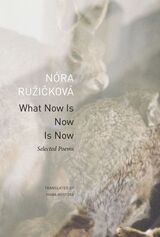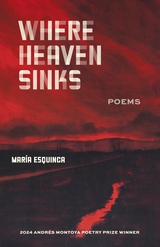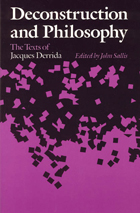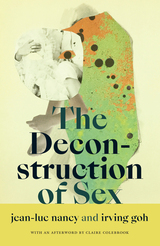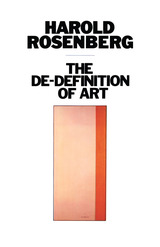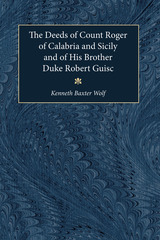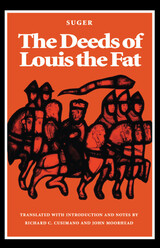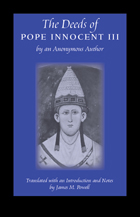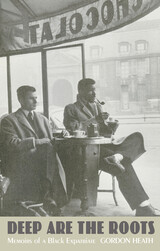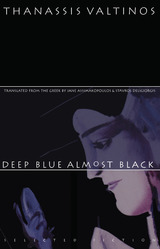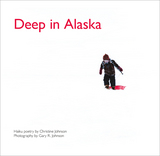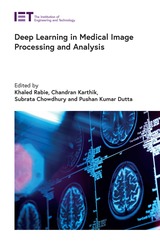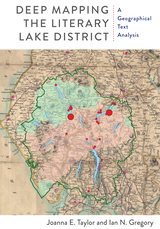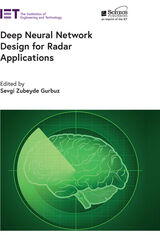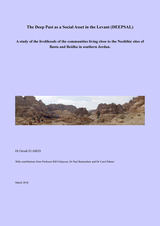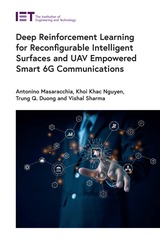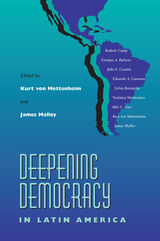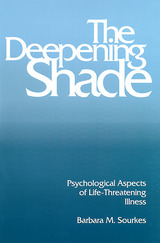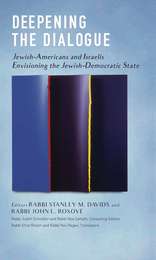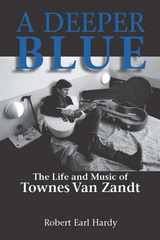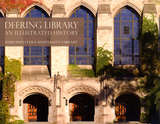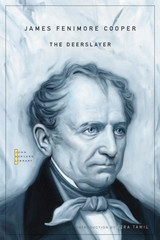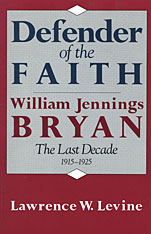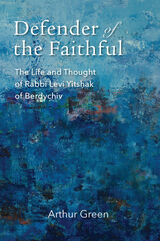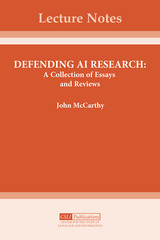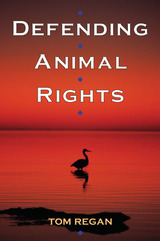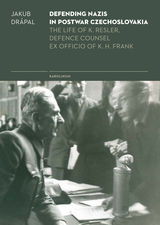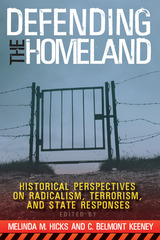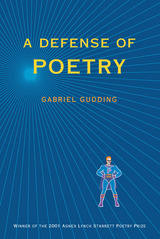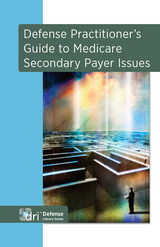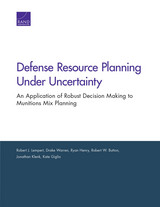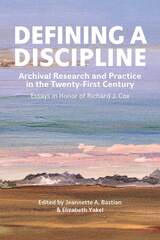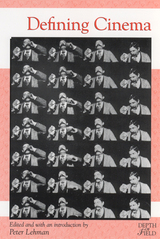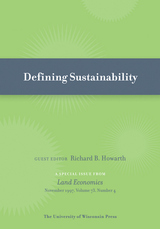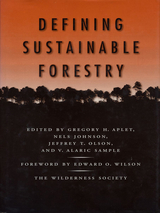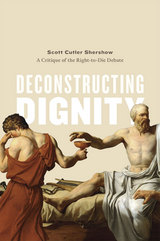 Deconstructing Dignity: A Critique of the Right-to-Die Debate
Scott Cutler Shershow
University of Chicago Press, 2013 The right-to-die debate has gone on for centuries, playing out most recently as a spectacle of protest surrounding figures such as Terry Schiavo. In Deconstructing Dignity, Scott Cutler Shershow offers a powerful new way of thinking about it philosophically. Focusing on the concepts of human dignity and the sanctity of life, he employs Derridean deconstruction to uncover self-contradictory and damaging assumptions that underlie both sides of the debate.
Shershow examines texts from Cicero’s De Officiis to Kant’s Groundwork of the Metaphysics of Morals to court decisions and religious declarations. Through them he reveals how arguments both supporting and denying the right to die undermine their own unconditional concepts of human dignity and the sanctity of life with a hidden conditional logic, one often tied to practical economic concerns and the scarcity or unequal distribution of medical resources. He goes on to examine the exceptional case of self-sacrifice, closing with a vision of a society—one whose conditions we are far from meeting—in which the debate can finally be resolved. A sophisticated analysis of a heated topic, Deconstructing Dignity is also a masterful example of deconstructionist methods at work.
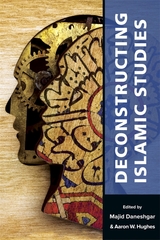 Deconstructing Islamic Studies
Majid Daneshgar
Harvard University Press, 2020 The study of Islam has historically been approached in two different ways: apologetical and polemical. The former focuses on the preservation and propagation of religious teachings, and the latter on the attempt to undermine the tradition. The dialectic between these two approaches continued into the Enlightenment, and the tension between them still exists today. What is new in the modern period, however, is the introduction of a third approach, the academic one, which ostensibly examines the tradition in diverse historical, religious, legal, intellectual, and philosophical contexts. Classical Islamic subjects (e.g., Qur’ān, ḥadīth, fiqh, tafsīr) are now studied using a combination of the apologetical, the polemical, and the academic approaches. Depending upon the historical period and the institutional context, these classical topics have been accepted (apologetical), have had their truth claims undermined (polemical), or have simply been taken for granted (academic).
This volume, comprising chapters by leading experts, deconstructs the ways in which classical Muslim scholarship has structured (and, indeed, continues to structure) the modern study of Islam. It explores how classical subjects have been approached traditionally, theologically, and secularly, in addition to examining some of the tensions inherent in these approaches.
 Deconstructing Morphology: Word Formation in Syntactic Theory
Rochelle Lieber
University of Chicago Press, 1992 One of the major contributions to theoretical linguistics during the twentieth century has been an advancement of our understanding that the information-bearing units which make up human language are organized on a hierarchy of levels. It has been an overarching goal of research since the 1930s to determine the precise nature of those levels and what principles guide interactions among them.
Linguists have typically posited phonological, morphological, and syntactic levels, each with its own distinct vocabulary and organizing principles, but in Deconstructing Morphology Rochelle Lieber persuasively challenges the existence of a morphological level of language. Her argument, that rules and vocabulary claimed to belong to the morphological level in fact belong to the levels of syntax and phonology, follows the work of Sproat, Toman, and others. Her study, however, is the first to draw jointly on Chomsky's Government-Binding Theory of syntax and on recent research in phonology.
Ranging broadly over data from many languages—including Tagalog, English, French, and Dutch—Deconstructing Morphology addresses key questions in current morphological and phonological research and provides an innovative view of the overall architecture of grammar.
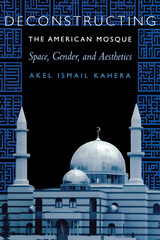 Deconstructing the American Mosque: Space, Gender, and Aesthetics
By Akel Ismail Kahera
University of Texas Press, 2002 From the avant-garde design of the Islamic Cultural Center in New York City to the simplicity of the Dar al-Islam Mosque in Abiquiu, New Mexico, the American mosque takes many forms of visual and architectural expression. The absence of a single, authoritative model and the plurality of design nuances reflect the heterogeneity of the American Muslim community itself, which embodies a whole spectrum of ethnic origins, traditions, and religious practices. In this book, Akel Ismail Kahera explores the history and theory of Muslim religious aesthetics in the United States since 1950. Using a notion of deconstruction based on the concepts of "jamal" (beauty), "subject," and "object" found in the writings of Ibn Arabi (d. 1240), he interprets the forms and meanings of several American mosques from across the country. His analysis contributes to three debates within the formulation of a Muslim aesthetics in North America—first, over the meaning, purpose, and function of visual religious expression; second, over the spatial and visual affinities between American and non-American mosques, including the Prophet's mosque at Madinah, Arabia; and third, over the relevance of culture, place, and identity to the making of contemporary religious expression in North America.
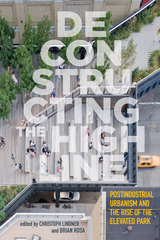 Deconstructing the High Line: Postindustrial Urbanism and the Rise of the Elevated Park
Lindner, Christoph
Rutgers University Press, 2017 2017 Choice Outstanding Academic Title
The High Line, an innovative promenade created on a disused elevated railway in Manhattan, is one of the world’s most iconic new urban landmarks. Since the opening of its first section in 2009, this unique greenway has exceeded all expectations in terms of attracting visitors, investment, and property development to Manhattan’s West Side. Frequently celebrated as a monument to community-led activism, adaptive re-use of urban infrastructure, and innovative ecological design, the High Line is being used as a model for numerous urban redevelopment plans proliferating worldwide.
Deconstructing the High Line is the first book to analyze the High Line from multiple perspectives, critically assessing its aesthetic, economic, ecological, symbolic, and social impacts. Including several essays by planners and architects directly involved in the High Line’s design, this volume also brings together a diverse range of scholars from the fields of urban studies, geography, anthropology, sociology, and cultural studies. Together, they offer insights into the project’s remarkable success, while also giving serious consideration to the critical charge that the High Line is “Disney World on the Hudson,” a project that has merely greened, sanitized, and gentrified an urban neighborhood while displacing longstanding residents and businesses.
Deconstructing the High Line is not just for New Yorkers, but for anyone interested in larger issues of public space, neoliberal redevelopment, creative design practice, and urban renewal.
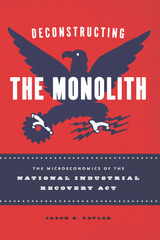 Deconstructing the Monolith: The Microeconomics of the National Industrial Recovery Act
Jason E. Taylor
University of Chicago Press, 2019 The National Industrial Recovery Act (NIRA) was enacted by Congress in June of 1933 to assist the nation’s recovery during the Great Depression. Its passage ushered in a unique experiment in US economic history: under the NIRA, the federal government explicitly supported, and in some cases enforced, alliances within industries. Antitrust laws were suspended, and companies were required to agree upon industry-level “codes of fair competition” that regulated wages and hours and could implement anti-competitive provisions such as those fixing prices, establishing production quotas, and imposing restrictions on new productive capacity.
The NIRA is generally viewed as a monolithic program, its dramatic and sweeping effects best measurable through a macroeconomic lens. In this pioneering book, however, Jason E. Taylor examines the act instead using microeconomic tools, probing the uneven implementation of the act’s codes and the radical heterogeneity of its impact across industries and time. Deconstructing the Monolith employs a mixture of archival and empirical research to enrich our understanding of how the program affected the behavior and well-being of workers and firms during the two years NIRA existed as well as in the period immediately following its demise.
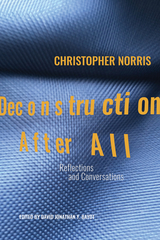 Deconstruction After All: Reflections and Conversations by Christopher Norris
Christopher Norris
Sussex Academic Press, 2022 This collection of interviews, reflections, and creative criticism presents Christopher Norriss vigorous polemics with Hayden White, Michel Foucault, Jean Baudrillard, Jean-Franois Lyotard, Thomas Kuhn, Emmanuel Levinas, Pierre Bourdieu, Richard Rorty, and Stanley Fish. Alongside Norriss uncompromising critiques there emerge passages of close and careful reading of Jacques Derridas texts, as he cites and reiterates Derridas philosophical contexts in the works of Immanuel Kant, Gaston Bachelard, and Georges Canguilhem, and in the current discursive fields of epistemology and philosophy of science. The book also offers a coda of essays on Frank Kermode, Terry Eagleton, and Terence Hawkes. This collection, prefaced with the authors own academic memoir, provides an accessible and provocative introduction to Norriss critical thought, and highlights the wide range of his interests and philosophical engagements.
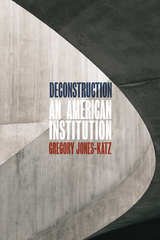 Deconstruction: An American Institution
Gregory Jones-Katz
University of Chicago Press, 2021 The basic story of the rise, reign, and fall of deconstruction as a literary and philosophical groundswell is well known among scholars. In this intellectual history, Gregory Jones-Katz aims to transform the broader understanding of a movement that has been frequently misunderstood, mischaracterized, and left for dead—even as its principles and influence transformed literary studies and a host of other fields in the humanities.
Deconstruction begins well before Jacques Derrida’s initial American presentation of his deconstructive work in a famed lecture at Johns Hopkins University in 1966 and continues through several decades of theoretic growth and tumult. While much of the subsequent story remains focused, inevitably, on Yale University and the personalities and curriculum that came to be lumped under the “Yale school” umbrella, Deconstruction makes clear how crucial feminism, queer theory, and gender studies also were to the lifeblood of this mode of thought. Ultimately, Jones-Katz shows that deconstruction in the United States—so often caricatured as a French infection—was truly an American phenomenon, rooted in our preexisting political and intellectual tensions, that eventually came to influence unexpected corners of scholarship, politics, and culture.
Deconstruction and Philosophy: The Texts of Jacques Derrida
Edited by John Sallis
University of Chicago Press, 1989 This volume represents the first sustained effort to relate Derrida's work to the Western philosophical tradition from Plato to Heidegger. Bringing together twelve essays by twelve leading Derridean philosophers and an important paper by Derrida previously unpublished in English, the collection retrieves the significance of deconstruction for philosophy.
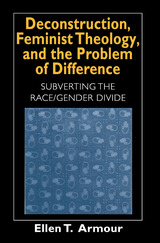 Deconstruction, Feminist Theology, and the Problem of Difference: Subverting the Race/Gender Divide
Ellen T. Armour
University of Chicago Press, 1999 The term "feminism" conjures up the promise of resistance to the various forms of oppression women face. But feminism's ability to fulfill this promise has been undermined by its failure to deal adequately with the difference that race makes for gender. In this book, Ellen T. Armour forges an alliance between deconstruction and feminist theology and theory by demonstrating deconstruction's usefulness in addressing feminism's trouble with race.
Armour shows how the writings of Jacques Derrida and Luce Irigaray can be used to uncover feminism's white presumptions so that race and gender can be thought of differently. In clear, concise terms she explores the possibilities and limitations for feminist theology of Derrida's conception of "woman" and Irigaray's "multiple woman," as well as Derrida's thinking on race and Irigaray's work on religion. Armour then points a way beyond the race/gender divide with the help of African-American theorists such as bell hooks, Hortense Spillers, and Patricia Hill Collins.
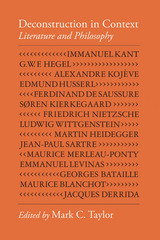 Deconstruction in Context: Literature and Philosophy
Edited by Mark C. Taylor
University of Chicago Press, 1986 "There is no rigorous and effective deconstruction without the faithful memory of philosophies and literatures, without the respectful and competent reading of texts of the past, as well as singular works of our own time. Deconstruction is also a certain thinking about tradition and context. Mark Taylor evokes this with great clarity in the course of a remarkable introduction. He reconstitutes a set of premises without which no deconstruction could have seen the light of day." – Jacques Derrida
"This invaluable philosophical sampler brings together many of the threads out of which deconstruction is woven. taylor's anthology does not make deconstruction easy; much more usefully, it provides a meticulous guide to the sources – and significance – of the difficulties. – Barbara E. Johnson
"The book will be of great value as a set of readings with authoritative explanation for all those interested in the current relations of literature and philosophy. It is the best book of its kind I know. – J. Hillis Miller, Yale University
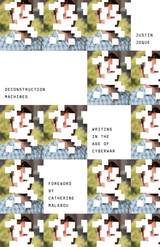 Deconstruction Machines: Writing in the Age of Cyberwar
Justin Joque
University of Minnesota Press, 2018 A bold new theory of cyberwar argues that militarized hacking is best understood as a form of deconstruction
From shadowy attempts to steal state secrets to the explosive destruction of Iranian centrifuges, cyberwar has been a vital part of statecraft for nearly thirty years. But although computer-based warfare has been with us for decades, it has changed dramatically since its emergence in the 1990s, and the pace of change is accelerating. In Deconstruction Machines, Justin Joque inquires into the fundamental nature of cyberwar through a detailed investigation of what happens at the crisis points when cybersecurity systems break down and reveal their internal contradictions. He concludes that cyberwar is best envisioned as a series of networks whose constantly shifting connections shape its very possibilities. He ultimately envisions cyberwar as a form of writing, advancing the innovative thesis that cyber attacks should be seen as a militarized form of deconstruction in which computer programs are systems that operate within the broader world of texts. Throughout, Joque addresses hot-button subjects such as technological social control and cyber-resistance entities like Anonymous and Wikileaks while also providing a rich, detailed history of cyberwar. Deconstruction Machines provides a necessary new interpretation of deconstruction and timely analysis of media, war, and technology.
The Deconstruction of Sex
Jean-Luc Nancy and Irving Goh
Duke University Press, 2021 In The Deconstruction of Sex, Jean-Luc Nancy and Irving Goh discuss how a deconstructive approach to sex helps us negotiate discourses about sex and foster a better understanding of how sex complicates our everyday existence in the age of #MeToo. Throughout their conversation, Nancy and Goh engage with topics ranging from relation, penetration, and subjection to touch, erotics, and jouissance. They show how despite its entrenchment in social norms and centrality to our being-in-the-world, sex lacks a clearly defined essence. At the same time, they point to the potentiality of literature to inscribe the senses of sex. In so doing, Nancy and Goh prompt us to reconsider our relations with ourselves and others through sex in more sensitive, respectful, and humble ways without bracketing the troubling aspects of sex.
 Deconstructive Variations: Music and Reason in Western Society
Rose Rosengard Subotnik
University of Minnesota Press, 1995 Deconstructive Variations was first published in 1995. Minnesota Archive Editions uses digital technology to make long-unavailable books once again accessible, and are published unaltered from the original University of Minnesota Press editions. Unique in its focus and its interdisciplinary reach, Rose Rosengard Subotnik's work is among the most original and challenging being done in American musicology. Her concerns are both formal and sociological, firmly linking music to social and cultural context and breaking down the barriers between music and life. Deconstructive Variations is a sequel to Subotnik's previous collection, Developing Variations. It expands and continues her achievement-the promotion of humanistic criticism as a significant activity in music scholarship and the portrayal of Western art music in relation to the social structures and cultural values of the society that created it. Bringing to her subject a vast range of philosophical, artistic, and historical knowledge, Subotnik applies the insights of Kant, Adorno, Bakhtin, and Derrida to major works of Mozart and Chopin. Each of these essays functions as an argument between two views: for and against the ideal of structural listening; Enlightenment and Romantic readings of The Magic Flute; high-modernist and postmodernist readings of Chopin's A-Major Prelude; and conceptions of reason put forward by Allan Bloom and Spike Lee. Rose Rosengard Subotnik is professor emerita in the department of music at Brown University, and is the author of Developing Variations: Style and Ideology in Western Music (Minnesota, 1991).
Decorated Book Papers: Being an Account of Their Designs and Fashions, Second Edition
Rosamond B. Loring
Harvard University Press First published in 1942, this book remains one of the standard works on its subject. Loring, a collector and maker of decorated papers, explores the extensive history and use of decorated papers in the book arts. Appendices are devoted to the art of marbling, the preparation of paste papers, and a listing of some early makers of decorated paper.
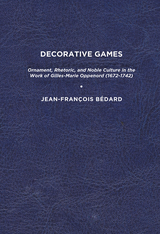 Decorative Games: Ornament, Rhetoric, and Noble Culture in the Work of Gilles-Marie Oppenord (1672-1742)
Jean-François Bédard
University of Delaware Press, 2011 This book features an extraordinary album of ornament designs by the French architect Gilles-Marie Oppenord (1672-1742). In charge of the buildings and grounds of Philippe, duke of Orléans, regent of France during the minority of Louis XV, Oppenord was at the center of the architectural practice of his time. As made evident by this album, his consummate draftsmanship, praised by his contemporaries and coveted by collectors, exceeded by far the practical demands usually required of architects. On a copy of the first French edition of Cesare Ripa’s Iconologia, published by Jean Baudoin in 1636 with engravings by Jacques de Bié, Oppenord drew vignettes, head and tail pieces, borders and other ornamental motifs. For the first time, this publication reproduces Oppenord’s album in its initial state. Today’s reassembled and rebound album of sixty sheets bears little resemblance to Oppenord’s original copy. A bibliographic analysis of the Ripa-Baudoin book, based on a copy kept at the Bibliothèque nationale de France, and confirmed by a previously unnoticed numbering by Oppenord, guided this first reconstitution. In lieu of a haphazard succession of sketches, it reveals Oppenord’s fascinating interplay between text, engraved and drawn images. Published by University of Delaware Press. Distributed worldwide by Rutgers University Press.
 Decrees of the Ecumenical Councils: From Nicaea I to Vatican II
Norman P. Tanner, SJ, English Language Editor. Giuseppe Alberigo et al., Original Language Editors
Georgetown University Press, 1990 This monumental two-volume publication brings together in the original languages and an English translation, all the decrees of all the ecumenical councils from Nicaea I to Vatican II. As such it represents an indispensable reference work for theologians and historians, as well as for anyone interested in the development of Christian thought and doctrine. Indeed, these decrees represent the authoritative distillation of Christian tradition which itself is bound together with scripture "in a close and reciprocal relationship" so that the two "form a single sacred deposit of the word of God, entrusted to the church." The original text is a reproduction of the brilliant edition by G. Alberigo and others of the decrees Conciliorum Oecumenicorum Decreta, which provides for the first time a reliable critical text for all the ecumenical councils. The English translation faces each page of the original text and is the first rendering into English of all these decrees taken together. The translators have used inclusive language throughout to emphasize the continuity of conciliar documents. The 2,528 total pages of these two volumes include all the authenticated texts and their English renderings as well as a preface and introduction by the oringinal languages editor, a foreword by the English language editor, a bibliography for each decree, various commentaries and explanatory notes, and ten comprehensive indices.
 Decrees of the Ecumenical Councils: Volume 1: Nicaea I to Lateran V
Georgetown University Press Volume one of this two-volume set includes the decrees of the ecumenical councils from Nicaea I to Lateran V. Indispensable to both Roman Catholic and Protestant historians and theologians, as well as anyone interested in the development of Christian thought and doctrine, this volume presents the decrees in their original language and in English translation. These decrees represent the authoritative distillation of Christian tradition which itself is bound together with scripture "in a close and reciprocal relationship" so that the two "form a single sacred deposit of the word of God, entrusted to the church." The original text is a reproduction of the brilliant edition by G. Alberigo and others of the decrees Conciliorum Oecumenicorum Decreta, which provides for the first time a reliable critical text for all the ecumenical councils. The English translation faces each page of the original text and is the first rendering into English of all these decrees taken together. The translators have used inclusive language throughout to emphasize the continuity of conciliar documents. This volume includes authenticated texts and their English renderings for the first eighteen councils as well as a preface and introduction by the original languages editor, a foreword by the English language editor, a bibliography for each decree, and various commentaries and explanatory notes.
 Decrees of the Ecumenical Councils: Volume 2: Trent to Vatican II
Georgetown University Press Volume two of this two-volume set includes the decrees of the ecumenical councils from Trent to Vatican II. Of particular interest to Roman Catholic historians and theologians, as well as anyone interested in the development of Christian thought and doctrine, this volume presents the decrees in their original language and in English translation. These decrees represent the authoritative distillation of Christian tradition which itself is bound together with scripture "in a close and reciprocal relationship" so that the two "form a single sacred deposit of the word of God, entrusted to the church." The original text is a reproduction of the brilliant edition by G. Alberigo and others of the decrees Conciliorum Oecumenicorum Decreta, which provides for the first time a reliable critical text for all the ecumenical councils. The English translation faces each page of the original text and is the first rendering into English of all these decrees taken together. The translators have used inclusive language throughout to emphasize the continuity of conciliar documents. This volume includes authenticated texts and their English renderings for the Councils of Trent, Vatican I, and Vatican II. The text of each council features an introduction, bibliography, and various commentaries and explanatory notes. Additionally, ten comprehensive indices allow for referencing across several categories such as Biblical verse, proper names, and chronology.
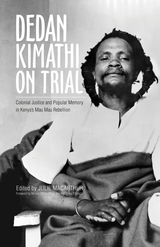 Dedan Kimathi on Trial: Colonial Justice and Popular Memory in Kenya’s Mau Mau Rebellion
Julie MacArthur
Ohio University Press, 2017 The transcript from this historic trial, long thought destroyed or hidden, unearths a piece of the British colonial archive at a critical point in the Mau Mau Rebellion. Its discovery and landmark publication unsettles an already contentious Kenyan history and its reverberations in the postcolonial present. Perhaps no figure embodied the ambiguities, colonial fears, and collective imaginations of Kenya’s decolonization era more than Dedan Kimathi, the self-proclaimed field marshal of the rebel forces that took to the forests to fight colonial rule in the 1950s. Kimathi personified many of the contradictions that the Mau Mau Rebellion represented: rebel statesman, literate peasant, modern traditionalist. His capture and trial in 1956, and subsequent execution, for many marked the end of the rebellion and turned Kimathi into a patriotic martyr. Here, the entire trial transcript is available for the first time. This critical edition also includes provocative contributions from leading Mau Mau scholars reflecting on the meaning of the rich documents offered here and the figure of Kimathi in a much wider field of historical and contemporary concerns. These include the nature of colonial justice; the moral arguments over rebellion, nationalism, and the end of empire; and the complexities of memory and memorialization in contemporary Kenya. Contributors: David Anderson, Simon Gikandi, Nicholas Githuku, Lotte Hughes, and John Lonsdale. Introductory note by Willy Mutunga.
The De-Definition of Art
Harold Rosenberg
University of Chicago Press, 1983 "Like the great German critic Walter Benjamin, Rosenberg is a master of dialectics whose sense of art is continuous with his sense of society, and (also like Benjamin) bears no taint of compromised, out-of-work radicalism. Instead, his radicalism is very much at work, enabling him to spot and skewer fallacies, false logic and the camouflaged nudity that is a large part of the art emperor's new wardrobe. [The De-definition of Art] detects with great sensitivity the forces that are deflecting and pressuring art in the direction of esthetic and moral nullity."—Jack Kroll, Newsweek
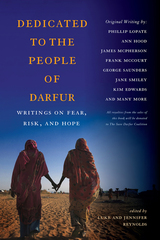 Dedicated to the People of Darfur: Writings on Fear, Risk, and Hope
Edited and with an Introduction by Luke Reynolds and Jennifer Reynolds
Rutgers University Press, 2009 Life's changes. They happen every day. Some large, some small. A few are very personal. Others impact the world. Dedicated to the People of Darfur: Writings on Fear, Risk, and Hope includes original and inspiring essays that celebrate the glories gained from taking risks, breaking down barriers, and overcoming any obstacles. Nobel and Pulitzer Prize winners, a gallery of O.Henry award recipients, and many best-selling authors come together to share personal and compelling challenges and experiences. From contemplations on past drug use to reflections on gun control, social justice, passion and its sacrifices, and adventures such as skydiving, mountain climbing, and golfing, the topics vary greatly. This kaleidoscopic anthology is a commentary on the lives of prominent literary artists and ordinary citizens who have made simple, yet powerful choices that provoked change in one's self and for humanityùmuch the same way that Luke and Jennifer Reynolds do by building this invaluable collection for readers and the world of human rights. Not too long ago, as struggling graduate students, Luke and Jennifer Reynolds conceived this uniquely themed volume as a way to raise funds to support ending the genocide in Darfur. Some people carry signs, others make speeches, many take action. What is most special about this book is that it extends beyond words and ideas, into a tangible effort to effect change. To this end, all royalties from the sales of Dedicated to the People of Darfur:Writings on Fear, Risk, and Hope will benefit The Save Darfur Coalition, an organization that seeks to end the genocide in Darfur, Sudan.
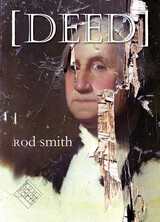 Deed
Rod Smith
University of Iowa Press, 2007 A deed is a governmental conveyance, a power asserted by the written, for, as William Carlos Williams wrote to Robert Creeley: “the government can never be more than the government of the words.” The question of ownership, of the words with which we define ourselves and each other, and of whose and what claims are legitimate is much at issue in Rod Smith’s Deed, a lyric, ambitious, rebellious work thoroughly grounded in the New American tradition of poets such as John Ashbery, Allen Ginsberg, and Charles Olson. At the entrance to this collection stands an abode in the form of a long poem, “The Good House,” a comfortable, at times soothingly humorous place that is also a site of conflict. In “The Spider Poems,” the mythic spider, the maker of the alphabet, is a ?gure of fun and revelation. The third section of the book presents a series of shorter poems chosen for their stylistic variety. Deed ends with a nod to two masters, as Smith turns Jack Spicer’s “Homage to Creeley” into a double homage with “Homage to Homage to Creeley.” The gesture of choosing what one brings into one’s house, what one decides to love, closes the book. Deed is about making as bequeathing, as celebration, and as impatience for the true democracy that is always yet to arrive. There is still joy inside and out, and by giving usDeed Rod Smith has captured that joy. In so doing he tells us where we as a people, a politik, and a poetic are going.
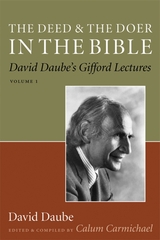 The Deed and the Doer in the Bible: David Daube's Gifford Lectures, Volume 1
David Daube
Templeton Press, 2008 David Daube (1909–1999) was a world-renowned biblical law scholar. He was a fellow at All Souls College at Oxford, an emeritus professor of law at Oxford, and an emeritus professor of law at the University of California, Berkeley. Scholars have hailed his essential research on Roman law, biblical law, Hebraic Law, and ethics throughout his life and today. Daube produced dozens of books and published over 150 articles in scholarly journals. Now, for the first time, his twenty Gifford Lectures, delivered in 1962 and 1964, will be available to the public. His first ten Gifford Lectures have been collected in The Deed and the Doer in the Bible: David Daube's Gifford Lectures, Volume 1. The theme of Daube's Gifford Lectures is law and wisdom in the Bible. His wide-ranging deliberations reveal how complicated and profound the biblical text is. He analyzes deeds described in the Bible and considers, for example, what causes people to act in a certain way, the role of intent, why unintended deeds are sometimes punishable, and how the origin of a deed is determined. His lectures are aimed at professionals in biblical criticism, biblical history, ethics, and the history of law concerning its roots in Old Testament traditions. Daube is a recognized master in these fields, and there are substantial applications to current ethical and legal issues.
A Deed to the Light
Poems by Jeanne Murray Walker
University of Illinois Press, 2004 In A Deed To the Light Jeanne Murray Walker asks probing questions about the depth of grief, about letting go, and about the possibility of faith. Her poems have been described by John Taylor, writing in Poetry, as "splendid, subtly erudite, uplifting, and funny."
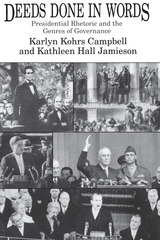 Deeds Done in Words: Presidential Rhetoric and the Genres of Governance
Karlyn Kohrs Campbell and Kathleen Hall Jamieson
University of Chicago Press, 1990 "Deeds Done in Words is an impressive piece of work. It is the first attempt to identify and assess the principal genres of rhetoric, and to interpret the panoply of those genres in terms of the needs of, and the needs for, ritual in American politics."—Jeffrey Tulis, author of The Rhetorical Presidency
"Deeds Done in Words is a thoughtful survey of how a democracy uses language to transact its business. Based on an enlivened understanding of genre theory and on numerous pieces of original criticism, Campbell and Jamieson vividly show how central public discourse has become the lifeblood of the American polity."—Roderick Hart, author of The Sound of Leadership
"The rhetoric that issues from the White House is becoming an ever more salient part of what the presidency means and does. This acute inquiry provides a great many insights into the forms, meanings, and functions of presidential discourse. It is an enlightening contribution to our understanding of American politics."—Murray Edelman, author of Constructing the Political Spectacle
The Deeds of Count Roger of Calabria and Sicily and of His Brother Duke Robert Guisc
Kenneth Baxter Wolf
University of Michigan Press, 2005 Geoffrey Malaterra's Deeds of Count Roger is the most important extant account of the Norman conquest of Muslim Silicy (1061-91). This volume includes a translation of the Latin original as well as an introduction, notes, and maps. The Deeds of Count Roger fills a gap in the primary literature pertaining to the earliest phase of Latin Christian expansion at the expense of Islam, since the Norman conquests in Sicily were more or less contemporary with the First Crusade and the beginnings of the Spanish Reconquista. The account also illustrates the complexity of medieval historical writing, with Malaterra on the one hand praising the Normans for their military achievements and on the other subtly criticising the "lust for domination" that inspired them. Kenneth Baxter Wolf is Professor of History at Pomona College.
The Deeds of Pope Innocent III
James M. Powell
Catholic University of America Press, 2004 The Deeds of Pope Innocent III, composed before 1210 by an anonymous member of the papal curia, provides a unique window into the activities, policies, and strategies of the papacy and the curia during one of the most important periods in the history of the medieval church.
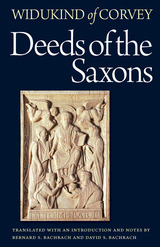 Deeds of the Saxons
Widukind of Corvey
Catholic University of America Press, 2014 PleWidukind, a monk at the prominent monastery of Corvey in Saxony during the middle third of the tenth century, is known to posterity through his Res gestae Saxonicae, an exceptionally rich account of the Saxon people and the reigns of the first two rulers of the Ottonian dynasty, Henry I (919-936) and Otto I (936-973). Widukind, likely of noble birth, received a thorough education in both biblical and classical texts. When writing the Gestae, Widukind also had available the extensive library at Corvey, with its large collection of ancient texts as well as numerous works from the eighth and ninth centuries. Widukind drew on these, and even more contemporary written sources to complement and inform orally transmitted information that he received from many sources including people closely associated with the Ottonian royal court. Widukind wrote the Res gestae from the 950s to the 970s, incorporating additional material as he obtained further information and as major new events took place in the German kingdom and beyond. After providing a historical background for the Saxon people Widukind devotes most of his attention to the political and military affairs of the German kingdom, concentrating heavily on affairs of the royal court. Widukind provides information that can be found in no other source. His close relationship with the royal court enabled him to provide an "insider's" view of the people and events that shaped the political and military history of the most powerful kingdom in Europe. As a consequence, the Res gestae is an indispensable account for the history of the German kingdom during the tenth century. Bernard S. Bachrach and David S. Bachrach provide an introduction to the text that contextualizes the author, his historical methods, and the information that he provides. They draw on a large number of other written sources of information, including both narrative works and the political, economic, social, and military affairs of the day, and provide an extensive apparatus of notes.
ase fill in marketing copy
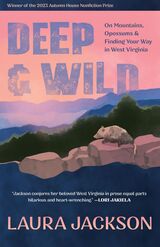 Deep & Wild: On Mountains, Opossums & Finding Your Way in West Virginia
Laura Jackson
Autumn House Press, 2024 Essays chronicling the beauty and awe of Appalachia through the eyes of a lifelong West Virginian.
Winner of the 2023 Autumn House Nonfiction Prize, Deep & Wild is the debut essay collection of Laura Jackson. Jackson, a lifelong West Virginian, employs her knowledge of and curiosity for the region to describe life in West Virginia as it actually is while dismantling stereotypes portrayed in popular media with humor and tenderness. Jackson works to describe what is special about her home, looking head-on at all the ways life in West Virginia may be wonderful and terrible, beautiful and ugly. Moving beyond all-too-common Appalachian stories of hardship and poverty, Jackson’s collection revels in joy, family, and nature.
Through her essays, Jackson invites readers to peer under creek rocks for crawfish, look a little more fondly at opossums, a road trip to an annual ramp festival, and learn why not to trust a GPS along West Virginia’s rugged roads. From her living room to Appalachian hollows, Jackson approaches the sublime, seeking truths in the removal of a stump from her backyard and in John Denver’s famous song, “Take Me Home, Country Roads.”
Deep Are the Roots: Memoirs of a Black Expatriate
Gordon Heath
University of Massachusetts Press, 1992 In these pages we meet a man, meet him as a child, an actor in training, an actor in performance. We meet a black man born in the United States in 1918 who fashioned a life for himself that kept him mostly abroad, mostly in Paris. Gordon Heath can be counted among such distinguished black expatriates as Ira Aldridge, Paul Robeson, Richard Wright, and James Baldwin. Their names have been written larger than his in the record books, but with the publication of his memoirs Gordon Heath moves from footnote status to deserved inclusion in the text itself.
Deep Blue Almost Black: Selected Fiction
Thanassis Valtinos
Northwestern University Press, 2000 With vivid language and powerful imagery, Thanassis Valtinos addresses the dislocation of three generations of Greeks facing profound political, social, and cultural change.
 Deep Blue Funk and Other Stories: Portraits of Teenage Parents
Daniel B. Frank
University of Chicago Press, 1983 Teenage pregnancy has attracted the attention of sociologists, psychologists, social workers, teachers, politicians, taxpayers, and parents. But in the midst of gathering statistics and designing programs, few people have stopped long enough to pay close attention to the young people themselves—to try to understand who they are and what they feel about their lives. In this book, Daniel B. Frank has drawn a series of sensitive and revealing portraits of adolescents confronted with the fact of parenthood.
For two years Frank worked as a tutor at Our Place, a Family Focus center for black teenagers in Evanston, Illinois, listening to them talk about their lives, their feelings, and their private dreams. The power of this volume lies in the voices of these young people describing the pleasures as well as the shocks and bruises of thier new role.
Hope, disillusion, fortitude, loneliness: these themes occur and recur as each story unfolds. Readers will be drawn into the lives of these teenagers and will emerge with fresh insight and understanding about teenage parenthood.
theirtheir
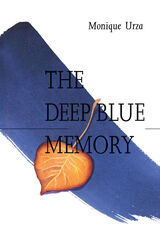 The Deep Blue Memory
Monique Laxalt Urza
University of Nevada Press, 1993 Monique Laxalt Urza's first novel is an intimate portrait of a second-generation Basque-American who struggles to reconcile her memories of the simplicity of the past with the reality of change in the present. The Deep Blue Memory is a fictionalized story of immigration told from the point of view of the granddaughter of Basque immigrant grandparents and daughter of a prominent first-generation family. The Deep Blue Memory addresses themes central to all of human existence. In particular, the book examines the eternal human search for identity that at the level of the first generation is forward-looking, but at the level of the grandchildren of immigrants, too often looks backward, clinging to images of a remembered past. The Deep Blue Memory treats the elements of time and knowledge, and of art and reality, as being intertwined. More than about any specific character, this book is about family—its make-up, its complexity, and its delicateness when resettled in America, the land of cataclysmic change.
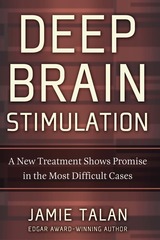 Deep Brain Stimulation: A New Treatment Shows Promise in the Most Difficult Cases
Jamie Talan
Dana Press, 2009
There are disorders that defy treatment with prescribed pharmaceuticals: a man’s hands shake so hard that he cannot hold anything; a woman is mired in severe inescapable depression. For these patients and others, an alternative is emerging: deep brain stimulation. In this fascinating and timely investigation, well-known science writer Jamie Talan explains a cutting-edge medical development that is surprising and impressing researchers around the world.
More than 40,000 people worldwide have undergone deep brain stimulation, which involves implanting electrodes in the brain that are connected to a device similar to a pacemaker. With compelling profiles of patients and an introduction to doctors and scientists who are pioneering the research, Talan describes the ways in which deep brain stimulation has produced promising results in the treatment of diseases such as Parkinson’s disease, depression, obsessive-compulsive disorder, and dystonia—as well as the ethical issues that have arisen in the course of this research.
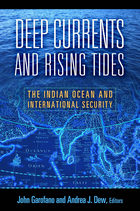 Deep Currents and Rising Tides: The Indian Ocean and International Security
John Garofano and Andrea J. Dew, Editors
Georgetown University Press, 2013 The Indian Ocean region has rapidly emerged as a hinge point in the changing global balance of power and the geographic nexus of economic and security issues with vital global consequences. The security of energy supplies, persistent poverty and its contribution to political extremism, piracy, and related threats to seaborne trade, competing nuclear powers, and possibly the scene of future clashes between rising great powers India and China—all are dangers in the waters or in the littoral states of the Indian Ocean region. This volume, one of the first attempts to treat the Indian Ocean Region in a coherent fashion, captures the spectrum of cooperation and competition in the Indian Ocean Region. Contributors discuss points of cooperation and competition in a region that stretches from East Africa, to Singapore, to Australia, and assess the regional interests of China, India, Pakistan, and the United States. Chapters review possible “red lines” for Chinese security in the region, India’s naval ambitions, Pakistan’s maritime security, and threats from non-state actors—terrorists, pirates, and criminal groups—who challenge security on the ocean for all states. This volume will interest academics, professionals, and researchers with interests in international relations, Asian security, and maritime studies.
Deep Design: Pathways To A Livable Future
David Wann
Island Press, 1996 In Deep Design, David Wann explores a new way of thinking about design, one that asks "What is our ultimate goal?" before the first step has even been taken. Designs that begin with such a question -- whether in products, buildings, technologies, or communities -- are sensitive to living systems, and can potentially accomplish their mission without the seemingly unavoidable side effects of pollution, erosion, congestion, and stress. Such "deep designs" meet the key criteria of renewability, recyclability, and nontoxicity. Often based on natural systems, they are easy to understand and implement, and provide more elegant approaches to getting the services and functions we need. Wann presents information gleaned from interviews with more than fifty innovative designers in a wide variety of fields, and describes numerous case studies that explain the concept and practice of deep design.
 Deep Dish Conversations: Voices of Social Change in Nashville
Jerome Moore
Vanderbilt University Press, 2023 What does it mean to be a Nashvillian? A Black Nashvillian? A white Nashvillian? What does it mean to be an organizer, an ally, an elected official, an agent for change? Deep Dish Conversations began as a running online interview series in which host Jerome Moore sits down over pizza with Nashville leaders and community members to talk about the past, present, and future of the city and what it means to live here. The result is honest conversation about racism, housing, policing, poverty, and more in a safe, brave, person-to-person environment that allows for disagreement.
This book is a curated collection of the most striking interviews from the first few seasons of the series, with a foreword by Dr. Sekou Franklin, an introduction by Moore, and contextual introductions to each interviewee. Figures like Judge Sheila Calloway, comedian Josh Black, anti-racism speaker Tim Wise, organizer Jorge Salles Diaz, and many more explore their wide-ranging perspectives on social change in a city in the midst of massive demographic and ideological shifts.
For anyone in any twenty-first-century city, Deep Dish Conversations offers a lot to think about—and a lot of ways to think about it.
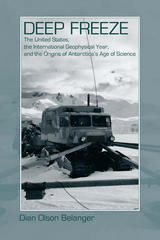 Deep Freeze: The United States, the International Geophysical Year, and the Origins of Antarctica's Age of Science
Dian Olson Belanger
University Press of Colorado, 2006 In Deep Freeze, Dian Olson Belanger tells the story of the pioneers who built viable communities, made vital scientific discoveries, and established Antarctica as a continent dedicated to peace and the pursuit of science, decades after the first explorers planted flags in the ice. In the tense 1950s, even as the world was locked in the Cold War, U.S. scientists, maintained by the Navy's Operation Deep Freeze, came together in Antarctica with counterparts from eleven other countries to participate in the International Geophysical Year (IGY). On July 1, 1957, they began systematic, simultaneous scientific observations of the south-polar ice and atmosphere. Their collaborative success over eighteen months inspired the Antarctic Treaty of 1959, which formalized their peaceful pursuit of scientific knowledge. Still building on the achievements of the individuals and distrustful nations thrown together by the IGY from mutually wary military, scientific, and political cultures, science prospers today and peace endures. The year 2007 marked the fiftieth anniversary of the IGY and the commencement of a new International Polar Year - a compelling moment to review what a singular enterprise accomplished in a troubled time. Belanger draws from interviews, diaries, memoirs, and official records to weave together the first thorough study of the dawn of Antarctica's scientific age. Deep Freeze offers absorbing reading for those who have ventured onto Antarctic ice and those who dream of it, as well as historians, scientists, and policy makers.
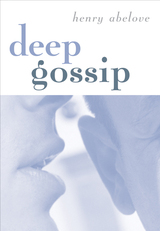 Deep Gossip
Henry Abelove
University of Minnesota Press, 2005 Henry Abelove, literary critic, astute historian, and pioneer in queer studies, offers interdisciplinary views on the connections between politics, culture, and sexuality. Deep Gossip addresses the willful misreading of Freud's views on homosexuality among American psychoanalysts; reconsiders sexual practice during England's eighteenth century; assesses the contemporary relevance of Thoreau's Walden, particularly to queer politics; and traces the emergence of a queer critique of previous approaches to lesbian and gay history. Abelove uncovers the origins of American studies as a scholarly discipline and evaluates the impact of literature - specifically the same-sex eroticism found in works by such writers as James Baldwin, Elizabeth Bishop, Paul Bowles, and Ned Rorem - on the gay liberation movement of the 1970s. The essays gathered in Deep Gossip confirm Henry Abelove's reputation as one of America's leading thinkers on the cultural politics of sexuality.
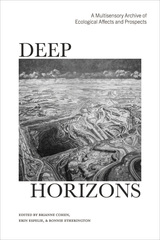 Deep Horizons: A Multisensory Archive of Ecological Affects and Prospects
Brianne Cohen
Amherst College Press, 2023 The specifics of ecological destruction often take a cruel turn, affecting those who can least resist its impacts and are least responsible for it. Deep Horizons: A Multisensory Archive of Ecological Affects and Prospects gathers contributions from multiple disciplines to investigate intersectional questions of how the changing planet affects specific peoples, communities, wildlife species, and ecosystems in varying and inequitable ways. A multisensory, artistic-archival supplement to the Mellon Sawyer Environmental Futures Project, the volume enriches current conversations bridging the environmental humanities and affect theory with insights from Native and Indigenous philosophies as well as by highlighting artistic practices that make legible the long-term durational effects of ecological catastrophe. Poems, nonfiction essays, sound-texts, photographs, and other artworks invite readers and viewers to consider the less visible losses and prospects of environmental transformation. Gathering contributions from multiple disciplines, this multimodal, multisensorial volume pushes the boundaries of scholarship with an experimental, born-digital format that offers a set of responses to collective traumas such as climate change, environmental destruction, and settler colonialism. The artists and authors honor the specificity of real historical and material injustices while also reflecting the eclectic nature of such assorted feelings, working through them in creative and border-crossing modes. With contributions from Robert Bailey, Nina Elder, Erin Espelie, Hock E Aye Vi Edgar Heap of Birds, Maya Livio, Erika Osborne, Craig Santos Perez, Kim Tallbear, Julianne Warren, and Kyle Powys White. "The compelling juxtaposition of poetry, music, video, audio, photography, printmaking, and traditional essays is among Deep Horizons' considerable strengths. I don’t know of any other project quite like this one. The subject is timely—indeed, urgent—and the innovative approach to archiving environmental change will interest scholars and artists in a range of disciplines and resonate with a wide audience." —Jennifer Ladino, University of Idaho
Deep in Alaska
Christine Johnson
University of Alaska Press, 2013 On a wintry white day, a small boy and a red sled step out for an adventure. As they slip through the snowy woods, their imagined journey takes place against real black-and-white photos of Eagle River, Alaska. Told entirely in haiku, this gentle book evokes both joy and calm. The black, red, and white color scheme is perfect for very young children, but readers of all ages will find the lyrical tone and captivating pictures a delightful invitation to explore the forest again and again.
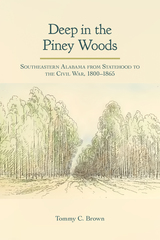 Deep in the Piney Woods: Southeastern Alabama from Statehood to the Civil War, 1800–1865
Tommy Craig Brown
University of Alabama Press, 2018 Beyond the backwoods—uncovering the Civil War legacy of Alabama’s forgotten frontier. Much of Alabama’s written history concentrates on the Tennessee Valley, the hill counties, and the Black Belt, while the piney woods of south central and southeastern Alabama, commonly known as the wiregrass region today, is one of the most understudied areas in Alabama history. Deep in the Piney Woods: Southeastern Alabama from Statehood to the Civil War, 1800–1865 offers a comprehensive and long overdue account of a historically rich region of the state, challenging many commonly held assumptions about the area’s formation and settlement, economy, politics, race relations, and its role in both the secession of the state and the Civil War. Historians routinely depict this part of the state as an isolated, economically backward wilderness filled with poor whites who showed little interest in supporting the Confederacy once civil war erupted in 1861. Tommy Craig Brown challenges those traditional interpretations, arguing instead that many white Alabamians in this territory participated in the market economy, supported slavery, favored secession, and supported the Confederate war effort for the bulk of the conflict, sending thousands of soldiers to fight in some of the bloodiest campaigns of the war. This thorough and expansive account of southeastern Alabama’s role in the Civil War also discusses its advocacy for state secession in January 1861; the effects of Confederate conscription on the home front; the economic devastation wrought on the area; and the participation of local military companies in key campaigns in both the eastern and western theaters, including Shiloh, the Peninsula Campaign, the Overland Campaign, Atlanta, and Franklin-Nashville. Brown argues that the lasting effects of the war on the region’s politics, identity, economy, and culture define it in ways that are still evident today.
Deep Learning in Medical Image Processing and Analysis
Khaled Rabie
The Institution of Engineering and Technology, 2023 Medical images, in various formats, are used by clinicians to identify abnormalities or markers associated with certain conditions, such as cancers, diseases, abnormalities or other adverse health conditions. Deep learning algorithms use vast volumes of data to train the computer to recognise certain features in the images that are associated with the disease or condition that you wish to identify.
Deep Mapping the Literary Lake District: A Geographical Text Analysis
Joanna E. Taylor
Bucknell University Press, 2022 England’s famed Lake District—best known as the place of inspiration for the Wordsworths, Samuel Taylor Coleridge, and other Romantic-era writers—is the locus of this pioneering study, which implements and critiques a new approach to literary analysis in the digital age. Deploying innovative methods from literary studies, corpus linguistics, historical geography, and geographical information science, Deep Mapping the Literary Lake District combines close readings of a body of writing about the region from 1622-1900 with distant approaches to textual analysis. This path-breaking volume exemplifies interdisciplinarity, demonstrating how digital humanities methodologies and geospatial tools can enhance our appreciation of a region whose topography has been long recognized as fundamental to the shape of the poetry and prose produced within it.
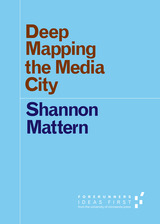 Deep Mapping the Media City
Shannon Mattern
University of Minnesota Press, 2015 Going beyond current scholarship on the “media city” and the “smart city,” Shannon Mattern argues that our global cities have been mediated and intelligent for millennia. Deep Mapping the Media City advocates for urban media archaeology, a multisensory approach to investigating the material history of networked cities. Mattern explores the material assemblages and infrastructures that have shaped the media city by taking archaeology literally—using techniques like excavation and mapping to discover the modern city’s roots in time. Forerunners: Ideas First is a thought-in-process series of breakthrough digital publications. Written between fresh ideas and finished books, Forerunners draws on scholarly work initiated in notable blogs, social media, conference plenaries, journal articles, and the synergy of academic exchange. This is gray literature publishing: where intense thinking, change, and speculation take place in scholarship.
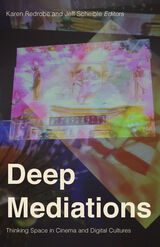 Deep Mediations: Thinking Space in Cinema and Digital Cultures
Karen Redrobe
University of Minnesota Press, 2021 The preoccupation with “depth” and its relevance to cinema and media studies For decades the concept of depth has been central to critical thinking in numerous humanities-based disciplines, legitimizing certain modes of inquiry over others. Deep Mediations examines why and how this is, as scholars today navigate the legacy of depth models of thought and vision, particularly in light of the “surface turn” and as these models impinge on the realms of cinema and media studies. The collection’s eighteen essays seek to understand the decisive but evolving fixation on depth by considering the term’s use across a range of conversations as well as its status in relation to critical methodologies and the current mediascape. Engaging contemporary debates about new computing technologies, the environment, history, identity, affect, audio/visual culture, and the limits and politics of human perception, Deep Mediations is a timely interrogation of depth’s ongoing importance within the humanities. Contributors: Laurel Ahnert; Taylor Arnold, U of Richmond; Erika Balsom, King’s College London; Brooke Belisle, Stony Brook University; Jinhee Choi, King’s College London; Jennifer Fay, Vanderbilt U; Lisa Han, UC Santa Barbara; Jean Ma, Stanford U; Shaka McGlotten, Purchase College-SUNY; Susanna Paasonen, U of Turku, Finland; Jussi Parikka, U of Southampton; Alessandra Raengo, Georgia State U; Pooja Rangan, Amherst College; Katherine Rochester, VIA Art Fund in Boston; Karl Schoonover, University of Warwick (UK); Jordan Schonig, Michigan State U; John Paul Stadler, North Carolina State U; Nicole Starosielski, New York U; Lauren Tilton, U of Richmond.
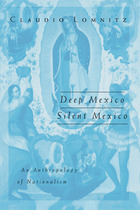 Deep Mexico, Silent Mexico: An Anthropology of Nationalism
Claudio Lomnitz
University of Minnesota Press, 2001 In Mexico, as elsewhere, the national space, that network of places where the people interact with state institutions, is constantly changing. How it does so, how it develops, is a historical process-a process that Claudio Lomnitz exposes and investigates in this book, which develops a distinct view of the cultural politics of nation building in Mexico. Lomnitz highlights the varied, evolving, and often conflicting efforts that have been made by Mexicans over the past two centuries to imagine, organize, represent, and know their country, its relations with the wider world, and its internal differences and inequalities. Firmly based on particulars and committed to the specificity of such thinking, this book also has broad implications for how a theoretically informed history can and should be done.
An exploration of Mexican national space by way of an analysis of nationalism, the public sphere, and knowledge production, Deep Mexico, Silent Mexico brings an original perspective to the dynamics of national cultural production on the periphery. Its blending of theoretical innovation, historical inquiry, and critical engagement provides a new model for the writing of history and anthropology in contemporary Mexico and beyond. Public Worlds Series, volume 9
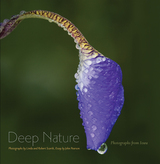 Deep Nature: Photographs from Iowa
Linda Scarth
University of Iowa Press, 2009 Photographers Linda and Robert Scarth have an incredible eye for that magic moment when small becomes beautiful. Matched with patience and skill, their eye for magic produces dazzling images of Iowa nature up close. Revealing the miniature beauties hidden among the patches of prairie, woodland, and wetland that remain in Iowa’s sadly overdeveloped landscape, the seventy-five color photographs in Deep Nature give us a breathtaking cross section of the state’s smallest inhabitants.
The Scarths’ close-up images of showy orchis and northern monkshood, great spangled fritillary and painted lady, red-breasted nuthatch and eastern wood-pewee, ornate box turtle and gray treefrog, big bluestem and cotton-grass, and many other natural wonders look more like paintings than photographs. Beginning with an iridescent fly hovering over a neon-purple fringed gentian and ending with their iconic image of coneflowers refracted in dewdrops, they have created a sparkling jewelbox of images that will make us look at the small world around us with renewed appreciation.
Attending to the small things in the fabric of nature is the Scarths’ source of artistic inspiration. Taking Walt Whitman’s “every leaf is a miracle” as their beginning, they celebrate not only each leaf but each feather, insect, dewdrop, flower, lichen, and intricate organism in the evolving web of life.
Deep Neural Network Design for Radar Applications
Sevgi Zubeyde Gurbuz
The Institution of Engineering and Technology, 2021 Novel deep learning approaches are achieving state-of-the-art accuracy in the area of radar target recognition, enabling applications beyond the scope of human-level performance. This book provides an introduction to the unique aspects of machine learning for radar signal processing that any scientist or engineer seeking to apply these technologies ought to be aware of.
The Deep Past as a Social Asset in the Levant (DEEPSAL)
O. El Abed
Council for British Research in the Levant, 2018 The aim of the Deep Past as a Social Asset in the Levant (DEEPSAL) project was to understand how local cultural heritage can contribute to people’s lives today. The research studied two villages in south Jordan — Beidha and Basta — which contain highly significant Neolithic archaeological sites, representing a period of huge change in human history 9000 years ago, when people first began farming and living in large settled communities. The historic impact of this period is fundamental to how we live today, and the process of settling down, and domesticating barley and goats, has an obvious potential resonance with the lives of the modern communities in the region. This study tries to understand how this ‘deep past’ can be an asset to the contemporary lives of the communities who live around the sites today.
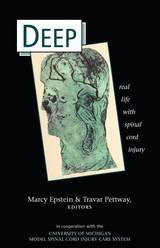 Deep: Real Life with Spinal Cord Injury
Marcy Epstein and Travar Pettway, Editors
University of Michigan Press, 2010 "This project fits into the larger picture of excellence that we wish to accomplish in all dimensions of our health system: groundbreaking and dedicated research, compassionate clinical care, progressive education, and a welcoming environment that includes community with people with disabilities. In Deep, the writers and editors of this book realize this mission with accuracy and clarity."
---Denise G. Tate, Director of Research at the University of Michigan Model Spinal Cord Injury Care System People with spinal cord injuries experience life beyond their medical and rehabilitative journeys, but these stories are rarely told. Deep: Real Life with Spinal Cord Injury includes the stories of ten men and women whose lives have been transformed by spinal cord injury. Each essay challenges the stereotypes and misconceptions about SCI---with topics ranging from faith to humility to sex and manhood---offering a multitude of voices that weave together to create a better understanding of the diversity of disability and the uniqueness of those individuals whose lives are changed but not defined by their injuries. Life with SCI can be traumatic and ecstatic, uncharted and thrilling, but it always entails a journey beyond previous expectations. This volume captures this sea change, exploring the profound depths of SCI experience.
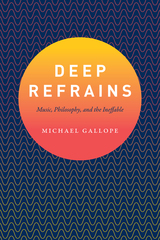 Deep Refrains: Music, Philosophy, and the Ineffable
Michael Gallope
University of Chicago Press, 2017 We often say that music is ineffable, that it does not refer to anything outside of itself. But if music, in all its sensuous flux, does not mean anything in particular, might it still have a special kind of philosophical significance?
In Deep Refrains, Michael Gallope draws together the writings of Arthur Schopenhauer, Friedrich Nietzsche, Ernst Bloch, Theodor Adorno, Vladimir Jankélévitch, Gilles Deleuze, and Félix Guattari in order to revisit the age-old question of music’s ineffability from a modern perspective. For these nineteenth- and twentieth-century European philosophers, music’s ineffability is a complex phenomenon that engenders an intellectually productive sense of perplexity. Through careful examination of their historical contexts and philosophical orientations, close attention to their use of language, and new interpretations of musical compositions that proved influential for their work, Deep Refrains forges the first panoptic view of their writings on music. Gallope concludes that music’s ineffability is neither a conservative phenomenon nor a pious call to silence. Instead, these philosophers ask us to think through the ways in which music’s stunning force might address, in an ethical fashion, intricate philosophical questions specific to the modern world.
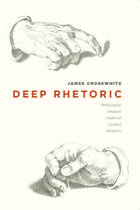 Deep Rhetoric: Philosophy, Reason, Violence, Justice, Wisdom
James Crosswhite
University of Chicago Press, 2013 “Rhetoric is the counterpart of logic,” claimed Aristotle. “Rhetoric is the first part of logic rightly understood,” Martin Heidegger concurred. “Rhetoric is the universal form of human communication,” opined Hans-Georg Gadamer. But in Deep Rhetoric, James Crosswhite offers a groundbreaking new conception of rhetoric, one that builds a definitive case for an understanding of the discipline as a philosophical enterprise beyond basic argumentation and is fully conversant with the advances of the New Rhetoric of Chaïm Perelman and Lucie Olbrechts-Tyteca.
Chapter by chapter, Deep Rhetoric develops an understanding of rhetoric not only in its philosophical dimension but also as a means of guiding and conducting conflicts, achieving justice, and understanding the human condition. Along the way, Crosswhite restores the traditional dignity and importance of the discipline and illuminates the twentieth-century resurgence of rhetoric among philosophers, as well as the role that rhetoric can play in future discussions of ontology, epistemology, and ethics. At a time when the fields of philosophy and rhetoric have diverged, Crosswhite returns them to their common moorings and shows us an invigorating new way forward.
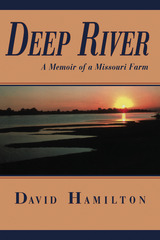 Deep River: A Memoir of a Missouri Farm
David Hamilton
University of Missouri Press, 2014 Deep River uncovers the layers of history—both personal and regional—that have accumulated on a river-bottom farm in west-central Missouri. This land was part of a late frontier, passed over, then developed through the middle of the last century as the author's father and uncle cleared a portion of it and established their farm. Hamilton traces the generations of Native Americans, frontiersmen, settlers, and farmers who lived on and alongside the bottomland over the past two centuries. It was a region fought over by Union militia and Confederate bushwhackers, as well as by their respective armies; an area that invited speculation and the establishment of several small towns, both before and after the Civil War; land on which the Missouri Indians made their long last stand, less as a military force than as a settlement and civilization; land that attracted French explorers, the first Europeans to encounter the Missouris and their relatives, the Ioways, Otoes, and Osage, a century before Lewis and Clark. It is land with a long history of occupation and use, extending millennia before the Missouris. Most recently it was briefly and intensively receptive to farming before being restored in large part as state-managed wetlands. Deep River is composed of four sections, each exploring aspects of the farm and its neighborhood. While the family story remains central to each, slavery and the Civil War in the nineteenth century and Native American history in the centuries before that become major themes as well. The resulting portrait is both personal memoir and informal history, brought up from layers of time, the compound of which forms an emblematic American story.
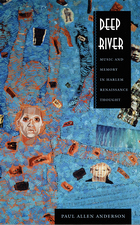 Deep River: Music and Memory in Harlem Renaissance Thought
Paul Allen Anderson
Duke University Press, 2001 “The American Negro,” Arthur Schomburg wrote in 1925, “must remake his past in order to make his future.” Many Harlem Renaissance figures agreed that reframing the black folk inheritance could play a major role in imagining a new future of racial equality and artistic freedom. In Deep River Paul Allen Anderson focuses on the role of African American folk music in the Renaissance aesthetic and in political debates about racial performance, social memory, and national identity.
Deep River elucidates how spirituals, African American concert music, the blues, and jazz became symbolic sites of social memory and anticipation during the Harlem Renaissance. Anderson traces the roots of this period’s debates about music to the American and European tours of the Fisk Jubilee Singers in the 1870s and to W. E. B. Du Bois’s influential writings at the turn of the century about folk culture and its bearing on racial progress and national identity. He details how musical idioms spoke to contrasting visions of New Negro art, folk authenticity, and modernist cosmopolitanism in the works of Du Bois, Alain Locke, Zora Neale Hurston, Langston Hughes, Jean Toomer, Sterling Brown, Roland Hayes, Paul Robeson, Carl Van Vechten, and others. In addition to revisiting the place of music in the culture wars of the 1920s, Deep River provides fresh perspectives on the aesthetics of race and the politics of music in Popular Front and Swing Era music criticism, African American critical theory, and contemporary musicology.
Deep River offers a sophisticated historical account of American racial ideologies and their function in music criticism and modernist thought. It will interest general readers as well as students of African American studies, American studies, intellectual history, musicology, and literature.
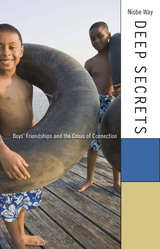 Deep Secrets: Boys’ Friendships and the Crisis of Connection
Niobe Way
Harvard University Press, 2013 “Boys are emotionally illiterate and don’t want intimate friendships.” In this empirically grounded challenge to our stereotypes about boys and men, Niobe Way reveals the intense intimacy among teenage boys especially during early and middle adolescence. Boys not only share their deepest secrets and feelings with their closest male friends, they claim that without them they would go “wacko.” Yet as boys become men, they become distrustful, lose these friendships, and feel isolated and alone.
Drawing from hundreds of interviews conducted throughout adolescence with black, Latino, white, and Asian American boys, Deep Secrets reveals the ways in which we have been telling ourselves a false story about boys, friendships, and human nature. Boys’ descriptions of their male friendships sound more like “something out of Love Story than Lord of the Flies.” Yet in late adolescence, boys feel they have to “man up” by becoming stoic and independent. Vulnerable emotions and intimate friendships are for girls and gay men. “No homo” becomes their mantra.
These findings are alarming, given what we know about links between friendships and health, and even longevity. Rather than a “boy crisis,” Way argues that boys are experiencing a “crisis of connection” because they live in a culture where human needs and capacities are given a sex (female) and a sexuality (gay), and thus discouraged for those who are neither. Way argues that the solution lies with exposing the inaccuracies of our gender stereotypes and fostering these critical relationships and fundamental human skills.
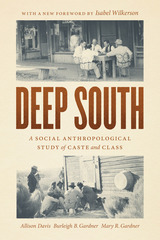 Deep South: A Social Anthropological Study of Caste and Class
Allison Davis, Burleigh B. Gardner, and Mary R. Gardner
University of Chicago Press, 2022 As seen in the movie Origins, a classic examination of the lived realities of American racism, now with a new foreword from Pulitzer Prize winner Isabel Wilkerson.
First published in 1941, Deep South is a landmark work of anthropology, documenting in startling and nuanced detail the everyday realities of American racism. Living undercover in Depression-era Mississippi—not revealing their scholarly project or even their association with one another—groundbreaking Black scholar Allison Davis and his White co-authors, Burleigh and Mary Gardner, delivered an unprecedented examination of how race shaped nearly every aspect of twentieth-century life in the United States. Their analysis notably revealed the importance of caste and class to Black and White worldviews, and they anatomized the many ways those views are constructed, solidified, and reinforced.
This reissue of the 1965 abridged edition, with a new foreword from Pulitzer Prize winner Isabel Wilkerson—who acknowledges the book’s profound importance to her own work—proves that Deep South remains as relevant as ever, a crucial work on the concept of caste and how it continues to inform the myriad varieties of American inequality.
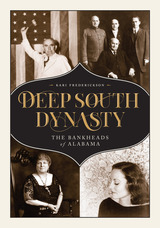 Deep South Dynasty: The Bankheads of Alabama
Kari Frederickson
University of Alabama Press, 2022 Winner of the Gulf South Historical Association's Michael V. R. Thomason Book Award
The sweeping story of an ambitious and once-powerful southern family
From Reconstruction through the end of World War II, the Bankheads served as the principal architects of the political, economic, and cultural framework of Alabama and the greater South. As a family, they were instrumental in fashioning the New South and the twentieth century American political economy, but now the Bankhead name is largely associated only with place names.
Deep South Dynasty: The Bankheads of Alabama is a deeply researched epic family biography that reflects the complicated and evolving world inhabited by three generations of the extremely accomplished—if problematic—Bankhead family of northwest Alabama. Kari Frederickson’s expertly crafted account traces the careers of five members of the family—John Hollis Bankhead; his sons, John Hollis Bankhead Jr. and William Brockman Bankhead; his daughter, Marie Bankhead Owen; and his granddaughter, Tallulah Brockman Bankhead.
A Confederate veteran and son of a slaveholder, John Hollis Bankhead held political office almost continuously from 1865 until his death in 1920, first in state-level positions and ultimately in Congress–in the House then in the Senate–for thirty-three years. Two of his three sons, John Jr. and William, followed in their father’s political footsteps. John Jr., a successful corporate attorney, was elected to the state legislature and then to the US Senate in 1930; William was elected to the House of Representatives in 1916 and chosen Speaker of the House in 1936. Together, father and sons played key roles in crafting and maintaining a conservative political culture, legal code, and economic system that facilitated economic opportunities for cotton farmers, coal barons, and emerging industries in Alabama and across the South while perpetuating White supremacy. Daughter Marie Bankhead Owen extended the family’s cultural power during her thirty-five-year tenure as director of the Alabama Department of Archives and History. From this position and through her work with groups like the United Daughters of the Confederacy, she embraced and disseminated a historical narrative steeped in Lost Cause mythology that validated the power and privilege of White elites and naturalized the second-class status of African Americans. William’s daughter, actress Tallulah Bankhead, benefited from her family’s rich political bloodlines and in turn lent them a touch of glamour and made the Bankheads modern. Frederickson’s meticulously researched examination of this once-powerful but now largely forgotten southern family is a sweeping and complex story of the region and its relationship with the wider world over the course of eight decades, from the wreckage of the Civil War to the dawn of the nuclear age.
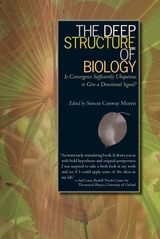 The Deep Structure of Biology: Is Convergence Sufficiently Ubiquitous to Give a Directional Signal
Simon Conway Morris
Templeton Press, 2008 Twelve renowned scientists and theologians offer penetrating insights into the evolution dialogue in The Deep Structure of Biology. Each considers whether the orthodox evolution model is sufficient and offers their perspective on evolution and biology. Essays include: - Chance and Necessity in Evolution
- Green Plants as Intelligent Organisms
- Canny Corvoids and Political Primates: A Case for Convergent Evolution in Intelligence
- Social and Cultural Evolution in the Ocean: Convergences and Contrasts with Terrestrial Systems
- Purpose in Nature: On the Possibility of a Theology of Evolution
Editor Simon Conway Morris provides the introduction, an overview of the issues, and an essay on evolution and convergence. Other contributors are Richard Lenski, George McGhee, Karl Niklas, Anthony Trewavas, Nigel Franks, Nicola Clayton, Nathan Emery, HalWhitehead, Robert Foley, Michael Ruse, Celia Deane-Drummond, and John Haught. The discussion of biology and evolution in these essays broadens the scope of the traditional evolution discussion as it aims to stimulate the development of other research programs. Scholars in the science and religion field will find this book a valuable resource.
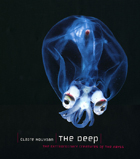 The Deep: The Extraordinary Creatures of the Abyss
Claire Nouvian
University of Chicago Press, 2007 On dry land, most organisms are confined to the surface, or at most to altitudes of a hundred meters—the height of the tallest trees. In the oceans, though, living space has both vertical and horizontal dimensions: with an average depth of 3800 meters, the oceans offer 99% of the space on Earth where life can develop. And the deep sea, which has been immersed in total darkness since the dawn of time, occupies 85% of ocean space, forming the planet’s largest habitat. Yet these depths abound with mystery. The deep sea is mostly uncharted—only about 5 percent of the seafloor has been mapped with any reasonable degree of detail—and we know very little about the creatures that call it home. Current estimates about the number of species yet to be found vary between ten and thirty million. The deep sea no longer has anything to prove; it is without doubt Earth’s largest reservoir of life. Combining the latest scientific discoveries with astonishing color imagery, The Deep takes readers on a voyage into the darkest realms of the ocean. Revealing nature’s oddest and most mesmerizing creatures in crystalline detail, The Deep features more than two hundred color photographs of terrifying sea monsters, living fossils, and ethereal bioluminescent creatures, some photographed here for the very first time. Accompanying these breathtaking photographs are contributions from some of the world’s most respected researchers that examine the biology of deep-sea organisms, the ecology of deep-sea habitats, and the history of deep-sea exploration. An unforgettable visual and scientific tour of the teeming abyss, The Deep celebrates the incredible diversity of life on Earth and will captivate anyone intrigued by the unseen—and unimaginable—creatures of the deep sea.
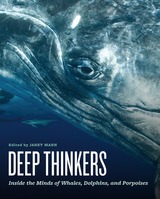 Deep Thinkers: Inside the Minds of Whales, Dolphins, and Porpoises
Edited by Janet Mann
University of Chicago Press, 2017 Humans aside, dolphins, whales, and porpoises are often considered to be the smartest creatures on Earth. Science and nature buffs are drawn to stories of their use of tools, their self-recognition, their beautiful and complex songs, and their intricate societies. But how do we know what we know, and what does it mean? In Deep Thinkers, renowned cetacean biologist Janet Mann gathers a gam of the world’s leading whale and dolphin researchers—including Luke Rendell, Hal Whitehead, and many more—to illuminate these vital questions, exploring the astounding capacities of cetacean brains.
Diving into our current understanding of and dynamic research on dolphin and whale cognition, communication, and culture, Deep Thinkers reveals how incredibly sophisticated these mammals are—and how much we can learn about other animal minds by studying cetacean behavior. Through a combination of fascinating text and more than 150 beautiful and informative illustrations, chapters compare the intelligence markers of cetaceans with those of birds, bats, and primates, asking how we might properly define intelligence in nonhumans. As all-encompassing and profound as the seas in which these deep cetacean cultures have evolved, Deep Thinkers is an awesome and inspiring journey into the fathoms—a reminder of what we gain through their close study, and of what we lose when the great minds of the sea disappear.
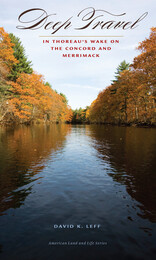 Deep Travel: In Thoreau's Wake on the Concord and Merrimack
David K. Leff
University of Iowa Press, 2009 In the hot summer of 2004, David Leff floated away from the routine of daily life just as Henry David Thoreau and his brother had done in their own small boat in 1839. Fortified with Thoreau’s observations as revealed in A Week on the Concord and Merrimack Rivers, Leff brought his own concept of mindful deep travel to these same New England waterways. His first-person narrative uses his ecological way of looking, of going deep rather than far, to show that our outward journeys are inseparable from our inward ones.
How we see depends on where we are in our lives and with whom we travel. Leff chose his companions wisely. In consecutive journeys his neighbor and friend Alan, a veteran city planner; his son Josh, an energetic eleven-year-old; and his sweetheart Pamela, a compassionate professional caregiver, added their perspectives to Leff’s own experiences as a government official in natural resources policy. Not so much sight seeing as sight seeking, together they explored a geography of the imagination as well as the rich natural and human histories of the rivers and their communities.
The heightened awareness of deep travel demands that we immerse ourselves fully in places and realize that they exist in time as well as space. Its mindfulness enriches the experience and makes the voyager worthy of the journey. Leff’s intriguing, contemplative deep travel along these historic rivers presents a methodology for exploration that will enrich any trip.
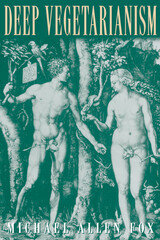 Deep Vegetarianism
Michael Fox
Temple University Press, 1999 Challenging the basic assumptions of a meat-eating society, Deep Vegetarianism is a spirited and compelling defense of a vegetarian lifestyle. Considering all of the major arguments both for and against vegetarianism and the habits of meat-eaters, vegetarians, and vegans alike, Michael Allen Fox addresses vegetarianism's cultural, historical, and philosophical background; details vegetarianism's impact on one's living and thinking; and relates vegetarianism to classical and recent defenses of the moral status of animals.
Demonstrating how a vegetarian diet is related to our awareness of the world and our ethical outlook on life, Fox looks at the different kinds of vegetarian commitments people make and their reasons for making them. In chapters that address such issues as the experiences, emotions, and grounds that are part of choosing vegetarianism, Fox discusses not only good health, animal suffering, and the environmental impacts of meat production, but such issues as the meaning of food, world hunger, religion and spirituality, and, significantly, the links share between vegetarianism and other human rights movements and ideologies, particularly feminism. In an extensive chapter that addresses arguments made by advocates of meat-eating, Fox speaks to claims of humans as natural carnivores, animals as replaceable, and vegetarians as anti-feminist. He also addresses arguments surrounding the eating habits of indigenous peoples, eating free-range animals, and carnivorous behavior among animals. The most complete examination of the vegetarian outlook to date, Deep Vegetarianism reveals the broad range of philosophical views that contribute to such a choice. It recognizes, and calls for, a conscious awareness of -- and an individual responsibility to -- the issues that exist in the moral, political, and social spheres of our existence.
With its lively and controversial discussion, Deep Vegetarianism promises to appeal to anyone looking to explore the relationship between dietary choice, lifestyle, the treatment of animals and the environment, and personal ethical responsibility. It will also be particularly useful for students and teachers of moral philosophy, ethics, religion, comparative cultures, ecology, and feminism.
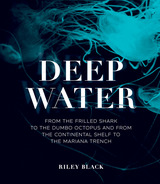 Deep Water: From the Frilled Shark to the Dumbo Octopus and from the Continental Shelf to the Mariana Trench
Riley Black
University of Chicago Press, 2023 From celebrated science writer Riley Black, a beautifully illustrated, compelling deep dive into the life story of the abyss, its ancient creatures, and the scientists and submersibles that have documented them.
What lies beneath the surface of the ocean has mystified humankind for millennia. Today, we have explored more of the surface of the Moon than we have the deep sea. What thrives in these mysterious depths, how did these life-forms evolve from ancient life, and how has this environment changed over time as our planet has developed?
Introducing us to the ancient, complex, and fascinating life-forms that have evolved into the marine life we recognize today—from stromatolites, structures created by some of the earliest life billions of years ago and still found today, to yeti crabs, bioluminescent firefly squid, and giant jellyfish—Deep Water is an eye-opening journey into the world far beneath the waves. Our guide, brilliant science communicator and self-described “fossil fanatic” Riley Black, has studied marine biology and paleontology, and she brings her vast knowledge and inimitable voice to our voyage. Through text and image, Black leads us further and further into the depths to reveal how this unique and largely unexplored habitat came into being, what lives there and why, how it has evolved, and what the future will bring in this dark and mysterious environment.
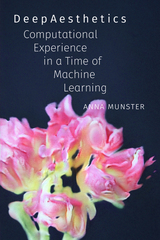 DeepAesthetics: Computational Experience in a Time of Machine Learning
Anna Munster
Duke University Press, 2025 Computation has now been reconfigured by machine learning: those technical processes and operations that yoke together statistics and computer science to create artificial intelligence (AI) by furnishing vast datasets to learn tasks and predict outcomes. In DeepAesthetics, Anna Munster examines the range of more-than-human experiences this transformation has engendered and considers how those experiences can be qualitative as well as quantitative. Drawing on process philosophy, Munster approaches computational experience through its relations and operations. She combines deep learning—the subfield of machine learning that uses neural network architectures—and aesthetics to offer a way to understand the insensible and frequently imperceptible forms of nonlinear and continuously modulating statistical function. Attending to the domains and operations of image production, statistical racialization, AI conversational agents, and critical AI art, Munster analyzes how machine learning is operationally entangled with racialized, neurotypical, and cognitivist modes of producing knowledge and experience. She approaches machine learning as events through which a different sensibility registers, one in which AI is populated by oddness, disjunctions, and surprises, and where artful engagement with machine learning fosters indeterminate futures.
Deepening Democracy Latin America
Kurt von Mettenheim
University of Pittsburgh Press, 1998 Ten leading scholars of the region present original research to argue that theories of democratic consolidation or institutionalization are too often Euro- and ethno-centric; that simple appeals for greater participation are insufficient; and that recent critics of populism, patronage, and presidentialism fail to capture new opportunities for democracies in the region.
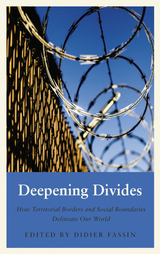 Deepening Divides: How Physical Borders and Social Boundaries Delineate our World
Didier Fassin
Pluto Press, 2019 At a glance, 'borders' and 'boundaries' may seem synonymous. But in the real (geopolitical) world, they coexist as distinct, albeit overlapping entities: the former a state's delimitation of territory; the latter the social delineation of differences. The refugee crisis in Europe showed how racial and ethnic boundaries are often instrumentalised to justify the strengthening of state borders - regardless of the cost in human life. But there are other, less tragic, examples that illustrate this overlapping as well, and ultimately demonstrate that the oft-differentiated spheres of borders and boundaries are best understood through their relationship to one another. Deepening Divides explores this relationship from many distinct perspectives and national contexts, with case studies covering five continents and drawing on anthropology, gender studies, law, political science and sociology for a truly interdisciplinary collection.
The Deepening Shade: Psychological Aspects of Life-Threatening Illness
Barbara M. Sourkes
University of Pittsburgh Press, 1982 The Deepening Shade is an elegant synthesis of the psychology of life-threatening illness. The book’s evocative power derives from the interweaving of clinical conceptualization with the words of patients and family members. Rather than focusing on death, Sourkes explores <I>living</I> with a life-threatening illness.
Deepening the Dialogue: Jewish-Americans and Israelis Envisioning the Jewish-Democratic State
Rabbi Stanley M. Davids
Central Conference of American Rabbis, 2020 Using the vision embedded in Israel's Declaration of Independence as a template, this anthology presents a unique and comprehensive dialogue between North American Jews and Israelis about the present and future of the State of Israel. With each essay published in both Hebrew and English, in one volume, Deepening the Dialogue is the first of its kind, outlining cultural barriers as well as the immediate need to come together in conversation around the vision of a democratic solution for our nation state.
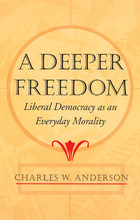 A Deeper Freedom: Liberal Democracy as an Everyday Morality
Charles W. Anderson
University of Wisconsin Press, 2002 Today those who believe in liberal democracy must reexamine and reaffirm their commitments. Here, Charles Anderson probes our urgent concerns and questions. Even those who believe that liberal democracy is the best form of government may think that liberal individualism leads to selfishness, permissiveness, and irresponsibility. Many would teach a cultural or religious counter-ethic to offset the excesses of freedom.
Grounding his view in classic philosophic and religious ideals, Anderson argues that a deeper vision of individuality and freedom can lead to both a sound public philosophy and a worthy personal ethic. In the same way that we as humans try to understand our place in nature and the cosmos, Anderson seeks to understand how we, as unique individuals, can understand our place among our fellow humans. Beginning with friendship and love, he extends his inquiry to the relationships of teaching, community, work, and democracy. Anderson shows how the natural desire of free people to find meaning in relationships with one another can lead to depth and fullness both in private and public life.
 Deeper Ground, Darker Shadows: The Making of a Mindanao Rebel
Eddie L. Quitoriano
University of Wisconsin Press, 2025 Deeper Ground, Darker Shadows is the memoir of Eddie L. Quitoriano, who grew up in a rural part of the Philippine island of Mindanao and eventually became one of the top organizers of the Communist Party of the Philippines (CPP) and commander of the party’s New People’s Army (NPA). Coming to political consciousness as a university student, Quitoriano chooses revolution over the priesthood and embarks on a life of unforeseen danger. Sent abroad as an envoy to seek military assistance from sympathetic governments and other radical factions, he travels from the Sandinistas in Nicaragua to Syria, Libya, North Korea, Peru, Brazil, and Yugoslavia.
Quitoriano finds revolutionary life thrilling but dangerous, with secretly arranged meetings and drops, doctored passports, and hastily planned plastic surgery. He wrestles with the global implications of his work, experiences daily struggles to survive in always-changing political circumstances, and is profoundly human in his love and concern for the family he has left behind in the Philippines. What emerges is a view of international revolutionary movements that only an insider could write. Quitoriano provides an essential and unique missing piece of twentieth-century Philippine and leftist history.
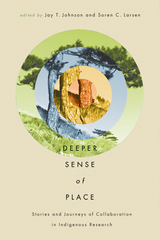 A Deeper Sense of Place: Stories and Journeys of Collaboration in Indigenous Research
Jay T. Johnson and Soren C. Larsen
Oregon State University Press, 2013 In A Deeper Sense of Place, editors Jay Johnson and Soren Larsen collect stories, essays, and personal reflections from geographers who have worked collaboratively with Indigenous communities across the globe.
These first-person narratives offer insight into the challenges faced by Native and non-Native scholars to their academic and personal approaches during research with Indigenous communities. By addressing the ethical, political, intellectual, and practical meanings of collaboration with Indigenous peoples, A Deeper Sense of Place highlights the ways in which collaborative research can help Indigenous and settler communities find common ground through a shared commitment to land, people, and place.
A Deeper Sense of Place will inform students and academics engaged in research with Indigenous communities, as well as those interested in the challenges of employing critical, qualitative methodologies.
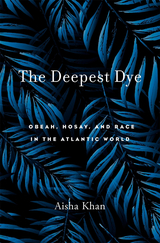 The Deepest Dye: Obeah, Hosay, and Race in the Atlantic World
Aisha Khan
Harvard University Press, 2021 How colonial categories of race and religion together created identities and hierarchies that today are vehicles for multicultural nationalism and social critique in the Caribbean and its diasporas.
When the British Empire abolished slavery, Caribbean sugar plantation owners faced a labor shortage. To solve the problem, they imported indentured “coolie” laborers, Hindus and a minority Muslim population from the Indian subcontinent. Indentureship continued from 1838 until its official end in 1917. The Deepest Dye begins on post-emancipation plantations in the West Indies—where Europeans, Indians, and Africans intermingled for work and worship—and ranges to present-day England, North America, and Trinidad, where colonial-era legacies endure in identities and hierarchies that still shape the post-independence Caribbean and its contemporary diasporas.
Aisha Khan focuses on the contested religious practices of obeah and Hosay, which are racialized as “African” and “Indian” despite the diversity of their participants. Obeah, a catch-all Caribbean term for sub-Saharan healing and divination traditions, was associated in colonial society with magic, slave insurrection, and fraud. This led to anti-obeah laws, some of which still remain in place. Hosay developed in the West Indies from Indian commemorations of the Islamic mourning ritual of Muharram. Although it received certain legal protections, Hosay’s mass gatherings, processions, and mock battles provoked fears of economic disruption and labor unrest that led to criminalization by colonial powers. The proper observance of Hosay was debated among some historical Muslim communities and continues to be debated now.
In a nuanced study of these two practices, Aisha Khan sheds light on power dynamics through religious and racial identities formed in the context of colonialism in the Atlantic world, and shows how today these identities reiterate inequalities as well as reinforce demands for justice and recognition.
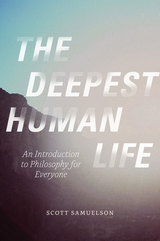 The Deepest Human Life: An Introduction to Philosophy for Everyone
Scott Samuelson
University of Chicago Press, 2014 Winner of the 2015 Hiett Prize in the Humanities.
Sometimes it seems like you need a PhD just to open a book of philosophy. We leave philosophical matters to the philosophers in the same way that we leave science to scientists. Scott Samuelson thinks this is tragic, for our lives as well as for philosophy. In The Deepest Human Life he takes philosophy back from the specialists and restores it to its proper place at the center of our humanity, rediscovering it as our most profound effort toward understanding, as a way of life that anyone can live. Exploring the works of some of history’s most important thinkers in the context of the everyday struggles of his students, he guides us through the most vexing quandaries of our existence—and shows just how enriching the examined life can be.
Samuelson begins at the beginning: with Socrates, working his most famous assertion—that wisdom is knowing that one knows nothing—into a method, a way of approaching our greatest mysteries. From there he springboards into a rich history of philosophy and the ways its journey is encoded in our own quests for meaning. He ruminates on Epicurus against the sonic backdrop of crickets and restaurant goers in Iowa City. He follows the Stoics into the cell where James Stockdale spent seven years as a prisoner of war. He spins with al-Ghazali first in doubt, then in the ecstasy of the divine. And he gets the philosophy education of his life when one of his students, who authorized a risky surgery for her son that inadvertently led to his death, asks with tears in her eyes if Kant was right, if it really is the motive that matters and not the consequences. Through heartbreaking stories, humanizing biographies, accessible theory, and evocative interludes like “On Wine and Bicycles” or “On Zombies and Superheroes ,” he invests philosophy with the personal and vice versa. The result is a book that is at once a primer and a reassurance—that the most important questions endure, coming to life in each of us.
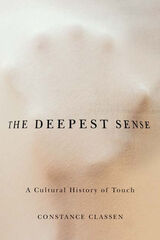 The Deepest Sense: A Cultural History of Touch
Constance Victoria Classen
University of Illinois Press, 2012 From the softest caress to the harshest blow, touch lies at the heart of our experience of the world. Now, for the first time, this deepest of senses is the subject of an extensive historical exploration. The Deepest Sense: A Cultural History of Touch fleshes out our understanding of the past with explorations of lived experiences of embodiment from the middle ages to modernity. This intimate and sensuous approach to history makes it possible to foreground the tactile foundations of Western culture--the ways in which feelings shaped society. Constance Classen explores a variety of tactile realms including the feel of the medieval city; the tactile appeal of relics; the social histories of pain, pleasure, and affection; the bonds of touch between humans and animals; the strenuous excitement of sports such as wrestling and jousting; and the sensuous attractions of consumer culture. She delves into a range of vital issues, from the uses--and prohibitions--of touch in social interaction to the disciplining of the body by the modern state, from the changing feel of the urban landscape to the technologization of touch in modernity. Through poignant descriptions of the healing power of a medieval king's hand or the grueling conditions of a nineteenth-century prison, we find that history, far from being a dry and lifeless subject, touches us to the quick.
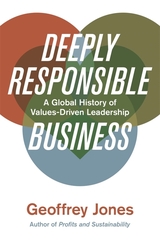 Deeply Responsible Business: A Global History of Values-Driven Leadership
Geoffrey Jones
Harvard University Press, 2023 Corporate social responsibility has entered the mainstream, but what does it take to run a successful purpose-driven business? A Harvard Business School professor examines leaders who put values alongside profits to showcase the challenges and upside of deeply responsible business.
For decades, CEOs have been told that their only responsibility is to the bottom line. But consensus is that companies—and their leaders—must engage with their social and environmental contexts. The man behind one of Harvard Business School's most popular courses, Geoffrey Jones distinguishes deep responsibility, which can deliver radical social and ecological responses, from corporate social responsibility, which is often little more than window dressing.
Deeply Responsible Business offers an invaluable historical perspective, going back to the Quaker capitalism of George Cadbury and the worker solidarity of Edward Filene. Through a series of in-depth profiles of business leaders and their companies, it carries us from India to Japan and from the turmoil of the nineteenth century to the latest developments in impact investing and the B-corps. Jones profiles business leaders from around the world who combined profits with social purpose to confront inequality, inner-city blight, and ecological degradation, while navigating restrictive laws and authoritarian regimes.
He found that these leaders were motivated by bedrock values and sometimes—but not always—driven by faith. They chose to operate in socially productive fields, interacted with humility with stakeholders, and felt a duty to support their communities. While far from perfect—some combined visionary practices with vital flaws—each one showed that profit and purpose could be reconciled. Many of their businesses were highly successful—though financial success was not their only metric of achievement.
As companies seek to coopt ethically sensitized consumers, Jones gives us a new perspective to tackle tough questions. Inspired by these passionate and pragmatic business leaders, he envisions a future in which companies and entrepreneurs can play a key role in healing our communities and protecting the natural world.
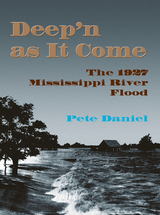 Deep'n as It Come: The 1927 Mississippi River Flood
Pete Daniel
University of Arkansas Press, 1998 In the spring and summer of 1927, the Mississippi River and its tributaries flooded from Cairo, Illinois to New Orleans, Louisiana, and the Gulf of Mexico, tearing through seven states, sometimes spreading out to nearly one hundred miles across. Pete Daniel’s Deep’n as It Come, available again in a new format, chronicles the worst flood in the history of the South and re-creates, with extraordinary immediacy, the Mississippi River’s devastating assault on property and lives.
Daniel weaves his narrative with newspaper and firsthand accounts, interviews and survivors, official reports, and over 140 contemporary photographs. The story of the common refugee who suffered most of the effects of the flood emerges alongside the details of the massive rescue and relief operation—one of the largest ever mounted in the United States. The title, Deep’n as It Come, is a phrase from Cora Lee Campbell’s early description of he approaching water, which, Daniel writes, “moved at a pace of some fourteen miles per day,” and in its movement and sound, “had the eeriness of a full eclipse of t he sun, unsettling, chilling.”
“The contradictions of sorrow and humor. . . death and salvation, despair and hope, calm and panic—all reveal the human dimension” in this compassionate and unforgettable portrait of common people confronting a great natural disaster.
 Deep-Sea Biodiversity: Pattern and Scale
Michael A. Rex and Ron J. Etter
Harvard University Press, 2010 Frigid, dark, and energy-deprived, the deep sea was long considered hostile to life. However, new sampling technologies and intense international research efforts in recent decades have revealed a remarkably rich fauna and an astonishing variety of novel habitats. These recent discoveries have changed the way we look at global biodiversity. In Deep-Sea Biodiversity, Michael Rex and Ron Etter present the first synthesis of patterns and causes of biodiversity in organisms that dwell in the vast sediment ecosystem that blankets the ocean floor. They provide the most comprehensive analysis to date of geographic variation in benthic animal abundance and biomass. The authors document geographic patterns of deep-sea species diversity and integrate potential ecological causes across scales of time and space. They also review the most recent molecular population genetic evidence to describe how and where evolutionary processes have generated the unique deep-sea fauna. Deep-Sea Biodiversity offers a new understanding of marine biodiversity that will be of general interest to ecologists and is crucial to responsible exploitation of natural resources at the deep-sea floor.
 Deepwater Alchemy: Extractive Mediation and the Taming of the Seafloor
Lisa Yin Han
University of Minnesota Press, 2024 How underwater mediation has transformed deep-sea spaces into resource-rich frontiers
Green energy technologies such as windmills, solar panels, and electric vehicles may soon depend on material found at the seabed. How did a space once imagined to be empty and unfathomable come to be thought of as a treasure trove of resources? Lisa Yin Han traces how contemporary developments in underwater sensing and imaging materially and imaginatively transmogrify the ocean bottom into a resource frontier capable of sustaining a digitally connected global future. Set against the backdrop of climate change, energy transition, and the expansion of industrial offshore extractions, Deepwater Alchemy looks at oceanic media and its representation of the seabed in terms of valuable resources. From high-tech simulations to laboratories and archives that collect and analyze sediments, Han explores the media technologies that survey, visualize, and condition the possibility for industrial resource extraction, introducing the concept of extractive mediation to describe the conflations between resource prospecting and undersea knowledge production. Moving away from anthropocentric frameworks, she argues that we must equalize access to deep ocean mediation and include the submerged perspectives of multispecies communities. From the proliferation of petroleum seismology to environmental-impact research on seabed mining to the development of internet-enabled seafloor observatories, Deepwater Alchemy shows us that deepwater mediation is entangled in existential hopes and fears for our planetary future. As the ocean bottom becomes increasingly accessible to people, Han prompts us to ask not whether we can tame the seafloor, but, rather, why and for whom are we taming it?
 Deepwater Horizon: A Systems Analysis of the Macondo Disaster
Earl Boebert and James M. BlossomForeword by Peter G. Neumann
Harvard University Press, 2016 On April 20, 2010, the crew of the floating drill rig Deepwater Horizon lost control of the Macondo oil well forty miles offshore in the Gulf of Mexico. Escaping gas and oil ignited, destroying the rig, killing eleven crew members, and injuring dozens more. The emergency spiraled into the worst human-made economic and ecological disaster in Gulf Coast history.
Senior systems engineers Earl Boebert and James Blossom offer the most comprehensive account to date of BP’s Deepwater Horizon oil spill. Sifting through a mountain of evidence generated by the largest civil trial in U.S. history, the authors challenge the commonly accepted explanation that the crew, operating under pressure to cut costs, made mistakes that were compounded by the failure of a key safety device. This explanation arose from legal, political, and public relations maneuvering over the billions of dollars in damages that were ultimately paid to compensate individuals and local businesses and repair the environment. But as this book makes clear, the blowout emerged from corporate and engineering decisions which, while individually innocuous, combined to create the disaster.
Rather than focusing on blame, Boebert and Blossom use the complex interactions of technology, people, and procedures involved in the high-consequence enterprise of offshore drilling to illustrate a systems approach which contributes to a better understanding of how similar disasters emerge and how they can be prevented.
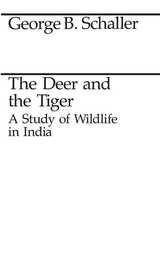 The Deer and the Tiger
George B. Schaller
University of Chicago Press, 1984 The Deer and the Tiger is Schaller's detailed account of the ecology and behavior of Bengal tigers and four species of the hoofed mammals on which they prey, based on his observations in India's Kanha National Park.
"This book is a treasure house of biological information and it is also a delight to read. . . . Excellent phoographs accompany the text."—Robert K. Enders, American Scientist
"The one book that has been my greatest source of inspiration is The Deer and the Tiger by George Schaller, based on the first ever scientific field study of the tiger. . . . This book is written by a scientist, but speaks from the heart. . . . It reveals startling information on feeding habitats, territorial behaviour, and the nuances that make up the language of the forest; you become totally immersed in the world of the tiger. . . . For all of us who work in tiger conservation, this book is the bible."—Valmik Thapar, BBC Wildlife
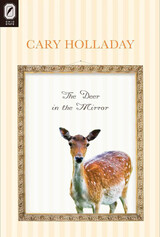 The Deer in the Mirror
Cary Holladay
Ohio State University Press, 2013 With a song-like voice and deep knowledge of the history and folklore of her native Virginia, Cary Holladay creates dazzling stories of hardship and ecstasy. A young widow romances a German immigrant while weighing a proposal from the colonial governor. Convicted of murdering her master, an enslaved woman is burned at the stake. A breakneck stagecoach ride gives a bricklayer’s apprentice the power to save or destroy his fellow passengers. An aging bachelor despairs of his marriage to a Confederate orphan. A beautiful adventuress joins the 1898 Alaska Gold Rush, charms a violent gangster, and figures out the secret of his fabulous wealth. This seventh book from an award-winning author spans 300 years in the Old Dominion. Holladay’s people fight the wars, battle the floods, and wrest a living from a wilderness where “Time is God’s, not ours”—so says a reformed prostitute whose obsessive love for an amnesiac Yankee soldier defines her life. With a sensuous, lyrical style, Holladay holds a distinctive place in contemporary fiction. All of these stories have appeared in major literary journals and anthologies, including Tin House and New Stories from the South: The Year’s Best.
Deering Library: An Illustrated History
Nina Barrett
Northwestern University Press, 2008 Published to commemorate the Deering Library’s 75th anniversary, this book explores the Deering and McCormick families, who funded the project; the building’s distinctive Collegiate Gothic architecture; its lore as a campus institution; and its role in the evolution of Northwestern University Library into one of the country’s most prominent research libraries. Richly illustrated, it is both an authoritative account of a landmark library and a rich keepsake for Northwestern alumni.
The Deerslayer
James Fenimore Cooper
Harvard University Press, 2013 Though The Deerslayer (1841) was the last of Cooper’s five Leather-stocking tales to be written, it is the first in the chronology of Natty Bumppo’s life. Set in the 1740s before the start of the French and Indian War, when Cooper’s rugged frontiersman is in his twenties, Cooper’s novel shows us how “Deerslayer” becomes “Hawkeye.” It remains the best point of entry into the series for modern readers.
In his introduction, Ezra Tawil examines Cooper’s motivations in writing The Deerslayer, the static nature of Natty, and Cooper’s vexed racial politics. The John Harvard Library edition reproduces the authoritative text of The Deerslayer in The Writings of James Fenimore Cooper (State University of New York Press).
Since 1959 The John Harvard Library has been instrumental in publishing essential American writings in authoritative editions.
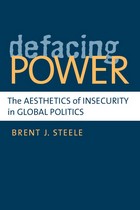 Defacing Power: The Aesthetics of Insecurity in Global Politics
Brent J. Steele
University of Michigan Press, 2012 "Combining a rich and varied set of theoretical insights with a subtle analysis of the politics of American foreign policy, Defacing Power marks an important contribution toward understanding the power of identity in world politics. Engagingly written and rigorously argued, Steele's challenging analysis is incisive, important, and rewarding."
---Michael C. Williams, Graduate School of Public and International Affairs, University of Ottawa "Brent Steele's marvelous excavation of the aesthetic dimensions of power is strikingly irreverent, inasmuch as he displays no commitment to ex ante disciplinary or substantive constraints in his quest to disclose those moments of creative action so often overlooked by theories and theorists wedded to the grandiose and the transhistorical. Steele samples and remixes a myriad of sources, arranging them so as to produce a transgressively insightful account of how 'work on the Self,' often condemned as self-indulgent by prior generations of intellectuals, might just point in the direction of a more sustainably secure world."
---Patrick Thaddeus Jackson, School of International Service, American University "Defacing Power successfully integrates work from Dewey to Morgenthau to Foucault, as well as a wide range of contemporary international relations scholars, in its genealogy of power conceptualizations and characteristics. This book is theoretically sophisticated and serious. It should be of interest to students of international politics, international theory, social theory, and foreign policy."
---Cecelia Lynch, Center for Global Peace and Conflict Studies, University of California, Irvine Defacing Power investigates how nation-states create self-images in part through aesthetics and how these images can be manipulated to challenge those states' power. Although states have long employed media, such as radio, television, and film, for their own image-making purposes, counterpower agents have also seized upon new telecommunications technologies. Most recently, the Internet has emerged as contested territory where states and other actors wage a battle of words and images. Moving beyond theory, Brent Steele illustrates his provocative argument about the vulnerability of power with examples from recent history: the My Lai Massacre and the Tet Offensive, September 11 and the al-Qaeda communiqués, the atrocities at Fallujah and Abu Ghraib, and the U.S. response to the Asian tsunami of December 2004. He demonstrates how a nation-state---even one as powerful as the United States---comes to feel threatened not only by other nation-states or terrorist organizations but also by unexpected events that challenge its self-constructed image of security. At the same time, Steele shows that as each generation uses available media to create and re-create a national identity, technological innovations allow for the shifting, upheaval, and expansion of the cultural structure of a nation. Brent J. Steele is Associate Professor of Political Science at the University of Kansas.
 Defeat Is the Only Bad News: Rwanda under Musinga, 1896–1931
Alison Des Forges
University of Wisconsin Press, 2011 A Rwandan proverb says “Defeat is the only bad news.” For Rwandans living under colonial rule, winning called not only for armed confrontation, but also for a battle of wits—and not only with foreigners, but also with each other. In Defeat Is the Only Bad News Alison Des Forges recounts the ambitions, strategies, and intrigues of an African royal court under Yuhi Musinga, the Rwandan ruler from 1896 to 1931. These were turbulent years for Rwanda, when first Germany and then Belgium pursued an aggressive plan of colonization there. At the time of the Europeans’ arrival, Rwanda was also engaged in a succession dispute after the death of one of its most famous kings. Against this backdrop, the Rwandan court became the stage for a drama of Shakespearean proportions, filled with deceit, shrewd calculation, ruthless betrayal, and sometimes murder. Historians who study European expansion typically focus on interactions between colonizers and colonized; they rarely attend to relations among the different factions inhabiting occupied lands. Des Forges, drawing on oral histories and extensive archival research, reveals how divisions among different groups in Rwanda shaped their responses to colonial governments, missionaries, and traders. Rwandans, she shows, used European resources to extend their power, even as they sought to preserve the autonomy of the royal court. Europeans, for their part, seized on internal divisions to advance their own goals. Des Forges’s vividly narrated history, meticulously edited and introduced by David Newbury, provides a deep context for understanding the Rwandan civil war a century later.
The Defective Detective in the Pulps
Edited by Gary Hoppenstand and Ray B. Browne
University of Wisconsin Press, 1983 The world of the defective detective was a strange one. Continuing the motif of the mythological hero, this unique detective type emerged in the 1930s in a very imperfect and threatened society. The stories reprinted in this volume reveal just how widely the genre ranged during the Depression.
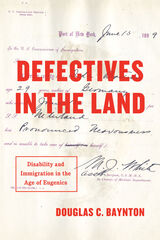 Defectives in the Land: Disability and Immigration in the Age of Eugenics
Douglas C. Baynton
University of Chicago Press, 2016 Immigration history has largely focused on the restriction of immigrants by race and ethnicity, overlooking disability as a crucial factor in the crafting of the image of the “undesirable immigrant.” Defectives in the Land, Douglas C. Baynton’s groundbreaking new look at immigration and disability, aims to change this.
In the late nineteenth and early twentieth centuries, Baynton explains, immigration restriction in the United States was primarily intended to keep people with disabilities—known as “defectives”—out of the country. The list of those included is long: the deaf, blind, epileptic, and mobility impaired; people with curved spines, hernias, flat or club feet, missing limbs, and short limbs; those unusually short or tall; people with intellectual or psychiatric disabilities; intersexuals; men of “poor physique” and men diagnosed with “feminism.” Not only were disabled individuals excluded, but particular races and nationalities were also identified as undesirable based on their supposed susceptibility to mental, moral, and physical defects.
In this transformative book, Baynton argues that early immigration laws were a cohesive whole—a decades-long effort to find an effective method of excluding people considered to be defective. This effort was one aspect of a national culture that was increasingly fixated on competition and efficiency, anxious about physical appearance and difference, and haunted by a fear of hereditary defect and the degeneration of the American race.
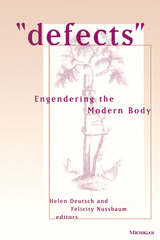 "Defects": Engendering the Modern Body
Helen Deutsch and Felicity Nussbaum, Editors
University of Michigan Press, 2000 "Defects" brings together essays on the emergence of the concept of monstrosity in the eighteenth century and the ways it paralleled the emergence of notions of sexual difference. Women, declared a mid-eighteenth-century vindication, have been regarded since Aristotle as deformed amphibious things, "neither more or less than Monsters" (Beauty's Triumph 1758). This alliance of monstrosity with misogyny, along with the definition of sexual difference as aberration, is the starting point for this volume's investigation of monstrosity's cultural work in the eighteenth century and its simultaneous mapping and troubling of the range of differences. This collection investigates the conceptual and geographical mapping of early modern and Enlightenment ideas of monstrosity onto a range of differences that contested established categories. The essays consider the representations and material dimensions of phenomena as diverse as femininity and disfigurement, the material imagination and monstrous birth, ugliness as an aesthetic category, deafness and theories of sign language, and the exotic, racialized deformed. Collectively, they demonstrate that the emergence of sexual difference is inextricably intertwined with the emergence of a category of the human that is imagined and deformed, monstrous, and ugly. Contributors include Barbara Benedict, Jill Campbell, Elizabeth Heckendorn Cook, Lennard Davis, Helen Deutsch, Robert Jones, Cora Kaplan, Nicholas Mirzoeff, Felicity Nussbaum, Stephen Pender, and Joel Reed.
 Defence and the UK Constitution
Nigel White
Haus Publishing, 2025 An overview of the United Kingdom’s constitution and defense policy.
Defense and security policy lies at the heart of the British state but can appear entirely untrammeled by the constitution. In fact, when political and military leaders exercise their executive powers, the UK Parliament and the judiciary have limited oversight, let alone control, over their actions. Defence and the UK Constitution introduces key constitutional issues to a general audience and pinpoints the differences between the “legal constitution” and the “political constitution,” with reference to the lack of accountability within modern British security structures. Nigel White traces this imbalance back to the 1680 Bill of Rights and examines the evolution of war and emergency powers, placing them within the context of international law.
Advocating for a rebalancing of the efficient and democratic, as well as the legal and political, elements of the constitution, this short work aims to address the inherent “defense paradox” in the UK constitution and to indicate which constitutional changes are needed to safeguard Britain’s democratic principles and limit excessive uses of discretionary power.
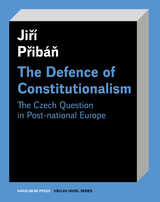 The Defence of Constitutionalism: Or the Czech Question in Post-National Europe
Jirí Pribán
Karolinum Press, 2018 More than a century after the publication of Czech politician Tomáš Garrigue Masaryk’s study The Czech Question, Czech politics—instead of the nation’s historical struggle for survival and independence—has become a pragmatic question of democratic constitutionalism and civility. Originally published in major Czech newspapers, these essays on contemporary European politics demonstrate that this new understanding involves both technical questions of power making and critical questions of its meaning. Democracy, Přibáň shows, is the process of permanent self-correction. It possesses both the capacity to respond to unexpected problems and crises and intrinsic tensions between principled arguments and everyday administrative processes. Defending constitutionalism, therefore, draws on principles of civil rights and freedoms, limited government, and representative democracy, the validity and persuasive force of which are at stake not only in the Czech Republic, but also in the post-national European Union and our global society at large.
A Defence of Philosophy
Ralph Barton Perry
Harvard University Press Philosophy is a somewhat mysterious subject to the general student and reader. What is it about? Why should people devote themselves to a subject seemingly so remote and so fruitless? What is the relation, if any, between the study of philosophy and that practical consolation which is popularly associated with the subject? The present volume is designed to answer these and like questions in terms which are intelligible to the uninitiated.
Defender of the Faith: William Jennings Bryan: The Last Decade, 1915–1925
Lawrence W. Levine
Harvard University Press, 1987 Defender of the Faith offers a reinterpretation of William Jennings Bryan in his last years as an unchanging Progressive whose roots were deeply embedded in agrarian populism. It changes the standard picture of Bryan in his final years as that of a crusader for social and economic reform sadly transformed into a reactionary champion of anachronistic rural evangelism, cheap moralistic panaceas, and Florida real estate. He pleaded for for progressive labor laws, liberal taxes, government aid to farmers, public ownership of railroads, telegraphs, and telephones, federal development of water resources, minimum wages for labor, and other advanced causes.
Defender of the Faithful: The Life and Thought of Rabbi Levi Yitshak of Berdychiv
Arthur Green
Brandeis University Press, 2022 The first scholarly biography of Levi Yitshak of Berdychiv in English in over thirty-five years.
Defender of the Faithful explores the life and thought of Levi Yitshak of Berdychiv (1740–1809), one of the most fascinating and colorful Hasidic leaders of his time. This is an intellectual and religious biography, a reading of the development of his thought and career. Featuring examples of Levi Yitshak’s extraordinary texts alongside insightful analysis by scholar and theologian Arthur Green, Defender of the Faithful is a compelling study of both Levi Yitshak’s theology and broader philosophy.
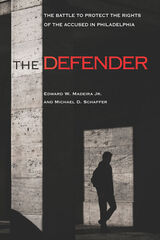 The Defender: The Battle to Protect the Rights of the Accused in Philadelphia
Edward W. Madeira Jr. and Michael D. Schaffer
Temple University Press, 2020 Long before the Supreme Court ruled that impoverished defendants in criminal cases have a right to free counsel, Philadelphia’s public defenders were working to ensure fair trials for all. In 1934, when penniless defendants were routinely railroaded through the courts without ever seeing a lawyer, Philadelphia attorney Francis Fisher Kane helped create the Voluntary Defender Association, supported by charity and free from political interference, to represent poor people accused of crime. When the Supreme Court’s 1963 decision Gideonv. Wainwright mandated free counsel for indigent defendants, the Defender (as it is now known) became more essential than ever, representing at least 70 percent of those caught in the machinery of justice in the city. Its groundbreaking work in juvenile advocacy, homicide representation, death-row habeas corpus petitions, parole issues, and alternative sentencing has earned a national reputation. In The Defender, Edward Madeira, past president of the Defender’s Board of Directors, and former Philadelphia Inquirer journalist Michael Schaffer chart the 80-plus-year history of the organization as it grew from two lawyers in 1934 to a staff of nearly 500 in 2015. This is a compelling story about securing justice for those who need it most.
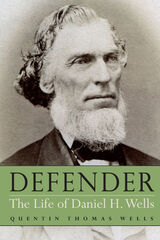 Defender: The Life of Daniel H. Wells
Quentin Thomas Wells
Utah State University Press, 2022 Defender is the first and only scholarly biography of Daniel H. Wells, one of the important yet historically neglected leaders among the nineteenth-century Mormons—leaders like Heber C. Kimball, George Q. Cannon, and Jedediah M. Grant. An adult convert to the Mormon faith during the Mormons’ Nauvoo period, Wells developed relationships with men at the highest levels of the church hierarchy, emigrated to Utah with the Mormon pioneers, and served in a series of influential posts in both church and state. Wells was known especially as a military leader in both Nauvoo and Utah—he led the territorial militia in four Indian conflicts and a confrontation with the US Army (the Utah War). But he was also the territorial attorney general and obtained title to all the land in Salt Lake City from the federal government during his tenure as the mayor of Salt Lake City. He was Second Counselor to Brigham Young in the LDS Church's First Presidency and twice served as president of the Mormon European mission. Among these and other accomplishments, he ran businesses in lumbering, coal mining, manufacturing, and gas production; developed roads, ferries, railroads, and public buildings; and presided over a family of seven wives and thirty-seven children. Wells witnessed and influenced a wide range of consequential events that shaped the culture, politics, and society of Utah in the latter half of the nineteenth century. Using research from relevant collections, sources in public records, references to Wells in the Joseph Smith papers, other contemporaneous journals and letters, and the writings of Brigham Young, Quentin Thomas Wells has created a serious and significant contribution to Mormon history scholarship.
The Defender’s Dilemma: Charting a Course Toward Cybersecurity
Martin C. Libicki
RAND Corporation, 2015 Cybersecurity is a constant, and, by all accounts growing, challenge. This report, the second in a multiphase study on the future of cybersecurity, reveals perspectives and perceptions from chief information security officers; examines the development of network defense measures—and the countermeasures that attackers create to subvert those measures; and explores the role of software vulnerabilities and inherent weaknesses.
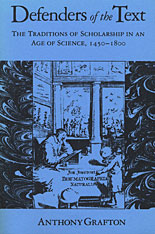 Defenders of the Text: The Traditions of Scholarship in an Age of Science, 1450–1800
Anthony Grafton
Harvard University Press, 1991 Anthony Grafton is erudite and elegant in the style of the best historical writers who make the past come alive for the reader. In a full-scale presentation of the world of scholarship, from the Renaissance to the modern period, Grafton sets before us in three-dimensional detail such seminal figures as Poliziano, Scaliger, Kepler, and Wolf. He calls attention to continuities, moments of crisis, and changes in direction.
The central issue in Defenders of the Text is the relation between humanism and science from the mid-fifteenth century to the beginning of the modern period. Treatments of Renaissance humanism in English have emphasized the humanists’ commitment to rhetoric, ethics, and politics and have accused the humanists of concentrating on literary matters in preference to investigating the real world via new developments in science, philosophy, and other technical disciplines. This revisionist book demonstrates that humanism was neither a simple nor an impractical enterprise, but worked hand-in-hand with science in developing modern learning.
Grafton makes clear that humanism remained an integral and vital part of European culture until the eighteenth century, maintaining a technical component of its own—classical philology—which developed in as rich, varied, and unexpected a way as any other field of European thought. Attention to the text led the humanists to develop a whole range of cools and methods that lent power to science and learning for centuries to come. Grafton shows the continued capacity of classical texts to provoke innovative work in both philology and philosophy, and traces a number of close and important connections between humanism and natural science. His book will be important to intellectual historians, students of the classics and the classical tradition, and historians of early modern science.
 Defending a Borderland: Canadian and American Environmental Activism in the St. Lawrence Valley
Neil S. Forkey
University of Massachusetts Press, 2026 Tracing grassroots activism in response to a devastating transnational oil spill
On the morning of June 23, 1976, the NEPCO 140 barge, carrying 8.7 million gallons of thick crude oil, ruptured twice while plying the swift straits of the St. Lawrence River’s Thousand Islands region. Before the spill was halted, 300,000 gallons of oil had leaked, polluting eighty miles of the river and ruining shorelines on both the New York and Canadian sides. It was the largest inland oil spill in United States history to that date, and the clean-up took 122 days and cost around $8 million. The disaster also prompted concerned citizens to form Save the River, one of the most enduring environmental organizations in North America.
In Defending a Borderland, environmental historian Neil S. Forkey examines environmental activism along the St. Lawrence River from both sides of the international border. He focuses on the period from the 1970s to the 1990s, when numerous citizen groups activated to protect the natural environment against pollution, development, and other perceived threats. Along with reacting to the “Slick of ’76,” their actions included stopping low-level military flights, preventing government land acquisition to create an extended park, and blocking new power lines through the countryside.
By considering the St. Lawrence Valley—a shared space between Canada, the United States, and Mohawk territory—Forkey brings a rare transnational approach to environmental analysis. He also highlights rural, local, and conservative perspectives, all of which are understudied. Using deep archival research and oral histories, Forkey reveals the myriad ways US and Canadian citizens organized before social media, gathering around kitchen tables, and in school auditoriums, to determine ways to reach government officials and neighbors and make lasting changes to protect the natural areas around them for future generations.
 Defending a Borderland: Canadian and American Environmental Activism in the St. Lawrence Valley
Neil S. Forkey
University of Massachusetts Press, 2026 Tracing grassroots activism in response to a devastating transnational oil spill
On the morning of June 23, 1976, the NEPCO 140 barge, carrying 8.7 million gallons of thick crude oil, ruptured twice while plying the swift straits of the St. Lawrence River’s Thousand Islands region. Before the spill was halted, 300,000 gallons of oil had leaked, polluting eighty miles of the river and ruining shorelines on both the New York and Canadian sides. It was the largest inland oil spill in United States history to that date, and the clean-up took 122 days and cost around $8 million. The disaster also prompted concerned citizens to form Save the River, one of the most enduring environmental organizations in North America.
In Defending a Borderland, environmental historian Neil S. Forkey examines environmental activism along the St. Lawrence River from both sides of the international border. He focuses on the period from the 1970s to the 1990s, when numerous citizen groups activated to protect the natural environment against pollution, development, and other perceived threats. Along with reacting to the “Slick of ’76,” their actions included stopping low-level military flights, preventing government land acquisition to create an extended park, and blocking new power lines through the countryside.
By considering the St. Lawrence Valley—a shared space between Canada, the United States, and Mohawk territory—Forkey brings a rare transnational approach to environmental analysis. He also highlights rural, local, and conservative perspectives, all of which are understudied. Using deep archival research and oral histories, Forkey reveals the myriad ways US and Canadian citizens organized before social media, gathering around kitchen tables, and in school auditoriums, to determine ways to reach government officials and neighbors and make lasting changes to protect the natural areas around them for future generations.
Defending AI Research: A Collection of Essays and Reviews
Edited by John McCarthy
CSLI, 1996 John McCarthy's influence in computer science ranges from the invention of LISP and time-sharing to the coining of the term AI and the founding of the AI laboratory at Stanford University. One of the foremost figures in computer sciences, McCarthy has written papers which are widely referenced and stand as milestones of development over a wide range of topics. In this collection of reviews, McCarthy staunchly defends the importance of Artificial Intelligence research against its attackers; this book gathers McCarthy's reviews of books which discuss and criticise the future of AI. Here, McCarthy explores the larger questions associated with AI, such as the question of the nature of intelligence, of the acquisition and application of knowledge, and the question of the politics behind this research.
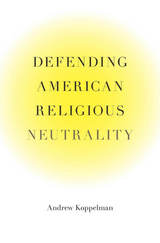 Defending American Religious Neutrality
Andrew Koppelman
Harvard University Press, 2012 Although it is often charged with hostility toward religion, First Amendment doctrine in fact treats religion as a distinctive human good. It insists, however, that this good be understood abstractly, without the state taking sides on any theological question. Here, a leading scholar of constitutional law explains the logic of this uniquely American form of neutrality—more religion-centered than liberal theorists propose, and less overtly theistic than conservatives advocate.
The First Amendment’s guarantee of freedom of religion is under threat. Growing numbers of critics, including a near-majority of the Supreme Court, seem ready to cast aside the ideal of American religious neutrality. Andrew Koppelman defends that ideal and explains why protecting religion from political manipulation is imperative in an America of growing religious diversity.
Understanding American religious neutrality, Koppelman shows, can explain some familiar puzzles. How can Bible reading in public schools be impermissible while legislative sessions begin with prayers, Christmas is an official holiday, and the words “under God” appear in the Pledge of Allegiance? Are faith-based social services, public financing of religious schools, or the teaching of intelligent design constitutional? Combining legal, historical, and philosophical analysis, Koppelman shows how law coherently navigates these conundrums. He explains why laws must have a secular legislative purpose, why old, but not new, ceremonial acknowledgments of religion are permitted, and why it is fair to give religion special treatment.
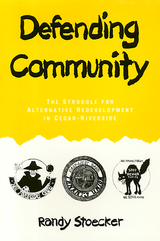 Defending Community: The Struggle for Alternative Redevelopment in Cedar-Riverside
Randy Stoecker
Temple University Press, 1994 Randy Stoecker's intimate biography of Cedar-Riverside, nationally known for a period as "the Haight-Ashbury of the Mid-West," contains important lessons about the conflicts between the needs of capitalism and the needs of community. While attending graduate school at the University of Minnesota, the author moved to Cedar-Riverside, a Minneapolis neighborhood known for its determination to enact values of peace, justice, wholeness, participation, and community in its truest sense. There he experienced first-hand the clashes between a radical community and state-backed urban developers. His narrative tells the story of a community that overcame the odds against its own survival. Slated for total demolition, the neighborhood was saved by a powerful grass-roots movement. Citizens stopped a state-capital coalition from entombing the community in concrete and went on to create one of the largest community controlled urban redevelopment projects in the country After more than twenty years of struggle, Cedar-Riverside continues to experience citizen-controlled urban redevelopment on its own terms, setting an example for other communities, urban planners, and policymakers. In the series Conflicts in Urban and Regional Development, edited by John R. Logan and Todd Swanstrom.
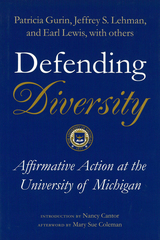 Defending Diversity: Affirmative Action at the University of Michigan
Patricia Gurin, Jeffrey S. Lehman, and Earl Lewis, with Eric L. Dey, Gerald Gurin, and Sylvia Hurtado
University of Michigan Press, 2004
Even as lawsuits challenging its admissions policies made their way through the courts, the University of Michigan carried the torch for affirmative action in higher education.
In June 2003, the Supreme Court vindicated UM's position on affirmative action when it ruled that race may be used as a factor for universities in their admissions programs, thus confirming what the UM had argued all along: diversity in the classroom translates to a beneficial and wide-ranging social value. With the green light given to the law school's admissions policies, Defending Diversity validates the positive benefits gained by students in a diverse educational setting.
Written by prominent University of Michigan faculty, Defending Diversity is a timely response to the court's ruling. Providing factual background, historical setting, and the psychosocial implications of affirmative action, the book illuminates the many benefits of a diverse higher educational setting -- including preparing students to be full participants in a pluralistic democracy -- and demonstrates why affirmative action is necessary to achieve that diversity.
Defending Diversity is a significant contribution to the ongoing discussion on affirmative action in higher education. Perhaps more important, it is a valuable record of the history, events, arguments, and issues surrounding the original lawsuits and the Supreme Court's subsequent ruling, and helps reclaim the debate from those forces opposed to affirmative action.
Patricia Gurin is Professor Emerita, Department of Psychology, University of Michigan. Jeffrey S. Lehman, former Dean of the University of Michigan Law School, is President of Cornell University. Earl Lewis is Dean of Rackham Graduate School, University of Michigan.
Defending Nazis in Postwar Czechoslovakia: Life of K. Resler, Defense Councel Ex Officio of K. H. Frank
Jakub Drápal
Karolinum Press, 2018 In this book, Czech lawyer and scholar Jakub Drápal tells the story of the life of Kamill Resler, an attorney who defended the most prominent Nazi tried in postwar Czechoslovakia: Karl Hermann Frank, who would go on to be executed for his role in organizing the massacres of the Czech villages Lidice and Ležáky in 1942. Celebrating Resler’s lifelong commitment to justice—to honoring even the most nefarious criminals’ right to a defense—Drápal highlights events that influenced Resler’s outlook and legal career, important cases that preceded Frank’s trial, Resler’s subsequent defenses of other Nazi criminals, and the final years of Resler’s life under the communist regime.
 Defending Probabilism: The Moral Theology of Juan Caramuel
Julia Fleming. Foreword by Charles E. Curran
Georgetown University Press, 2006 Through the centuries, at the heart of Catholic moral theology is a fundamental question: How do we behave responsibly in the face of moral uncertainty? Attempts to resolve problems of everyday life led to the growth of a variety of moral systems, one of which emerged in the early 17th century and was known as "probabilism." This method of solving difficult moral cases allowed the believer to rely upon a view that was judged defensible in terms of its arguments or the authorities behind it, even if the opposite opinion was supported by stronger arguments or more authorities. The theologian Juan Caramuel, a Spanish Cistercian monk whom Alphonso Liguori famously characterized as "the prince of laxists," has been regarded as one of the more extreme—and notorious—proponents of probabilism. As the only full-length English study of Caramuel's theological method, Defending Probabilism seeks to reappraise Caramuel's legacy, claiming that his model of moral thinking, if better understood, can actually be of help to the Church today. Considered one of the most erudite theologians of his age, a scientist and scholar who published works on everything from astronomy and architecture to printing and Gregorian chant, Caramuel strove throughout his life to understand probabilism's theological and philosophical foundations as part of his broader analysis of the nature of human knowledge. In applying Caramuel's legacy to our own time, Defending Probabilism calls for a reconsideration of the value of provisional moral knowledge. Fleming's study shows that history matters, and that to attain any position on moral certitude is a difficult and painstaking process.
 Defending Rumba in Havana: The Sacred and the Black Corporeal Undercommons
Maya J. Berry
Duke University Press, 2025 In Defending Rumba in Havana, anthropologist and dancer Maya J. Berry examines rumba as a way of knowing the embodied and spiritual dimensions of Black political imagination in post-Fidel Cuba. Historically a Black working-class popular dance, rumba, Berry contends, is a method of Black Cuban struggle that provides the community, accountability, sustenance, and dignity that neither the state nor the expanding private market can. Berry’s feminist theorization builds on the notion of the undercommons to show how rumba creates a space in which its practitioners enact deeply felt and dedicatedly defended choreographies of reciprocity, refusal, sovereignty, devotion, and pleasure, both on stage and in their daily lives. Berry demonstrates that this Black corporeal undercommons emphasizes mutual aid and refuses neoliberal development logics, favoring instead a collective self-determination rooted in African diasporic spiritual practices through which material compensation and gendered power dynamics are negotiated. By centering rumba to analyze how poor Black Cubans navigate gendered and racialized life, Berry helps readers better understand the constraints and yearnings that move diasporic Black struggles to seek refuge beyond the bounds of the nation-state.
Duke University Press Scholars of Color First Book Award
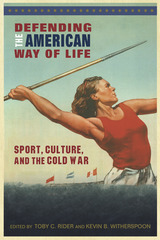 Defending the American Way of Life: Sport, Culture, and the Cold War
Toby C. Rider
University of Arkansas Press, 2018 Winner, 2019 NASSH Book Award, Anthology.
The Cold War was fought in every corner of society, including in the sport and entertainment industries. Recognizing the importance of culture in the battle for hearts and minds, the United States, like the Soviet Union, attempted to win the favor of citizens in nonaligned states through the soft power of sport. Athletes became de facto ambassadors of US interests, their wins and losses serving as emblems of broader efforts to shield American culture—both at home and abroad—against communism.
In Defending the American Way of Life, leading sport historians present new perspectives on high-profile issues in this era of sport history alongside research drawn from previously untapped archival sources to highlight the ways that sports influenced and were influenced by Cold War politics. Surveying the significance of sports in Cold War America through lenses of race, gender, diplomacy, cultural infiltration, anti-communist hysteria, doping, state intervention, and more, this collection illustrates how this conflict remains relevant to US sporting institutions, organizations, and ideologies today.
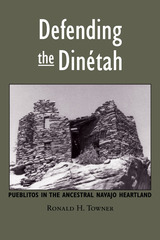 Defending The Dinetah
Ronald H Towner
University of Utah Press, 2003 Among the most striking features of the northwestern New Mexico landscape are the more than 130 fortresses and towers built on boulders, promontories, and mesa rims. These "pueblitos" in the traditional Navajo homeland of Dinétah have been a key piece of evidence used by archaeologists to infer a massive immigration of Puebloans into the Navajo country following the Spanish re-conquest of New Mexico (ca. 1700), yet they have never been comprehensively analyzed.
Using a database of tree-ring dates taken from beams and wood used to construct these pueblitos, Ronald Towner shows in this volume that most pueblitos are unrelated to Puebloan immigration or the re-conquest. He concludes that Navajos constructed the masonry structures and hogans contemporaneously for protection against Ute raiders and later Spanish entradas. Further, most were occupied for relatively brief periods and population density was much lower than has been assumed.
Towner points to a new model of Navajo ethnogenesis, based on a revised early population distribution and a variety of other means of incorporating non-Athapaskan elements into Navajo culture, making Defending the Dinétah a major contribution to Navajo studies.
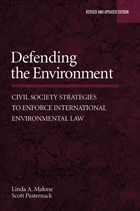 Defending the Environment: Civil Society Strategies to Enforce International Environmental Law
Linda A. Malone and Scott Pasternack
Island Press, 2006 Defending the Environment provides the means for nongovernmental organizations, community groups, and individuals to bring environmental and public health problems to the attention of international courts, tribunals, and commissions, or to their domestic counterparts. It suggests specific strategies and provides detailed information for taking action. This revised and updated edition also contains new case studies of the application of those strategies that has occurred in recent years. Each chapter provides a description of the institutional mechanisms that can potentially receive, review, and remedy the alleged violation, along with a set of guidelines that explain how the reader can employ a particular strategy, and an example that indicates the effectiveness of a given strategy. In addition, the book offers an appendix that lists individuals and organizations who can assist with the various strategies described. Defending the Environment represents the first concise, comprehensive guide to international environmental law and institutions that offers readers hands-on strategies for addressing environmental and public health problems.
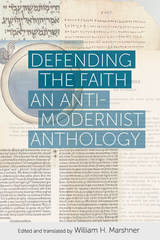 Defending the Faith
William H. Marshner
Catholic University of America Press, 2016 At the dawn of the 20th Century, several writers who were to become famous under the title of "Modernists" were advancing a deep agenda for reform in the faith and praxis of the Roman Catholic Church. But their agenda met with serious and scholarly opposition from another group of writers, whose essays are here made available in English. They include the historian and university rector Pierre Battifol, the biblical exegete M.J. Lagrange, OP, the Jesuit historical theologians Eugène Portalié and Léonce de Grandmaison, and the philosophers Eugène Franon and Joannès Wehrlé. All welcomed the historico-critical methods of research, and far from thinking them fatal to orthodoxy (as the Modernists did), they thought the Church's faith would survive and be strengthened by rigorous scholarship. These thinkers, then, are the true predecessors of Pius XII (Divino afflante Spiritu) and Vatican II (Dei Verbum). At the same time, these men thought outside the boxes drawn by 19th Century Positivism (Loisy), anti-intellectualist pragmatism (LeRoy), and romantic mysticism (Tyrrell). Their concerns hold new significance in the light of John Paul II's 1990 encyclical Fides et Ratio. Reading these too-long forgotten writers, then, deepens in a new way one's understanding of the Catholic Church's decision to decline and even condemn the Modernists' agenda, whether one ultimately applauds that decision or deplores it.
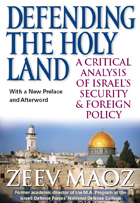 Defending the Holy Land: A Critical Analysis of Israel's Security and Foreign Policy
Zeev Maoz
University of Michigan Press, 2008 Defending the Holy Land is the most comprehensive analysis to date of Israel's national security and foreign policy, from the inception of the State of Israel to the present. Author Zeev Maoz's unique double perspective, as both an expert on the Israeli security establishment and esteemed scholar of Mideast politics, enables him to describe in harrowing detail the tragic recklessness and self-made traps that pervade the history of Israeli security operations and foreign policy.
Most of the wars in which Israel was involved, Maoz shows, were entirely avoidable, the result of deliberate Israeli aggression, flawed decision-making, and misguided conflict management strategies. None, with the possible exception of the 1948 War of Independence, were what Israelis call "wars of necessity." They were all wars of choice-or, worse, folly.
Demonstrating that Israel's national security policy rested on the shaky pairing of a trigger-happy approach to the use of force with a hesitant and reactive peace diplomacy, Defending the Holy Land recounts in minute-by-minute detail how the ascendancy of Israel's security establishment over its foreign policy apparatus led to unnecessary wars and missed opportunites for peace.
A scathing and brilliant revisionist history, Defending the Holy Land calls for sweeping reform of Israel's foreign policy and national security establishments. This book will fundamentally transform the way readers think about Israel's troubled history. Zeev Maoz is Professor of Political Science at the University of California, Davis. He is the former head of the Graduate School of Government and Policy and of the Jaffee Center for Strategic Studies at Tel Aviv University, as well as the former academic director of the M.A. Program at the Israeli Defense Forces' National Defense College. Cover photograph: Israel, Jerusalem, Western Wall and The Dome of The Rock. Courtesy of Corbis.
DEFENDING THE HOMELAND: "HISTORICAL PERSPECTIVES ON RADICALISM, TERRORISM, AND STATE RESPONSES"
MELINDA M. HICKS
West Virginia University Press, 2007 Terrorism and national security have been in the foreground of the nation’s political landscape since the uncertain times brought on by the attacks of September 11, 2001. This collection of scholarly essays provides a chance to learn from the past by offering an analytic—and sometimes provocative—look at the inseparability of security and history. This work is divided into separate elements depicting security on the national and international levels. "Part One–The US and National Security," focuses on topics such as “Rank-And-File Rednecks: Radicalism and Union Leadership in the West Virginia Mine Wars,” among others. "Part Two–International Terrorism," looks at violence overseas, such as “Beyond Victims and Perpetrators: Women Terrorists and Their Own Stories.”
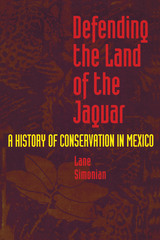 Defending the Land of the Jaguar: A History of Conservation in Mexico
By Lane Simonian
University of Texas Press, 1995 Mexican conservationists have sometimes observed that it is difficult to find a country less interested in the conservation of its natural resources than is Mexico. Yet, despite a long history dedicated to the pursuit of development regardless of its environmental consequences, Mexico has an equally long, though much less developed and appreciated, tradition of environmental conservation. Lane Simonian here offers the first panoramic history of conservation in Mexico from pre-contact times to the current Mexican environmental movement. He explores the origins of conservation and environmental concerns in Mexico, the philosophies and endeavors of Mexican conservationists, and the enactment of important conservation laws and programs. This heretofore untold story, drawn from interviews with leading Mexican conservationists as well as archival research, will be important reading throughout the international community of activists, researchers, and concerned citizens interested in the intertwined issues of conservation and development.
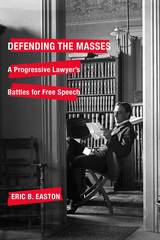 Defending the Masses: A Progressive Lawyer's Battles for Free Speech
Eric B. Easton
University of Wisconsin Press, 2018 Free speech and freedom of the press were often suppressed amid the social turbulence of the Progressive Era and World War I. As muckrakers, feminists, pacifists, anarchists, socialists, and communists were arrested or censored for their outspoken views, many of them turned to a Manhattan lawyer named Gilbert Roe to keep them in business and out of jail.
Roe was the principal trial lawyer of the Free Speech League—a precursor of the American Civil Liberties Union. His cases involved such activists as Emma Goldman, Lincoln Steffens, Margaret Sanger, Max Eastman, Upton Sinclair, John Reed, and Eugene Debs, as well as the socialist magazine The Masses and the New York City Teachers Union. A friend of Wisconsin's progressive senator Robert La Follette since their law partnership as young men, Roe defended "Fighting Bob" when the Senate tried to expel him for opposing America's entry into World War I.
In articulating and upholding Americans' fundamental right to free expression against charges of obscenity, libel, espionage, sedition, or conspiracy during turbulent times, Roe was rarely successful in the courts. But his battles illuminate the evolution of free speech doctrine and practice in an era when it was under heavy assault. His greatest victory, including the 1917 decision by Judge Learned Hand in The Masses Publishing Co. v. Patten, is still influential today.
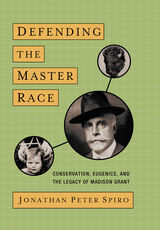 Defending the Master Race: Conservation, Eugenics, and the Legacy of Madison Grant
Jonathan Spiro
University Press of New England, 2008 Scholars have labeled Madison Grant everything from the “nation’s most influential racist” to the “greatest conservationist that ever lived.” His life illuminates early twentieth-century America as it was heading toward the American Century, and his legacy is still very much with us today, from the speeches of immigrant-bashing politicians to the international efforts to arrest climate change. This insightful biography shows how Grant worked side-by-side with figures such as Theodore Roosevelt to found the Bronx Zoo, preserve the California redwoods, and save the American bison from extinction. But Grant was also the leader of the eugenics movement in the United States. He popularized the infamous notions that the blond-haired, blue-eyed Nordics were the “master race” and that the state should eliminate members of inferior races who were of no value to the community. Grant’s behind-the-scenes machinations convinced Congress to enact the immigration restriction legislation of the 1920s, and his influence led many states to ban interracial marriage and sterilize thousands of “unworthy” citizens. Although most of the relevant archival materials on Madison Grant have mysteriously disappeared over the decades, Jonathan Spiro has devoted many years to reconstructing the hitherto concealed events of Grant’s life. His astonishing feat of detective work reveals how the founder of the Bronx Zoo wound up writing the book that Adolf Hitler declared was his “bible.”
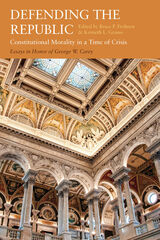 Defending the Republic: Constitutional Monarchy in a Time of Crisis: Essays in Honor of George W. Carey
Bruce Frohnen
Catholic University of America Press, 2022 In recent years, our constitutional order has increasingly come under attack as irredeemably undemocratic, racist, and oppressive. At the same time, it is increasingly obvious that politic practices in the United States have strayed very far from the founders’ designs and become deeply dysfunctional. The time is thus ripe for renewed reflection about the American political tradition.
This volume reintroduces readers to the conservative tradition of political and constitutional discourse. It brings together prominent political scientists and legal scholars, all of whom were deeply influenced by the life and work of the eminent constitutional scholar George W. Carey. For over 40 years, Carey strove mightily to explain the nature and requirements of our political tradition. How it fostered meaningful, virtuous self-government, and how our constitutional tradition has been derailed by progressivist ideology. He is perhaps best known for his concept of “constitutional morality,” the understanding that our republican constitutional order can be sustained only by a combination of formal mechanisms (e.g., separation of powers) and unwritten norms (“standards of behavior”) that act to foster deliberation and consensus, as well as keep political actors within the boundaries of their constitutional offices.
Contributors, including Francis Canavan, Claes G. Ryn, Paul Edward Gottfried, and Peter Augustine Lawler, discuss and develop Carey’s key insights, applying them to issues from the nature of majoritarian government to the purposes of constitutionalism to the decline of virtue that has accompanied the expansion of power among national and international elites. Each essay provides penetrating analysis of key aspects of our tradition, its inherent purposes, growth, and subsequent derailment, as well as the resources remaining within that tradition for the rebuilding of our constitutional order and a decent common life.
 Defending Their Own in the Cold: The Cultural Turns of U.S. Puerto Ricans
Marc Zimmerman
University of Illinois Press, 2011 Defending Their Own in the Cold: The Cultural Turns of U.S. Puerto Ricans explores U.S. Puerto Rican culture in past and recent contexts. The book presents East Coast, Midwest, and Chicago cultural production while exploring Puerto Rican musical, film, artistic, and literary performance. Working within the theoretical frame of cultural, postcolonial, and diasporic studies, Marc Zimmerman relates the experience of Puerto Ricans to that of Chicanos and Cuban Americans, showing how even supposedly mainstream U.S. Puerto Ricans participate in a performative culture that embodies elements of possible cultural "Ricanstruction." Defending Their Own in the Cold examines various dimensions of U.S. Puerto Rican artistic life, including relations with other ethnic groups and resistance to colonialism and cultural assimilation. To illustrate how Puerto Ricans have survived and created new identities and relations out of their colonized and diasporic circumstances, Zimmerman looks at the cultural examples of Latino entertainment stars such as Jennifer Lopez and Benicio del Toro, visual artists Juan Sánchez, Ramón Flores, and Elizam Escobar, as well as Nuyorican dancer turned Midwest poet Carmen Pursifull. The book includes a comprehensive chapter on the development of U.S. Puerto Rican literature and a pioneering essay on Chicago Puerto Rican writing. A final essay considers Cuban cultural attitudes towards Puerto Ricans in a testimonial narrative by Miguel Barnet and reaches conclusions about the past and future of U.S. Puerto Rican culture. Zimmerman offers his own "semi-outsider" point of reference as a Jewish American Latin Americanist who grew up near New York City, matured in California, went on to work with and teach Latinos in the Midwest, and eventually married a woman from a Puerto Rican family with island and U.S. roots.
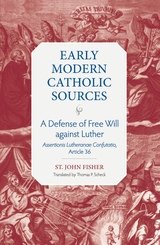 A Defense of Free Will Against Luther: Assertionis Lutheranae Confutatio, Article 36
St. John Fisher
Catholic University of America Press, 2024 Lord Acton said that of all the works written against Martin Luther in the beginning of the Reformation, Bishop John Fisher of Rochester's Assertionis Lutheranae Confutatio of 1523 was the most important. Oddly enough this massive work of Catholic apologetics, compsed in Latin, has never been rendered into the English language. It contains Fisher's detailed responses to all forty-one articles defended by Martin Luther against the censures of Pope Leo X found in the bull Exsurge Domine (1520).
In this volume Thomas Scheck presents for the first time in English translation, introduced, and annotated, Fisher's Preface to the Reader, Ten Truths, and the most important single article found in Fisher's Confutation, namely his Confutation of Luther's Assertion of Article 36, in which Fisher defends the existence of free will against Luther's claim that free will is a fiction with no reality. Fisher's reply is thoroughly grounded in Scripture and in the interpretation of Scripture found in the ancient Fathers of the Church. Interestingly to defend free will be makes abundant use of Augustine, Origen, Jerome, Tertullian and John Chrysostom.
Luther's controversy with the Catholic Church over free will is well known today from his debate with Erasmus of Rotterdam, which is easily accessible in English. Less well known is the fact that Bishop John Fisher's reply to Luther preceded Erasmus's by one year and was used extensively by Erasmus himself in arguing against Luther's positions. Also noteworthy is that Bishop John Fisher's particular response to Luther was well known to the bishops and theologians at the Council of Trent (1545-1563) and appears to have influenced the formulation of Catholic dogma in the Decree on Justification, where free will is affirmed and the power of human resistance recognized.
Bishop John Fisher was canonized along with St. Thomas More in 1935, 400 years after their bloody martyrdoms under King Henry VIII. Their mutual feast day is on June 22.
 A Defense of Galileo, the Mathematician from Florence
Richard J. Blackwell
University of Notre Dame Press, 1994 Despite extensive study of the Galileo affair in recent years, there are still some important documents relating to the case which have received little attention in the English-speaking world. In his translation of Thomas Campanella's Apologia pro Galileo, Richard J. Blackwell presents for the first time in English a reliable and highly readable translation of this important and neglected work. Campanella, the maverick Dominican, sought to head off the confrontation between Galileo and the theologians by defending Galileo's right to develop, debate, and publish his ideas freely. By making available at last a well-documented English version of this treatise--one in which the theological dimensions of the dispute receive their clearest presentation yet--Blackwell makes a worthy contribution to a heightened awareness of the doctrinal issues in the Galileo affairs.
Written in 1616 while Campanella was imprisoned by the Inquisition, the Apologia pro Galileo was banned in Rome at the time of its publication in 1622, therefore having little influence on the outcome of the Galileo case. However, then as now it stands as an important document calling for intellectual freedom as related to the Galileo case in particular, and as a plea for intellectual freedom in general.
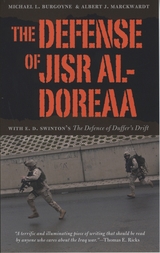 The Defense of Jisr al-Doreaa: With E. D. Swinton's "The Defence of Duffer's Drift"
Michael L. Burgoyne and Albert J. Marckwardt
University of Chicago Press, 2009 Following the invasion of Iraq in 2003 the U.S. military found itself in a battle with a lethal and adaptive insurgency, where the divisions between enemy and ally were ambiguous at best, and working with the local population was essential for day-to-day survival. From the lessons they learned during multiple tours of duty in Iraq, two American veterans have penned The Defense of Jisr al-Doreaa, an instructional parable of counterinsurgency that addresses the myriad of difficulties associated with war in the postmodern era. In this tactical primer based on the military classic The Defence of Duffer’s Drift, a young officer deployed for the first time in Iraq receives ground-level lessons about urban combat, communications technology, and high-powered weaponry in an environment where policy meets reality. Over the course of six dreams, the inexperienced soldier fights the same battle again and again, learning each time—the hard way—which false assumptions and misconceptions he needs to discard in order to help his men avoid being killed or captured. As the protagonist struggles with his missions and grapples with the consequences of his mistakes, he develops a keen understanding of counterinsurgency fundamentals and the potential pitfalls of working with the native population. Accompanied here by the original novella that inspired it, The Defense of Jisr al-Doreaa offers an invaluable resource for cadets and junior military leaders seeking to master counterinsurgency warfare—as well as general readers seeking a deeper understanding of the wars in Iraq and Afghanistan. Just as its predecessor has been a hallmark of military instruction, The Defense of Jisr al-Doreaa will draw the road map for counterinsurgency in the postmodern world. Visit a website for the book here: www.defenseofJAD.com
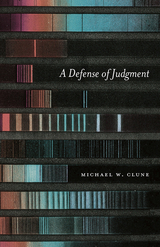 A Defense of Judgment
Michael W. Clune
University of Chicago Press, 2021 Teachers of literature make judgments about value. They tell their students which works are powerful, beautiful, surprising, strange, or insightful—and thus, which are more worthy of time and attention than others. Yet the field of literary studies has largely disavowed judgments of artistic value on the grounds that they are inevitably rooted in prejudice or entangled in problems of social status. For several decades now, professors have called their work value-neutral, simply a means for students to gain cultural, political, or historical knowledge.
Michael W. Clune’s provocative book challenges these objections to judgment and offers a positive account of literary studies as an institution of aesthetic education. It is impossible, Clune argues, to separate judgments about literary value from the practices of interpretation and analysis that constitute any viable model of literary expertise. Clune envisions a progressive politics freed from the strictures of dogmatic equality and enlivened by education in aesthetic judgment, transcending consumer culture and market preferences. Drawing on psychological and philosophical theories of knowledge and perception, Clune advocates for the cultivation of what John Keats called “negative capability,” the capacity to place existing criteria in doubt and to discover new concepts and new values in artworks. Moving from theory to practice, Clune takes up works by Keats, Emily Dickinson, Gwendolyn Brooks, Samuel Beckett, and Thomas Bernhard, showing how close reading—the profession’s traditional key skill—harnesses judgment to open new modes of perception.
A Defense Of Poetry
Gabriel Gudding
University of Pittsburgh Press, 2002 Winner of the 2001 Agnes Lynch Starrett Poetry Prize
Runner-up, Society of Midland Authors 2002 Poetry Prize
Gabriel Gudding’s poems not only defend against the pretense and vanity of war, violence, and religion, but also against the vanity of poetry itself. These poems sometimes nestle in the lowest regions of the body, and depict invective, donnybrooks, chase scenes, and the abuse of animals, as well as the indignities and bumblings of the besotted, the lustful, the annoyed, and the stupid.
In short, Gudding seeks to reclaim the lowbrow. Dangerous, edgy, and dark, this is an innovative writer unafraid to attack the unremitting high seriousness of so much poetry, laughing with his readers as he twists the elegiac lyric "I" into a pompous little clown.
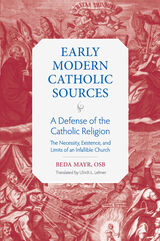 A Defense of the Catholic Religion: The Necessity, Existence, and Limits of an Infallible Church
Beda Mayr, OSB
Catholic University of America Press, 2023 The Benedictine Beda Mayr,OSB, (1742–1794) was one of the main figures of the German Catholic Enlightenment. He was not only the first Catholic to wrestle with the challenges of Reimarus and Lessing, but also the first to develop an ecumenical methodology for a reunion of the churches. The text, translated from the German original for the first time, presents a theologian who intentionally went to the margins of orthodoxy in order to allow for more interconfessional dialogue. Mayr argued that Catholic theology should follow minority opinions for unsettled dogmatic questions, which would allow for easier union agreements with Protestant churches. Moreover, he suggested limiting ecclesial infallibility to directly revealed truths, thereby reducing the authoritative truth claims of conciliar or papal decisions.
Although the study of Catholic Enlightenment is booming among historians and theologians, too few texts are available in reliable translations. A major strength of this edition is not only that its introduction introduces the reader to the colorful landscape of eighteenth-century theological discussions, but also presents the entire text of Mayr's book (with the exception of its appendix) thereby allowing the reader to see the strengths and weaknesses of Enlightenment ecumenism.
Mayr's Limited Infallibility was put on the Index of Forbidden Books, on which it remained until the 20th Century. It invites readers to a modern, non-scholastic way of theologizing for the sake of Christian unity.
Defense Practitioner’s Guide to Medicare Secondary Payer Issues
DRI’s Medicare Secondary Payer Task Force
DRI, 2015 This third edition of the DRI Defense Practitioner's Guide to Medicare Secondary Payer Issues reflects the experience that the authors gained in the time since the first edition was compiled in May 2010. It remains a quick, accessible reference guide for the practitioner who is actively working to resolve cases involving Medicare Secondary Payer issues. This is truly a desk book for lawyers and claims professionals and not an academic or exhaustive analysis of the law in this area. As such, it is the definitive "must have" desk reference for anyone who addresses claims involving Medicare beneficiaries.
Defense Resource Planning Under Uncertainty: An Application of Robust Decision Making to Munitions Mix Planning
Robert J. Lempert
RAND Corporation, 2016 Defense planning faces significant uncertainties. This report applies robust decision making (RDM) to the air-delivered munitions mix challenge. RDM is quantitative, decision support methodology designed to inform decisions under conditions of deep uncertainty and complexity. This proof-of-concept demonstration suggests that RDM could help defense planners make plans more robust to a wide range of hard-to-predict futures.
 Defensible Space/if a crow—
Ian Lockaby
Omnidawn, 2024 Experimental poetry that embraces shifts, adaptation, and the unknown as a means to move beyond old and dying worlds.
Considering how we might detox from old languages, systems, and modes of life, Ian Lockaby’s poems seek out new forms of interconnectivity and possibility, finding the energy of emerging worlds along the edges of ruins. This collection poses questions of how to thrive in aftermaths, suggesting that attempts at absolute knowledge are less powerful than an embrace of the unknown. Throughout these poems, Lockaby uses crows as a model for dynamic adaption and creative entanglement with the world and with language, finding “defensible space” for new lyrical syntax amid shifts and desolation: “Everywhere a burning root system. Everywhere, a root fire crowing off the splayed tail feathers of a crow.”
Defensible Space/if a crow—looks towards a reintroduction of fire into wilds and wilds into our lives, taking the unknown of an “if” as the base from where we can build life.
Defensible Space/if a crow– won Omnidawn’s 2022 Poetry Chapbook contest, selected by Ruth Ellen Kocher.
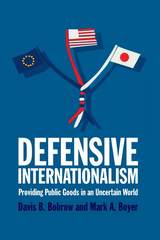 Defensive Internationalism: Providing Public Goods in an Uncertain World
Davis B. Bobrow and Mark A. Boyer
University of Michigan Press, 2005 "The authors' carefully crafted analysis will influence thought and the policy debate on the tradeoff between unilateralism and multilateralism for decades to come." -Todd Sandler, Robert R. and Katheryn A. Dockson Professor of International Relations & Economics, University of Southern California "Boyer and Bobrow's well-written, data-rich analysis of such pressing issues as development assistance, debt management, UN peacekeeping, and environmental protection makes Defensive Internationalism a highly original and provocative contribution to the study of global governance." -Yale H. Ferguson, Co-Director, Center for Global Change and Governance, Rutgers University In this pathbreaking study, authors Davis B. Bobrow and Mark A. Boyer argue for "muted optimism" about the future of international cooperation. Leaders of a growing movement that integrates constructivism into traditional international studies concepts and methods, Bobrow and Boyer analyze four key international issues: development cooperation, debt management, peacekeeping operations, and environmental affairs. Their approach integrates elements of public goods theory, identity theory, new institutionalism, and rational choice. Defensive Internationalism is a well-written, creative and coherent synthesis of ideas that have up to now been considered irreconcilable. It is appropriate for upper-level undergraduate and graduate students in international relations, conflict studies, and political economy, and promises to become a foundational work in its field. Davis B. Bobrow is Professor of Public and International Affairs and Political Science at the University of Pittsburgh. Mark A. Boyer is Professor of Political Science at the University of Connecticut.
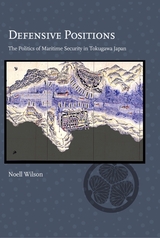 Defensive Positions: The Politics of Maritime Security in Tokugawa Japan
Noell Wilson
Harvard University Press Defensive Positions focuses on the role of regional domains in early modern Japan’s coastal defense, shedding new light on this system’s development. This examination, in turn, has significant long-term political implications for the involvement of those domains in Tokugawa state formation. Noell Wilson argues that domainal autonomy in executing maritime defense slowly escalated over the course of the Tokugawa period to the point where the daimyo ultimately challenged Tokugawa authorities as the primary military interface with the outside world. By first exploring localized maritime defense at Nagasaki and then comparing its organization with those of the Yokohama and Hakodate harbors during the treaty port era, Wilson identifies new, core systemic sources for the collapse of the shogunate’s control of the monopoly on violence. Her insightful analysis reveals how the previously unexamined system of domain-managed coastal defense comprised a critical third element—in addition to trade and diplomacy—of Tokugawa external relations. Domainal control of coastal defense exacerbated the shogunate’s inability to respond to important military and political challenges as Japan transitioned from an early modern system of parcelized, local maritime defense to one of centralized, national security as embraced by world powers in the nineteenth century.
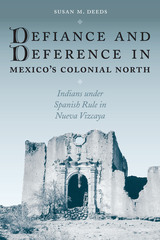 Defiance and Deference in Mexico's Colonial North: Indians under Spanish Rule in Nueva Vizcaya
By Susan Deeds
University of Texas Press, 2003 Thomas F. McGann Memorial Prize, Rocky Mountain Council on Latin American Studies, 2004
Southwest Book Award, Border Regional Library Association, 2003 In their efforts to impose colonial rule on Nueva Vizcaya from the sixteenth century to the middle of the seventeenth, Spaniards established missions among the principal Indian groups of present-day eastern Sinaloa, northern Durango, and southern Chihuahua, Mexico—the Xiximes, Acaxees, Conchos, Tepehuanes, and Tarahumaras. Yet, when the colonial era ended two centuries later, only the Tepehuanes and Tarahumaras remained as distinct peoples, the other groups having disappeared or blended into the emerging mestizo culture of the northern frontier. Why were these two indigenous peoples able to maintain their group identity under conditions of conquest, while the others could not? In this book, Susan Deeds constructs authoritative ethnohistories of the Xiximes, Acaxees, Conchos, Tepehuanes, and Tarahumaras to explain why only two of the five groups successfully resisted Spanish conquest and colonization. Drawing on extensive research in colonial-era archives, Deeds provides a multifaceted analysis of each group's past from the time the Spaniards first attempted to settle them in missions up to the middle of the eighteenth century, when secular pressures had wrought momentous changes. Her masterful explanations of how ethnic identities, subsistence patterns, cultural beliefs, and gender relations were forged and changed over time on Mexico's northern frontier offer important new ways of understanding the struggle between resistance and adaptation in which Mexico's indigenous peoples are still engaged, five centuries after the "Spanish Conquest."
 Defiant Acts: A Novel
James Stewart III
Acre Books, 2025 Drawing on the author’s experiences, this debut novel follows an interracial blended family living in Chicago in the 1990s.
James Stewart III’s powerful debut novel documents the life of a working-class interracial couple and their children in a Chicago suburb in the early 1990s. The father, Jim, is a Black man married to Connie, a white woman with two white sons from a previous marriage. Connie and Jim have three more children together, and the entire family lives in a cramped two-bedroom apartment in a well-to-do, predominantly white community.
Defiant Acts follows the Stewarts through a year in which Jim fights to earn a promotion, the adolescent boys struggle to find themselves, one of the younger children becomes gravely ill, and the parents try to stay afloat in a shaky economy. Within the walls of the Stewarts’ home, race doesn’t factor, but when the family interacts with the outside world, it is inescapable, a basis for identity and inclusion as well as a spur for exclusion and abuse.
Rooted in the tradition of Black authors from Chicago and drawing on the author’s own experiences, Defiant Acts eschews a conventional plot, presenting a series of captured moments—past and present—and multiple perspectives to build a mosaic of the family’s lives. In clear, concise prose, Stewart focuses on the complexities of human relationships and on race relations both in and outside the domestic space, placing emphasis on the values that bind this tight-knit family together: solidarity, care, and hope.
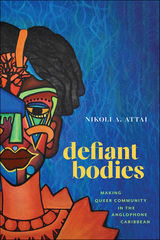 Defiant Bodies: Making Queer Community in the Anglophone Caribbean
Nikoli A. Attai
Rutgers University Press, 2023 In the Anglophone Caribbean, international queer human rights activists strategically located within and outside of the region have dominated interventions seeking to address issues affecting people across the region; a trend that is premised on an idea that the Caribbean is extremely homophobic and transphobic, resulting in violence and death for people who defy dominant sexual and gender boundaries. Human rights activists continue to utilize international financial and political resources to influence these interventions and the region’s engagement on issues of homophobia, transphobia, discrimination, and the HIV/AIDS epidemic. This focus, however, elides the deeply complex nature of queerness across different spaces and places, and fails to fully account for the nuances of queer sexual and gender politics and community making across the Caribbean. Defiant Bodies: Making Queer Community in the Anglophone Caribbean problematizes the neocolonial and homoimperial nature of queer human rights activism in in four Anglophone Caribbean nations -- Barbados, Guyana, Jamaica, and Trinidad and Tobago -- and thinks critically about the limits of human rights as a tool for seeking queer liberation. It also offers critical insight into the ways that queer people negotiate, resist, and disrupt homophobia, transphobia, and discrimination by mobilizing “on the ground” and creating transgressive communities within the region.
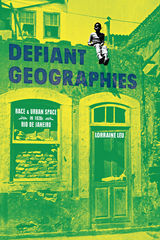 Defiant Geographies: Race and Urban Space in 1920s Rio de Janeiro
Lorraine Leu
University of Pittsburgh Press, 2020 Defiant Geographies examines the destruction of a poor community in the center of Rio de Janeiro to make way for Brazil’s first international mega-event. As the country celebrated the centenary of its independence, its postabolition whitening ideology took on material form in the urban development project that staged Latin America’s first World’s Fair. The book explores official efforts to reorganize space that equated modernization with racial progress. It also considers the ways in which black and blackened subjects mobilized their own spatial logics to introduce alternative ways of occupying the city. Leu unpacks how the spaces of the urban poor are racialized, and the impact of this process for those who do not fit the ideal models of urbanity that come to define the national project. Defiant Geographies puts the mutual production of race and space at the heart of scholarship on Brazil’s urban development and understands urban reform as a monumental act of forgetting the country’s racial past.
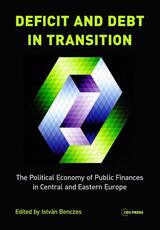 Deficit and Debt in Transition: The Political Economy of Public Finances in Central and Eastern Europe
Istvan Benczes
Central European University Press, 2014 The adjustment problems of public finance in countries of Central and Eastern Europe (CEE) are often misunderstood and misinterpreted by western scholars. This book contributes to the bridging of the gap between what is being thought by external observers and what the actual public finance reality is, as described by competent local scholars. Popular political economy research has remained biased towards advanced countries and has neglected developing and transition economies. Publications on CEE countries' public finances seem to be reluctant to apply the conceptual framework of standard political economy to these countries because of the assumption that CEE economies are different from their Western peers. But is this really the case? Are CEE economies so much different that none of the well-known "Western" political economy concepts or models can be applied to the analysis of fiscal performance in the region? Benczes demonstrates that they can be safely applied in the context of CEE economies as well. He sees no need to develop a separate or unique theory designed for the study and understanding of (one-time) transition economies.
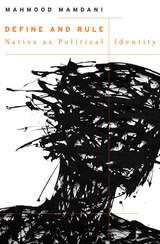 Define and Rule: Native as Political Identity
Mahmood Mamdani
Harvard University Press, 2012 Define and Rule focuses on the turn in late nineteenth-century colonial statecraft when Britain abandoned the attempt to eradicate difference between conqueror and conquered and introduced a new idea of governance, as the definition and management of difference. Mahmood Mamdani explores how lines were drawn between settler and native as distinct political identities, and between natives according to tribe. Out of that colonial experience issued a modern language of pluralism and difference.
A mid-nineteenth-century crisis of empire attracted the attention of British intellectuals and led to a reconception of the colonial mission, and to reforms in India, British Malaya, and the Dutch East Indies. The new politics, inspired by Sir Henry Maine, established that natives were bound by geography and custom, rather than history and law, and made this the basis of administrative practice.
Maine’s theories were later translated into “native administration” in the African colonies. Mamdani takes the case of Sudan to demonstrate how colonial law established tribal identity as the basis for determining access to land and political power, and follows this law’s legacy to contemporary Darfur. He considers the intellectual and political dimensions of African movements toward decolonization by focusing on two key figures: the Nigerian historian Yusuf Bala Usman, who argued for an alternative to colonial historiography, and Tanzania’s first president, Mwalimu Julius Nyerere, who realized that colonialism’s political logic was legal and administrative, not military, and could be dismantled through nonviolent reforms.
Defining a Discipline: Archival Research and Practice in the 21st Century: Essays in Honor of Richard J. Cox
Jeannette A. Bastian
Society of American Archivists, 2020 Fourteen archivists present a mosaic of the research that represents the current state of archival science and introduces themes that will carry the profession into the future as a complex academic discipline. As the archival profession in the United States continues to evolve, the book honors one of its most prolific and influential thinkers and writers, Richard J. Cox, who retired from the profession in 2017 after a 45-year career. The book addresses the archival themes of accountability and evidence, ethics and education, archival history, and memory.
Defining a Discipline demonstrates the importance of the role of archivists, archives, and archival institutions in communities, organizations, and the digital environment. It looks forward—a direction that the pioneering Cox promoted throughout his career.
 Defining America: Through Immigration Policy
Bill Ong Hing
Temple University Press, 2003 From the earliest days of nationhood, the United States has determined who might enter the country and who might be naturalized. In this sweeping review of US immigration policies, Bill Ong Hing points to the racial, ethnic, and social struggles over who should be welcomed into the community of citizens. He shows how shifting visions of America have shaped policies governing asylum, exclusion, amnesty, and border policing. Written for a broad audience, Defining America Through Immigration Policy sets the continuing debates about immigration in the context of what value we as a people have assigned to cultural pluralism in various eras. Hing examines the competing visions of America reflected in immigration debates over the last 225 years. For instance, he compares the rationales and regulations that limited immigration of southern and eastern Europeans to those that excluded Asians in the nineteenth century. He offers a detailed history of the policies and enforcement procedures put in place to limit migration from Mexico, and indicts current border control measures as immoral. He probes into little discussed issues such as the exclusion of gays and lesbians and the impact of political considerations on the availability of amnesty and asylum to various groups of migrants. Hing's spirited discussion and sophisticated analysis will appeal to readers in a wide spectrum of academic disciplines as well as those general readers interested in America's on-going attempts to make one of many.
 Defining Biology: Lectures from the 1890s
Jane Maienschein
Harvard University Press, 1986 The 1890s was an exciting time in American biology, a time of great intellectual debate and turmoil. Much of this activity centered on the now-famous Evening Lectures delivered at the Woods Hole Marine Biological Laboratory on Cape Cod, where leading biologists gathered to research the leading issues of the day. There was no better way to learn about what was being discussed and debated at the cutting edge of biology than through the Evening Lectures. The lectures of outstanding scientists such as C. 0. Whitman, E. B. Wilson, E. G. Conklin, J. Loeb, and T. H. Morgan redefined our thinking about biology.
These Evening Lectures stimulated major biological revolutions: the conversion of embryology to an independent discipline; the beginnings of ethology; the rise of genetics and especially cytogenetics; and the application of chemistry and physics to cell function-the birth of what is now called cell biology. Some of the central problems that scientists still puzzle over were first proposed at Woods Hole.
Not only are these lectures important scientific accomplishments, they also provide an invaluable record of the beginnings of a truly American school of biology. Printed in a limited edition, they have remained inaccessible to many people interested in knowing more about the meteoric rise of American biology. Jane Maienschein has selected key lectures, written an introductory essay, and provided brief explanations of the significance and impact of each lecture. Ernst Mayr, distinguished biologist and historian, has added a Foreword about the intellectual importance of the lectures to the formation of American biology; and Paul Gross, present Director of the Marine Biological Laboratory, has contributed an Epilogue that conveys the excitement and later significance of the 1890s.
Defining Cinema
Edited by Peter Lehman
Rutgers University Press, 1997 Defining Cinema is the first book to bring together leading theorists and scholars to discuss the importance of film theory to cinema studies. Peter Lehman introduces the volume by explaining what constitutes film theory and outlining the major positions within the field by placing these five theorists and their work within a historical perspective. Andre Bazin and Siegfried Kracauer represent realist film theories, and Sergei Eisenstein represents a formalist position. Noel Burch and Christian Metz are contemporary theorists who have moved beyond the classical realist-formalist opposition. Burch's theory encompasses films and styles praised by both Bazin and Eisenstein, and Metz helped bring semiotics and psychoanalytic theory to prominence in the field.
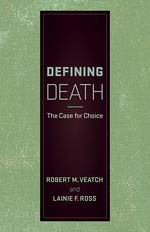 Defining Death: The Case for Choice
Robert M. Veatch and Lainie F. Ross
Georgetown University Press, 2016 New technologies and medical treatments have complicated questions such as how to determine the moment when someone has died. The result is a failure to establish consensus on the definition of death and the criteria by which the moment of death is determined. This creates confusion and disagreement not only among medical, legal, and insurance professionals but also within families faced with difficult decisions concerning their loved ones. Distinguished bioethicists Robert M. Veatch and Lainie F. Ross argue that the definition of death is not a scientific question but a social one rooted in religious, philosophical, and social beliefs. Drawing on history and recent court cases, the authors detail three potential definitions of death — the whole-brain concept; the circulatory, or somatic, concept; and the higher-brain concept. Because no one definition of death commands majority support, it creates a major public policy problem. The authors cede that society needs a default definition to proceed in certain cases, like those involving organ transplantation. But they also argue the decision-making process must give individuals the space to choose among plausible definitions of death according to personal beliefs. Taken in part from the authors' latest edition of their groundbreaking work on transplantation ethics, Defining Death is an indispensable guide for professionals in medicine, law, insurance, public policy, theology, and philosophy as well as lay people trying to decide when they want to be treated as dead.
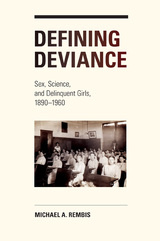 Defining Deviance: Sex, Science, and Delinquent Girls, 1890-1960
Michael A. Rembis
University of Illinois Press, 2013 Defining Deviance analyzes how reformers in the late nineteenth and early twentieth centuries perceived delinquent girls and their often troubled lives. Drawing on exclusive access to thousands of case files and other documents at the State Training School in Geneva, Illinois, Michael A. Rembis uses Illinois as a case study to show how implementation of involuntary commitment laws in the United States reflected eugenic thinking about juvenile delinquency. Much more than an institutional history, Defining Deviance examines the cases of vulnerable young women to reveal the centrality of sex, class, gender, and disability in the formation of scientific and social reform. Rembis recounts the contestations between largely working-class teenage girls and the mostly female reformers and professionals who attempted to diagnose and treat them based on changing ideas of eugenics, gender, and impairment. He shows how generational roles and prevailing notions of gender and sexuality influenced reformers to restrict, control, and institutionalize undesirable "defectives" within society, and he details the girls' attempts to influence methods of diagnosis, discipline, and reform. In tracing the historical evolution of ideologies of impairment and gender to show the central importance of gender to the construction of disability, Rembis reveals the larger national implications of the cases at the State Training School. His study provides new insights into the treatment of young women whom the dominant society perceived as threats to the sexual and eugenic purity of modern America.
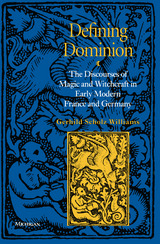 Defining Dominion: The Discourses of Magic and Witchcraft in Early Modern France and Germany
Gerhild Scholz Williams
University of Michigan Press, 1999 In this intriguing volume, Gerhild Scholz Williams explores the roles of magic and demonology in France and Germany in the fifteenth and sixteenth centuries. She guides the reader through a variety of texts--many of them popular and influential in their day--to illuminate how magic came to shape people's perceptions of a changing world. This comprehensive study looks at magic as an intellectual and cultural language, as an attempt to explain the world, and as a means to control and confine women, whose propensity for satanic dalliance threatened not just their own souls but the health of the larger society.
". . . Williams has done an exemplary job of analyzing the intersection of the discourses of magic (as related to women and witchcraft), discovery, and religious diversity/dissidence to explain how the confluence of these discourses eventually 'determined who occupied society's center and who was forced to move to, or remain at, its margins.' . . . Gerhild Scholz Williams is no dilettante grazing in the greener pastures of other disciplines. She has been laboring assiduously in these neighboring fields for years now, and it is breathtaking to see how all of her disparate projects have come together so elegantly articulated in this one volume." --Susan L. Cocalis, German Studies Review
Gerhild Scholz Williams is Professor of German and Comparative Literature, Washington University, St. Louis.
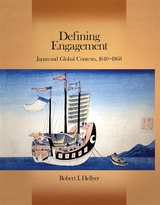 Defining Engagement: Japan and Global Contexts, 1640–1868
Robert I. Hellyer
Harvard University Press, 2009 Presenting fresh insights on the internal dynamics and global contexts that shaped foreign relations in early modern Japan, Robert I. Hellyer challenges the still largely accepted wisdom that the Tokugawa shogunate, guided by an ideology of seclusion, stifled intercourse with the outside world, especially in the eighteenth and nineteenth centuries.
Examining diplomacy, coastal defense, and foreign trade, this study demonstrates that while the shogunate created the broader framework, foreign relations were actually implemented through cooperative but sometimes competitive relationships with the Satsuma and Tsushima domains, which themselves held largely independent ties with neighboring states. Successive Tokugawa leaders also proactively revised foreign trade, especially with China, taking steps that mirrored the commercial stances of other Asian and Western states.
In the nineteenth century, the system of foreign relations continued to evolve, with Satsuma gaining a greater share of foreign trade and Tsushima assuming more responsibility in coastal defense. The two domains subsequently played key roles in Japan’s transition from using early modern East Asian practices of foreign relations to the national adoption of international relations, especially the recasting of foreign trade and the centralization of foreign relations authority, in the years surrounding the Meiji Restoration of 1868.
 Defining Germany: The 1848 Frankfurt Parliamentarians and National Identity
Brian E. Vick
Harvard University Press, 2002 In a unique blend of political, intellectual, and cultural history, Brian Vick explores the world of German nationalism during the first half of the nineteenth century. Vick first presents an original investigation of German conceptions of nationhood in these decades before moving on to analyze the efforts of deputies at the Frankfurt Constituent National Assembly to construct a German national state based on the ethnically diverse German Confederation. He examines debates over fundamental issues that included citizenship qualifications, minority linguistic rights, Jewish emancipation, and territorial disputes, and offers valuable insights into nineteenth-century liberal opinion on the Jewish Question, language policy, and ideas of race.
Contrary to the often invoked dichotomy between cultural and political types of nationalism, in which the German case is usually seen as prototypical of the xenophobic, exclusionary cultural form, this study reveals how German nationalists at Frankfurt interwove cultural and political strands of the national ideal so finely as to sanction equal citizenship status in the proposed state for both the German-Jewish minority and the non-German-speaking nationalities within its boundaries. Yet deputies also contentiously defined Germany's borders so as to incorporate the latter, often unwilling groups, thereby hoping to dominate them both culturally and politically. Conflict was thus as much a part of this "culture of nationhood" as inclusion.
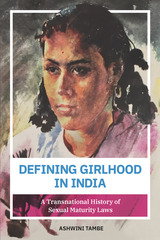 Defining Girlhood in India: A Transnational History of Sexual Maturity Laws
Ashwini Tambe
University of Illinois Press, 2019 At what age do girls gain the maturity to make sexual choices? This question provokes especially vexed debates in India, where early marriage is a widespread practice. India has served as a focal problem site in NGO campaigns and intergovernmental conferences setting age standards for sexual maturity. Over the last century, the country shifted the legal age of marriage from twelve, among the lowest in the world, to eighteen, at the high end of the global spectrum. Ashwini Tambe illuminates the ideas that shaped such shifts: how the concept of adolescence as a sheltered phase led to delaying both marriage and legal adulthood; how the imperative of population control influenced laws on marriage age; and how imperial moral hierarchies between nations provoked defensive postures within India. Tambe takes a transnational feminist approach to legal history, showing how intergovernmental debates influenced Indian laws and how expert discourses in India changed UN terminology about girls. Ultimately, Tambe argues, the well-meaning focus on child marriage has been tethered less to the interests of girls themselves and more to parents’ interests, achieving population control targets, and preserving national reputation.
 Defining Global Justice: History Of Us Int'L Labor Standards Poli
Edward C. Lorenz
University of Notre Dame Press, 2001 Defining Global Justice offers the first comprehensive overview of the history of the United States' role in the International Labor Organization (ILO). In this thought-provoking book, Edward Lorenz reveals why the United States, despite showing exceptional restraint in domestic social policy making, played a leading role in the pursuit of just international labor standards. Lorenz's lucid volume covers a century's worth of efforts, charting the development of a body of international law and an institutional structure as important to the global economy of the twenty-first century as the battle against slavery was in the nineteenth century.
EDWARD C. LORENZ is Reid-Knox Professor of History and Political Science at Alma College.
----------
"This useful review of American attitudes toward international labor standards starts with World War I and the creation of the International Labor Organization (ILO) in 1919. It usefully discusses the movement toward national labor standards within the United States in the 1920s and 1930s, the U.S. failure to ratify many of the ILO conventions, and the divisions within American labor on the ILO." --Foreign Affairs
"Based on an impressive command of a wide variety of sources, this well-organized and clearly written account explains how the social gospel movement, Progressive Era reformers, academics and attorneys, feminists and consumers, and labor unions attempted to shape an international organization that could establish standards to protect workers around the world." --Register of the Kentucky Historical Society
"Defining Global Justice chronicles in an unusual and intriguing way the rise and eventual sequential transformations of the International Labor Organization.... [A] novel and very interesting history of real-life battles regarding international labor standards and an important reminder that within the traditions of our profession there once thrived a strong concern about standards of human dignity." --EH.NET
"This volume is timely. Lorenz provides an insightful history of the US's role in the development of global labor standards through the ILO. This well-written study persuasively demonstrates that ‘well-organized groups can force the policy process to consider values, other than economic efficiency, in setting economic policies.'" --Choice
"Edward C Lorenz's history of American involvement in the movement to establish international labor standards provides a useful look at an understudied subject ... Lorenz's book will be of real help to historians and policy makers working in this area." --Journal of American History
"As the first complete history of the ILO, this book by Edward C. Lorenz is important for its evidence, clear narrative and ... theoretical contribution." --American Historical Review
"This is a thoroughly researched and extremely well-written book on the complex development of global labor standards and the ILO. It should be read urgently by anyone concerned with problems of global justice, and particularly by those who take the view that ‘labor is not merely a commodity.' " --Randolph B. Persuade, Co-Director of the Sub-Field of Comparative and International Race Relations at American University, and Director of American University's Interdisciplinary Council on the Americas
"Professor Lorenz has written an important book that provides an invaluable portrait of the International Labor Organization." --James O. Freedman, President Emeritus, Dartmouth College
"At a time when the stark implications of global capital's drive for globalization and free trade are attracting the urgent attention of labor, consumer, and environmental groups the world over, it is important that we recover the history of earlier campaigners who fought the same struggle to seed economic growth with social justice. Edward Lorenz here begins that task of recovery, skillfully recounting not just the economic logic but also the moral passion that has informed campaigns to remove labor standards from competition, whether interstate, interregional, or international. Lorenz's history gives hope to all those who believe that even the most relentless commodification of labor can be answered by enlightened policy." --Christopher Tomlins, Senior Research Fellow, American Bar Foundation
"Defining Global Justice is a fine piece of historical scholarship that provides readers with a comprehensive overview of a century of labor reform activity." --Ronald Edsforth, Professor of History, Dartmouth College
"...an intriguing story that offers insights into the evolution of international organizations and their ability to define norms of behavior. This is a valuable book in that it carefully and fully lays out the philosophical and legal arguments for labor standards and documents when they have been applied over a long period of history." --The Journal of Economic History
 Defining Latvia: Recent Explorations in History, Culture, and Politics
Matthew Kott
Central European University Press, 2022 In just over a century, Latvia has transitioned from imperial periphery to nation-state, then Soviet republic, and finally following the collapse of the Soviet Union to an independent republic. Defining Latvia brings together the latest research on the multiple social, political, and cultural contexts of Latvia throughout this turbulent period. Its ten chapters are written by leading political scientists, historians, and area studies specialists from across Europe and North America. The volume moves beyond an exclusively political context to incorporate a variety of social and cultural perspectives, ranging from the experiences of Latvian mapmakers in the Russian Empire, to the participation of Latvians in the Wehrmacht and Red Army during World War II, Latvian national communism, and the development of extremist politics following Latvia’s accession to the European Union. Other chapters address developing trends in the fields of history and political science, including the history of antisemitism, memory, language politics, photography, and political extremism. Based on the book’s temporal span from the nineteenth century to the present, the authors and editors of Defining Latvia understand the construction of Latvian identity as a continuous and interconnected process across significant political and ideological ruptures.
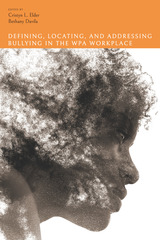 Defining, Locating, and Addressing Bullying in the WPA Workplace
Cristyn L. Elder
Utah State University Press, 2018 Defining, Locating, and Addressing Bullying in the WPA Workplace is the first volume to take up the issue of bullying in writing programs. Contributors to this collection share their personal stories and analyze varieties of collegial malevolence they have experienced as WPAs with consequences in emotional, mental, and physical health and in personal and institutional economies.
Contributors of varying status in different types of programs across many kinds of institutions describe various forms of bullying, including microaggressions, incivility, mobbing, and emotional abuse. They define bullying as institutional racism, “academic systemic incivility,” a crisis of insularity, and faculty fundamentalism. They locate bullying in institutional contexts, including research institutions, small liberal arts colleges, community colleges, and writing programs and writing centers. These locations are used as points of departure to further theorize bullying and to provide clear advice about agentive responses.
A culture of silence discourages discussions of this behavior, making it difficult to address abuse. This silence also normalizes patterns and cultivates the perception that bullying arises naturally. Defining, Locating, and Addressing Bullying in the WPA Workplace helps the field to name these patterns of behaviors as bullying and resist ideologies of normalcy, encouraging and empowering readers to take an active role in defining, locating, and addressing bullying in their own workplaces.
Contributors: Sarah Allen, Andrea Dardello, Harry Denny, Dawn Fels, Bre Garrett, W. Gary Griswold, Amy C. Heckathorn, Aurora Matzke, Staci Perryman-Clark, Sherry Rankins-Robertson, Erec Smith
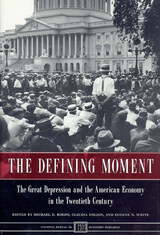 The Defining Moment: The Great Depression and the American Economy in the Twentieth Century
Edited by Michael D. Bordo, Claudia Goldin, and Eugene N. White
University of Chicago Press, 1997 In contemporary American political discourse, issues related to the scope, authority, and the cost of the federal government are perennially at the center of discussion. Any historical analysis of this topic points directly to the Great Depression, the "moment" to which most historians and economists connect the origins of the fiscal, monetary, and social policies that have characterized American government in the second half of the twentieth century. In the most comprehensive collection of essays available on these topics, The Defining Moment poses the question directly: to what extent, if any, was the Depression a watershed period in the history of the American economy? This volume organizes twelve scholars' responses into four categories: fiscal and monetary policies, the economic expansion of government, the innovation and extension of social programs, and the changing international economy. The central focus across the chapters is the well-known alternations to national government during the 1930s. The Defining Moment attempts to evaluate the significance of the past half-century to the American economy, while not omitting reference to the 1930s.
The essays consider whether New Deal-style legislation continues to operate today as originally envisioned, whether it altered government and the economy as substantially as did policies inaugurated during World War II, the 1950s, and the 1960s, and whether the legislation had important precedents before the Depression, specifically during World War I. Some chapters find that, surprisingly, in certain areas such as labor organization, the 1930s responses to the Depression contributed less to lasting change in the economy than a traditional view of the time would suggest. On the whole, however, these essays offer testimony to the Depression's legacy as a "defining moment." The large role of today's government and its methods of intervention—from the pursuit of a more active monetary policy to the maintenance and extension of a wide range of insurance for labor and business—derive from the crisis years of the 1930s.
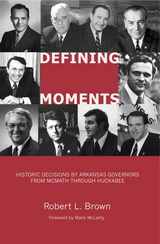 Defining Moments: Historic Decisions by Arkansas Governors from McMath through Huckabee
Robert L. Brown
University of Arkansas Press, 2010 Defining Moments explores how all Arkansas governors since Sid McMath (a group that has produced a president, two U.S. senators, and two presidential contenders) acted in times of crisis. These ten exceptional leaders stand out in Arkansas history and politics for having had their personal and political mettle tested by issues concerning education, the environment, social justice, the conduct of politics, race, and more of the nation's defining debates. The governors and situations covered include Sid McMath's bout with the Dixiecrats; Francis Cherry's ploy to label his opponent a Communist; Orval Faubus's decision to block integration at Little Rock Central High; Winthrop Rockefeller's tribute to Martin Luther King Jr. on the State Capitol steps; Dale Bumpers's battle against political corruption; David Pryor's veto of the U.S. Corps of Engineers's Bell Folley Dam; Frank White's endorsement of Creationism; Bill Clinton's decision to test public school teachers; Jim Guy Tucker's bold solution for the Medicaid program and his resignation; and Mike Huckabee's quest to consolidate the state's high school districts. Robert Brown, who knew nine of the ten governors personally and worked as an aide for Dale Bumpers and Jim Guy Tucker, tells these stories with an unusual combination of historical research and personal familiarity. He crystallizes the difficult choices faced by these memorable leaders, showing how their decisions at crucial points shaped their tenures, molded their legacies for good or bad, and shaped history.
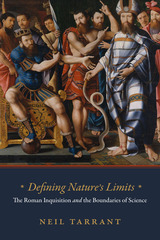 Defining Nature's Limits: The Roman Inquisition and the Boundaries of Science
Neil Tarrant
University of Chicago Press, 2022 A look at the history of censorship, science, and magic from the Middle Ages to the post-Reformation era.
Neil Tarrant challenges conventional thinking by looking at the longer history of censorship, considering a five-hundred-year continuity of goals and methods stretching from the late eleventh century to well into the sixteenth.
Unlike earlier studies, Defining Nature’s Limits engages the history of both learned and popular magic. Tarrant explains how the church developed a program that sought to codify what was proper belief through confession, inquisition, and punishment and prosecuted what they considered superstition or heresy that stretched beyond the boundaries of religion. These efforts were continued by the Roman Inquisition, established in 1542. Although it was designed primarily to combat Protestantism, from the outset the new institution investigated both practitioners of “illicit” magic and inquiries into natural philosophy, delegitimizing certain practices and thus shaping the development of early modern science. Describing the dynamics of censorship that continued well into the post-Reformation era, Defining Nature's Limits is revisionist history that will interest scholars of the history science, the history of magic, and the history of the church alike.
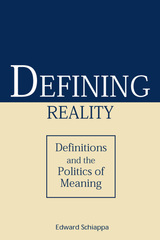 Defining Reality: Definitions and the Politics of Meaning
Edward Schiappa
Southern Illinois University Press, 2003 In Defining Reality, Edward Schiappa argues that definitional disputes should be treated less as philosophical questions of “is”and more as sociopolitical questions of “ought.” Instead of asking “What is X?” he advocates that definitions be considered as proposals for shared knowledge and institutional norms, as in “What should count as X in context Y, given our needs and interests?” Covering a broad scope of argument in rhetorical theory, as well as in legal, medical, scientific, and environmental debates, Schiappa shows the act of defining to be a specialized and learned behavior, and therefore one that can be studied and improved. In response to theories that deem discourse to be persuasive, the author asserts that all discourse is definitive discourse that contributes to our construction of a shared reality. Defining Reality sheds light on our methods of creating common truths through language and argumentation and forces us to reconsider the contexts, limitations, and adaptability of our definitions. Hinging on a synthesis of arguments regarding the significance of definitional practices, the book is bolstered by a series of case studies of debates about rape, euthanasia, abortion, and political and environmental issues. These case studies ground Schiappa’s concepts in reality and delineate the power of public discourse within legal contexts. Ranging widely among disciplines from philosophy and classical philology to constitutional law and cognitive psychology, this study substantially contributes to the scholarship of rhetoric and argumentation, particularly as they function in the realm of public discourse.
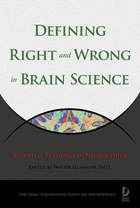 Defining Right and Wrong in Brain Science: Essential Readings in Neuroethics
Edited by Walter Glannon
Dana Press, 2007
Where is the line between instinct and free will in humans? How far can technology and medicine go to manipulate the brain? With every new discovery about the human mind, more and more questions emerge about the boundaries of consciousness, responsibility, and how far neuroscience research can go. The fledgling field of neuroethics has sought answers to these questions since the first formal neuroethics conference was held in 2002. This groundbreaking volume collects the expert and authoritative writings published since then that have laid the groundwork for this rapidly expanding debate.
Defining Right and Wrong in Brain Science traverses the breadth of neuroethics, exploring six broad areas—including free will, moral responsibility, and legal responsibility; psychopharmacology; and brain injury and brain death—in thirty provocative articles. The scientific and ethical consequences of neuroscience research and technology are plumbed by leading thinkers and scientists, from Antonio Damasio’s “The Neural Basics of Social Behavior: Ethical Implications” to “Monitoring and Manipulating Brain Function” by Martha J. Farah and Paul Root Wolpe. These and other in-depth chapters articulate the thought-provoking questions that emerge with every new scientific discovery and propose solutions that mediate between the freedom of scientific endeavor and the boundaries of ethical responsibility.
As science races toward a future that is marked by startling new possibilities for our bodies and minds, Defining Right and Wrong in Brain Science is the definitive assessment of the ethical criteria guiding neuroscientists today.
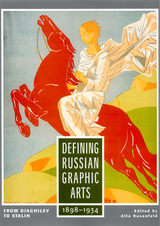 Defining Russian Graphic Arts: From Diaghilev to Stalin, 1898-1934
Rosenfeld, Alla
Rutgers University Press, 1999 Defining Russian Graphic Arts explores the energy and innovation of Russian graphic arts during the period which began with the explosion of artistic creativity initiated by Serge Diaghilev at the end of the nineteenth century and which ended in the mid-1930s with Stalin's devastating control over the arts. This beautifully illustrated book represents the development of Russian graphic arts as a continuum during these forty years, and places Suprematism and Constructivism in the context of the other major, but lesser-known, manifestations of early twentieth-century Russian art. The book includes such diverse categories of graphic arts as lubki (popular prints), posters and book designs, journals, music sheets, and ephemera. It features not only standard types of printed media and related studies and maquettes, but also a number of watercolor and gouache costume and stage designs. About 100 works borrowed from the National Library of Russia and the Research Museum of the Academy of Fine Arts in St. Petersburg, Russia-many seen here for the first time outside of Russia-are featured in this book. Additional works have been drawn from the Zimmerli Art Museum, The New York Public Library, and from other public and private collections. Together they provide a rare opportunity to view and learn about a wide variety of artists, from the acclaimed to the lesser known. This book is a companion volume to an exhibition appearing at the Jane Voorhees Zimmerli Art Museum at Rutgers University.
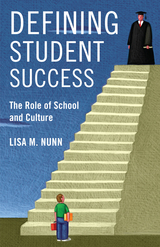 Defining Student Success: The Role of School and Culture
Lisa M. Nunn
Rutgers University Press, 2014 2020 Scholarly Contributions to Teaching and Learning Award from the ASA
The key to success, our culture tells us, is a combination of talent and hard work. Why then, do high schools that supposedly subscribe to this view send students to college at such dramatically different rates? Why do students from one school succeed while students from another struggle? To the usual answer—an imbalance in resources—this book adds a far more subtle and complicated explanation. Defining Student Success shows how different schools foster dissimilar and sometimes conflicting ideas about what it takes to succeed—ideas that do more to preserve the status quo than to promote upward mobility.
Lisa Nunn’s study of three public high schools reveals how students’ beliefs about their own success are shaped by their particular school environment and reinforced by curriculum and teaching practices. While American culture broadly defines success as a product of hard work or talent (at school, intelligence is the talent that matters most), Nunn shows that each school refines and adapts this American cultural wisdom in its own distinct way—reflecting the sensibilities and concerns of the people who inhabit each school. While one school fosters the belief that effort is all it takes to succeed, another fosters the belief that hard work will only get you so far because you have to be smart enough to master course concepts. Ultimately, Nunn argues that these school-level adaptations of cultural ideas about success become invisible advantages and disadvantages for students’ college-going futures. Some schools’ definitions of success match seamlessly with elite college admissions’ definition of the ideal college applicant, while others more closely align with the expectations of middle or low-tier institutions of higher education.
With its insights into the transmission of ideas of success from society to school to student, this provocative work should prompt a reevaluation of the culture of secondary education. Only with a thorough understanding of this process will we ever find more consistent means of inculcating success, by any measure.
Defining Sustainability: Special Issue of Land Economics 73:4 (November 1997)
Edited by Richard B. Howarth
University of Wisconsin Press, 2010 The rising stature of sustainable development constitutes an important and evolving challenge for natural resource and environmental economics. Is sustainability best achieved through the use and extension of conventional criteria for optimal resource allocation? Or does the concept involve a more substantial shift beyond methods such as present-value maximization and nonmarket valuation? At the heart of this challenge lie questions concerning the precise meaning that should be attached to the phrase “sustainable development,” and how this concept may be operationalized in economic theory and applied policy analysis.
Defining Sustainable Forestry
Edited by Greg Aplet, Nels Johnson, Jeffrey T. Olson, and V. Alaric Sample; Foreword by Edward O. Wilson
Island Press, 1993 Before the transition in forestry can be made from conventional approaches of the past century to the ecosystem approach of the next, a consensus must be reached on the meaning of "sustainable forestry." Defining Sustainable Forestry presents the results of a national conference convened by The Wilderness Society, American Forests, and the World Resources Institute to help establish a common framework upon which to guide the future development of forestry.
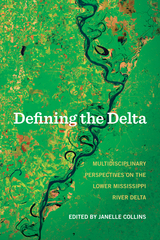 Defining the Delta: Multidisciplinary Perspectives on the Lower Mississippi River Delta
Janelle Collins
University of Arkansas Press, 2015 Inspired by the Arkansas Review’s “What Is the Delta?” series of articles, Defining the Delta collects fifteen essays from scholars in the sciences, social sciences, and humanities to describe and define this important region.
Here are essays examining the Delta’s physical properties, boundaries, and climate from a geologist, archeologist, and environmental historian. The Delta is also viewed through the lens of the social sciences and humanities—historians, folklorists, and others studying the connection between the land and its people, in particular the importance of agriculture and the culture of the area, especially music, literature, and food.
Every turn of the page reveals another way of seeing the seven-state region that is bisected by and dependent on the Mississippi River, suggesting ultimately that there are myriad ways of looking at, and defining, the Delta.
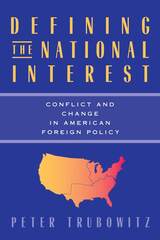 Defining the National Interest: Conflict and Change in American Foreign Policy
Peter Trubowitz
University of Chicago Press, 1998 The United States has been marked by a highly politicized and divisive history of foreign policy-making. Why do the nation's leaders find it so difficult to define the national interest?
Peter Trubowitz offers a new and compelling conception of American foreign policy and the domestic geopolitical forces that shape and animate it. Foreign policy conflict, he argues, is grounded in America's regional diversity. The uneven nature of America's integration into the world economy has made regionalism a potent force shaping fights over the national interest. As Trubowitz shows, politicians from different parts of the country have consistently sought to equate their region's interests with that of the nation. Domestic conflict over how to define the "national interest" is the result. Challenging dominant accounts of American foreign policy-making, Defining the National Interest exemplifies how interdisciplinary scholarship can yield a deeper understanding of the connections between domestic and international change in an era of globalization.
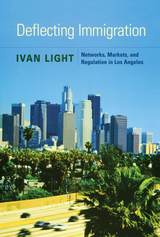 Deflecting Immigration: Networks, Markets, and Regulation in Los Angeles
Ivan Light
Russell Sage Foundation, 2006 As international travel became cheaper and national economies grew more connected over the past thirty years, millions of people from the Third World emigrated to richer countries. A tenth of the population of Mexico relocated to the United States between 1980 and 2000. Globalization theorists claimed that reception cities could do nothing about this trend, since nations make immigration policy, not cities. In Deflecting Immigration, sociologist Ivan Light shows how Los Angeles reduced the sustained, high-volume influx of poor Latinos who settled there by deflecting a portion of the migration to other cities in the United States. In this manner, Los Angeles tamed globalization's local impact, and helped to nationalize what had been a regional immigration issue. Los Angeles deflected immigration elsewhere in two ways. First, the protracted network-driven settlement of Mexicans naturally drove up rents in Mexican neighborhoods while reducing immigrants' wages, rendering Los Angeles a less attractive place to settle. Second, as migration outstripped the city's capacity to absorb newcomers, Los Angeles gradually became poverty-intolerant. By enforcing existing industrial, occupational, and housing ordinances, Los Angeles shut down some unwanted sweatshops and reduced slums. Their loss reduced the metropolitan region's accessibility to poor immigrants without reducing its attractiveness to wealthier immigrants. Additionally, ordinances mandating that homes be built on minimum-sized plots of land with attached garages made home ownership in L.A.'s suburbs unaffordable for poor immigrants and prevented low-cost rental housing from being built. Local rules concerning home occupancy and yard maintenance also prevented poor immigrants from crowding together to share housing costs. Unable to find affordable housing or low-wage jobs, approximately one million Latinos were deflected from Los Angeles between 1980 and 2000. The realities of a new global economy are still unfolding, with uncertain consequences for the future of advanced societies, but mass migration from the Third World is unlikely to stop in the next generation. Deflecting Immigration offers a shrewd analysis of how America's largest immigrant destination independently managed the challenges posed by millions of poor immigrants and, in the process, helped focus attention on immigration as an issue of national importance.
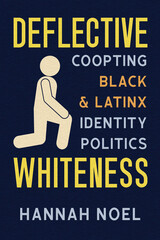 Deflective Whiteness: Co-Opting Black and Latinx Identity Politics
Hannah Noel
Ohio State University Press, 2022 In Deflective Whiteness, Hannah Noel repositions Whiteness studies in relation to current discussions around racialized animus and White victimhood, demonstrating how White supremacy adapts its discursive strategies by cannibalizing the language and rhetoric of Black and Latinx social justice movements. Analyzing a wide-ranging collection of cultural objects—memes, oration, music, advertisements, and news coverage—Noel shows how White deflection sustains and reproduces structures of inequality and injustice. White deflection offers a script for how social justice rhetoric and the emotions of victimization are appropriated to conjure a hegemonic White identity. Using derivative language, deflection claims Whiteness as the aggrieved social status. Through case studies of cultural moments and archives including Twitter, country music, the Black Lives Matter movement, and more, Deflective Whiteness exposes the various forms of tacit White supremacy that operate under the alibi of injury and that ultimately serve to deepen racial inequities. By understanding how, where, and why White deflection is used, Noel argues, scholars and social justice advocates can trace, tag, and deconstruct covert White supremacy at its rhetorical foundations.
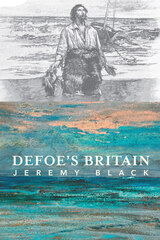 Defoe's Britain
jeremy black
St. Augustine's Press, 2023 The Weight of Words Series continues with Daniel Defoe, as historian Jeremy Black uses this writer to interpret Britain in the late 1600s, and likewise looks to the times to interpret the fiction. As seen in previous studies on Christie, Smollett, Fielding, and the Gothic novelists, Black tells the story of the story-teller, and presents the picture of British nationalism that "was the product, history, and record of struggle––collective and individual––as well as its defence. Defoe provides particular accounts of this struggle, both in foreign seas and lands, and at home. This struggle had a moral character that is difficult to capture today."
Defoe was an outsider, a man of many interests whom Black asserts evades too precise a portrait or coherent description of character and career. But he is a traveler, in the literal and imaginative senses, and in his engagement with life and its issues and willingness to associate with 'low-life' prefigures later literary giants like Smollett and Fielding. More than the establishment of genre, Defoe created the writer "whose business is observation." Black's account of this parcel of the British past is impeccable because it is in fact an account that the past, in Defoe, gives of itself. "As a writer, Defoe brought together a reality usually presented as, and endorsed by, history, with the imaginative focus of storytelling, and the direction of, variously, propaganda, analysis, and exemplary tale."
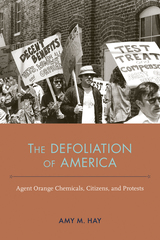 The Defoliation of America: Agent Orange Chemicals, Citizens, and Protests
Amy M. Hay
University of Alabama Press, 2022 Examines the domestic and international use of phenoxy herbicides by the United States in the mid-twentieth century
In The Defoliation of America: Agent Orange Chemicals, Citizens, and Protests, Amy M. Hay profiles the attitudes, understandings, and motivations of grassroots activists who rose to fight the use of phenoxy herbicides, or Agent Orange chemicals as they are commonly known, in various aspects of American life during the post-WWII era. Hay focuses her analysis on citizen responses to illuminate how regulatory policies were understood, challenged, and negotiated, contributing to a growing body of research on chemical regulatory policies, risk society, and hazardous chemicals. This volume uncovers new understandings about the authority of the state and its obligation to society, the role of scientific authority and expertise, and the protests made by various groups of citizens.
First introduced in 1946, phenoxy herbicides mimic hormones in broadleaf plants, causing them to “grow to death” while grass, grains, and other monocots remain unaffected. By the 1950s, millions of pounds of these chemicals were produced annually for use in brush control, weed eradication, forest management, and other agricultural applications. Pockets of skepticism and resistance began to appear by the late 1950s, and the trend intensified after 1962 when Rachel Carson’s Silent Spring directed mainstream attention to the harm modern chemicals were causing in the natural world. It wasn’t until the Vietnam War, however, when nearly 19 million gallons of Agent Orange and related herbicides were sprayed to clear the canopy and destroy crops in Southeast Asia, that the long-term damage associated with this group of chemicals began to attract widespread attention and alarm.
Using a wide array of sources and an interdisciplinary approach, Hay contributes to the robust fields of chemical toxicity, regulation, environmental management, and public health. This study of the scientists, health and environmental activists, and veterans who fought US chemical regulatory policies and practices reveals the mechanisms, obligations, and constraints of state and scientific authority in mid-twentieth-century America. Hay also shows how these disparate and mostly forgotten citizen groups challenged the political consensus and contested government and industry narratives of chemical safety.
Deforestation in the Postwar Philippines
David M. Kummer
University of Chicago Press, 1992 The only quantitative deforestation study to focus on one country, this case analysis of the Philippines since 1946 yields more concrete data than previous cross-national studies. David Kummer's close examination of the interactions among political, economic, and cultural factors and their environmental consequences sheds light on similar situations in other countries.
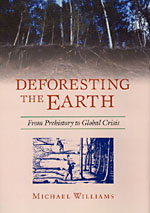 Deforesting the Earth: From Prehistory to Global Crisis
Michael Williams
University of Chicago Press, 2002 Since humans first appeared on the earth, we've been cutting down trees for fuel and shelter. Indeed, the thinning, changing, and wholesale clearing of forests are among the most important ways humans have transformed the global environment. With the onset of industrialization and colonization the process has accelerated, as agriculture, metal smelting, trade, war, territorial expansion, and even cultural aversion to forests have all taken their toll.
Michael Williams surveys ten thousand years of history to trace how, why, and when human-induced deforestation has shaped economies, societies, and landscapes around the world. Beginning with the return of the forests to Europe, North America, and the tropics after the Ice Ages, Williams traces the impact of human-set fires for gathering and hunting, land clearing for agriculture, and other activities from the Paleolithic through the classical world and the Middle Ages. He then continues the story from the 1500s to the early 1900s, focusing on forest clearing both within Europe and by European imperialists and industrialists abroad, in such places as the New World and India, China, Japan, and Latin America. Finally, he covers the present-day and alarming escalation of deforestation, with the ever-increasing human population placing a possibly unsupportable burden on the world's forests.
Accessible and nonsensationalist, Deforesting the Earth provides the historical and geographical background we need for a deeper understanding of deforestation's tremendous impact on the environment and the people who inhabit it.
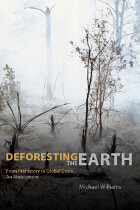 Deforesting the Earth: From Prehistory to Global Crisis, An Abridgment
Michael Williams
University of Chicago Press, 2006 “Anyone who doubts the power of history to inform the present should read this closely argued and sweeping survey. This is rich, timely, and sobering historical fare written in a measured, non-sensationalist style by a master of his craft. One only hopes (almost certainly vainly) that today’s policymakers take its lessons to heart.”—Brian Fagan, Los Angeles Times
Published in 2002, Deforesting the Earth was a landmark study of the history and geography of deforestation. Now available as an abridgment, this edition retains the breadth of the original while rendering its arguments accessible to a general readership.
Deforestation—the thinning, changing, and wholesale clearing of forests for fuel, shelter, and agriculture—is among the most important ways humans have transformed the environment. Surveying ten thousand years to trace human-induced deforestation’s effect on economies, societies, and landscapes around the world, Deforesting the Earth is the preeminent history of this process and its consequences.
Beginning with the return of the forests after the ice age to Europe, North America, and the tropics, Michael Williams traces the impact of human-set fires for gathering and hunting, land clearing for agriculture, and other activities from the Paleolithic age through the classical world and the medieval period. He then focuses on forest clearing both within Europe and by European imperialists and industrialists abroad, from the 1500s to the early 1900s, in such places as the New World, India, and Latin America, and considers indigenous clearing in India, China, and Japan. Finally, he covers the current alarming escalation of deforestation, with our ever-increasing human population placing a potentially unsupportable burden on the world’s forests.
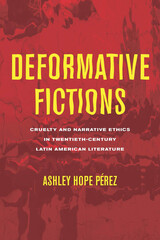 Deformative Fictions: Cruelty and Narrative Ethics in Twentieth-Century Latin American Literature
Ashley Hope Pérez
Ohio State University Press, 2024 Tapping a rich vein of Latin American literature, Deformative Fictions by Ashley Hope Pérez excavates works that unsettle, defamiliarize, and disrupt access to the conventional pleasures of reading and interpretation. Close readings highlight the nuances of texts that have been misread, underread, or fetishized because they depart from literary norms, including fiction by Roberto Bolaño and Silvina Ocampo. Interweaving rhetorical and narratological analysis with reflections on the ethical stakes of writing, reading, and interpreting deformative fictions and fictional cruelty, Pérez issues a resounding entreaty for us to expand our understandings of the value of narrative beyond the logics of utility and comfort. Doing so, she contends, allows readers to embrace the full possibilities of the relationships among authors, readers, and the worlds we inhabit on and off the page. In defamiliarizing the act of reading, deformative fictions reacquaint us with its ethical weight.
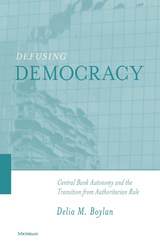 Defusing Democracy: Central Bank Autonomy and the Transition from Authoritarian Rule
Delia M. Boylan
University of Michigan Press, 2001 Many of today's new democracies are constrained by institutional forms designed by previous authoritarian rulers. In this timely and provocative study, Delia M. Boylan traces the emergence of these vestigial governance structures to strategic behavior by outgoing elites seeking to protect their interests from the vicissitudes of democratic rule.
One important outgrowth of this political insulation strategy--and the empirical centerpiece of Boylan's analysis--is the existence of new, highly independent central banks in countries throughout the developing world. This represents a striking transformation, for not only does central bank autonomy remove a key aspect of economic decision making from democratic control; in practice it has also kept many of the would-be expansionist governments that hold power today from overturning the neoliberal policies favored by authoritarian predecessors.
To illustrate these points, Defusing Democracy takes a fresh look at two transitional polities in Latin America--Chile and Mexico--where variation in the proximity of the democratic "threat" correspondingly yielded different levels of central bank autonomy.
Boylan concludes by extending her analysis to institutional contexts beyond Latin America and to insulation strategies other than central bank autonomy. Defusing Democracy will be of interest to anyone--political scientists, economists, and policymakers alike--concerned about the genesis and consolidation of democracy around the globe.
Delia M. Boylan is Assistant Professor, Harris Graduate School of Public Policy Studies, University of Chicago.
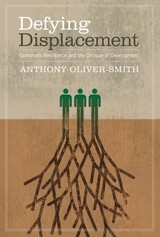 Defying Displacement: Grassroots Resistance and the Critique of Development
By Anthony Oliver-Smith
University of Texas Press, 2010 The uprooting and displacement of people has long been among the hardships associated with development and modernity. Indeed, the circulation of commodities, currency, and labor in modern society necessitates both social and spatial mobility. However, the displacement and resettlement of millions of people each year by large-scale infrastructural projects raises serious questions about the democratic character of the development process. Although designed to spur economic growth, many of these projects leave local people struggling against serious impoverishment and gross violations of human rights. Working from a political-ecological perspective, Anthony Oliver-Smith offers the first book to document the fight against involuntary displacement and resettlement being waged by people and communities around the world. Increasingly over the last twenty-five years, the voices of people at the grass roots are being heard. People from many societies and cultures are taking action against development-forced displacement and resettlement (DFDR) and articulating alternatives. Taking the promise of democracy seriously, they are fighting not only for their place in the world, but also for their place at the negotiating table, where decisions affecting their well-being are made.
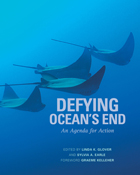 Defying Ocean's End: An Agenda For Action
Edited by Sylvia Earle and Linda Glover
Island Press, 2004 If humankind were given a mandate to do everything in our power to undermine the earth's functioning, we could hardly do a better job than we have in the past thirty years on the world's oceans, both by what we are putting into it-millions of tons of trash and toxic materials-and by what we are taking out of it-millions of tons of wildlife. Yet only recently have we begun to understand the scale of those impacts. Defying Ocean's End is the result of an unprecedented effort among the world's largest environmental organizations, scientists, the business community, media, and international governments to address these marine issues. In June 2003, in the culmination of a year-long effort, they met specifically to develop a comprehensive and achievable agenda to reverse the decline in health of the world's oceans. As conservation organizations begin to expand their focus from land issues to include a major focus on preservation of the sea, it is increasingly apparent that we have to approach marine conservation differently and at much larger scale than we have to date. What's also clear is the magnitude and immediacy of the growing ocean concerns are such that no one organization can handle the job alone. Defying Ocean's End is a bold step in bringing the resources needed to bear on this vast problem before it is too late. It offers a broad strategy, a practical plan with priorities and costs, aimed at mobilizing the forces needed to bring about a "sea change" of favorable attitudes, actions, and outcomes for the oceans-and for all of us.
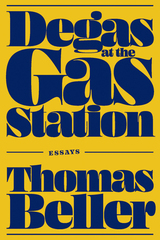 Degas at the Gas Station: Essays
Thomas Beller
Duke University Press, 2025 In his latest collection, Thomas Beller trains his piercing literary eye on how a single, seismic event indelibly shapes the trajectory of the common and mundane experiences of one’s life. Weaving together a charming set of autobiographical stories, Beller interrogates the randomness and contingencies that separate sadness from joy, death from life. His father escaped the Nazis, only to die in America from cancer when Beller was nine years old. Beller measures how this loss impacted his life as the father of two young children and became both a catalyst for understanding an ever-present sorrow. At the same time, ordinary moments—from retrieving an iPod from the subway tracks to encountering the police at a Kinks concert to observing his young tutued ballerina daughter at a gas station—lead to instances of penetrating insight, self-deprecation, and humor. Degas at the Gas Station presents an endearing and bracingly honest portrait of the author as an ever-curious observer of the mysteries and profundities of everyday life.
Degas: The Artist’s Mind
Theodore Reff
Harvard University Press, 1987 More than any other Impressionist, Degas consciously based his work on ideas. “What I do is the result of reflection and study of the great masters,” he once confessed; “of inspiration, spontaneity, temperament I know nothing.” Theodore Reff here shows us the intellectual power and originality of Degas’s complex art—as seen in his ingenious pictorial strategies and technical innovations; his use of motifs like the window, the mirror, the picture within the picture; his invention of striking, psychologically compelling compositions; and his creation of a sculptural idiom at once formal and vernacular. These essays also investigate Degas’s contacts with leading novelists and poets of his time and his efforts to illustrate or draw inspiration from their works.
 Degenerations of Democracy
Craig Calhoun, Dilip Parameshwar Gaonkar, and Charles Taylor
Harvard University Press, 2022 Three leading thinkers analyze the erosion of democracy’s social foundations and call for a movement to reduce inequality, strengthen inclusive solidarity, empower citizens, and reclaim pursuit of the public good.
Democracy is in trouble. Populism is a common scapegoat but not the root cause. More basic are social and economic transformations eroding the foundations of democracy, ruling elites trying to lock in their own privilege, and cultural perversions like making individualistic freedom the enemy of democracy’s other crucial ideals of equality and solidarity. In Degenerations of Democracy three of our most prominent intellectuals investigate democracy gone awry, locate our points of fracture, and suggest paths to democratic renewal.
In Charles Taylor’s phrase, democracy is a process, not an end state. Taylor documents creeping disempowerment of citizens, failures of inclusion, and widespread efforts to suppress democratic participation, and he calls for renewing community. Craig Calhoun explores the impact of disruption, inequality, and transformation in democracy’s social foundations. He reminds us that democracies depend on republican constitutions as well as popular will, and that solidarity and voice must be achieved at large scales as well as locally.
Taylor and Calhoun together examine how ideals like meritocracy and authenticity have become problems for equality and solidarity, the need for stronger articulation of the idea of public good, and the challenges of thinking big without always thinking centralization.
Dilip Parameshwar Gaonkar points out that even well-designed institutions will not integrate everyone, and inequality and precarity make matters worse. He calls for democracies to be prepared for violence and disorder at their margins—and to treat them with justice, not oppression.
The authors call for bold action building on projects like Black Lives Matter and the Green New Deal. Policy is not enough to save democracy; it will take movements.
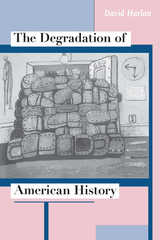 The Degradation of American History
David Harlan
University of Chicago Press, 1997 American historical writing has traditionally been one of our primary forms of moral reflection. However, David Harlan argues that in the disillusionment following the 1960s, history abandoned its redemptive potential and took up the methodology of the social sciences. In this provocative new book, Harlan describes the reasons for this turn to objectivity and professionalism, explains why it failed, and examines the emergence of a New Traditionalism in American historical writing.
Part One, "The Legacy of the Sixties," describes the impact of literary theory in the 1970s and beyond, the rise of women's history, the various forms of ideological analysis developed by historians on the left, and the crippling obsession with professionalism in the 1980s. Part Two, "The Renewal of American Historical Writing," focuses on the contributions of John Patrick Diggins, Hayden White, Richard Rorty, Elaine Showalter, Henry Louis Gates Jr., and others. Harlan argues that at the end of the twentieth century American historical writing is perfectly poised to become what it once was: not one of the social sciences in historical costume, but a form of moral reflection that speaks to all Americans.
"[A] wholly admirable work. This book will be talked about for years."—Library Journal
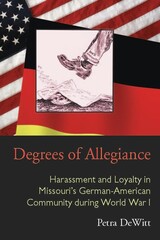 Degrees of Allegiance: Harassment and Loyalty in Missouri’s German-American Community during World War I
Petra DeWitt
Ohio University Press, 2012 Historians have long argued that the Great War eradicated German culture from American soil. Degrees of Allegiance examines the experiences of German-Americans living in Missouri during the First World War, evaluating the personal relationships at the local level that shaped their lives and the way that they were affected by national war effort guidelines. Spared from widespread hate crimes, German-Americans in Missouri did not have the same bleak experiences as other German-Americans in the Midwest or across America. But they were still subject to regular charges of disloyalty, sometimes because of conflicts within the German-American community itself. Degrees of Allegiance updates traditional thinking about the German-American experience during the Great War, taking into account not just the war years but also the history of German settlement and the war’s impact on German-American culture.
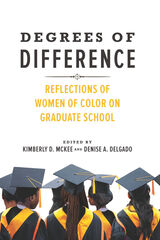 Degrees of Difference: Reflections of Women of Color on Graduate School
Edited by Kimberly D. McKee and Denise A. Delgado
University of Illinois Press, 2020 University commitments to diversity and inclusivity have yet to translate into support for women of color graduate students. Sexism, classism, homophobia, racial microaggressions, alienation, disillusionment, a lack of institutional and departmental support, limited help from family and partners, imposter syndrome, narrow reading lists—all remain commonplace. Indifference to the struggles of women of color in graduate school and widespread dismissal of their work further poisons an atmosphere that suffocates not only ambition but a person's quality of life. In Degrees of Difference, women of color from diverse backgrounds give frank, unapologetic accounts of their battles—both internal and external—to navigate grad school and fulfill their ambitions. At the same time, the authors offer strategies for surviving the grind via stories of their own hard-won successes with self-care, building supportive communities, finding like-minded mentors, and resisting racism and unsupportive faculty and colleagues. Contributors: Aeriel A. Ashlee, Denise A. Delgado, Nwadiogo I. Ejiogu, Delia Fernández, Regina Emily Idoate, Karen J. Leong, Kimberly D. McKee, Délice Mugabo, Carrie Sampson, Arianna Taboada, Jenny Heijun Wills, and Soha Youssef
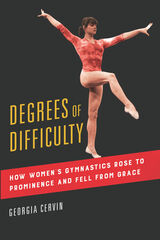 Degrees of Difficulty: How Women's Gymnastics Rose to Prominence and Fell from Grace
Georgia Cervin
University of Illinois Press, 2021 How the Cold War era changed the trajectory of women's gymnastics Electrifying athletes like Olga Korbut and Nadia Comăneci helped make women’s artistic gymnastics one of the most popular events in the Olympic Games. But the transition of gymnastics from a women’s sport to a girl’s sport in the 1970s also laid the foundation for a system of emotional, physical, and sexual abuse of gymnasts around the world. Georgia Cervin offers a unique history of women's gymnastics, examining how the high-stakes diplomatic rivalry of the Cold War created a breeding ground for exploitation. Yet, a surprising spirit of international collaboration arose to decide the social values and image of femininity demonstrated by the sport. Cervin also charts the changes in style, equipment, training, and participants that transformed the sport, as explosive athleticism replaced balletic grace and gymnastics dominance shifted from East to West. Sweeping and revelatory, Degrees of Difficulty tells a story of international friction, unexpected cooperation, and the legacy of abuse and betrayal created by the win-at-all-cost attitudes of the Cold War.
 Degrees of Freedom: Louisiana and Cuba after Slavery
Rebecca J. Scott
Harvard University Press, 2008 As Louisiana and Cuba emerged from slavery in the late nineteenth century, each faced the question of what rights former slaves could claim. Degrees of Freedom compares and contrasts these two societies in which slavery was destroyed by war, and citizenship was redefined through social and political upheaval. Both Louisiana and Cuba were rich in sugar plantations that depended on an enslaved labor force. After abolition, on both sides of the Gulf of Mexico, ordinary people—cane cutters and cigar workers, laundresses and labor organizers—forged alliances to protect and expand the freedoms they had won. But by the beginning of the twentieth century, Louisiana and Cuba diverged sharply in the meanings attributed to race and color in public life, and in the boundaries placed on citizenship.
Louisiana had taken the path of disenfranchisement and state-mandated racial segregation; Cuba had enacted universal manhood suffrage and had seen the emergence of a transracial conception of the nation. What might explain these differences?
Moving through the cane fields, small farms, and cities of Louisiana and Cuba, Rebecca Scott skillfully observes the people, places, legislation, and leadership that shaped how these societies adjusted to the abolition of slavery. The two distinctive worlds also come together, as Cuban exiles take refuge in New Orleans in the 1880s, and black soldiers from Louisiana garrison small towns in eastern Cuba during the 1899 U.S. military occupation.
Crafting her narrative from the words and deeds of the actors themselves, Scott brings to life the historical drama of race and citizenship in postemancipation societies.
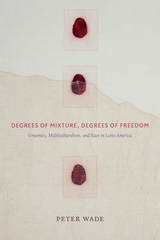 Degrees of Mixture, Degrees of Freedom: Genomics, Multiculturalism, and Race in Latin America
Peter Wade
Duke University Press, 2017 Race mixture, or mestizaje, has played a critical role in the history, culture, and politics of Latin America. In Degrees of Mixture, Degrees of Freedom, Peter Wade draws on a multidisciplinary research study in Mexico, Brazil, and Colombia. He shows how Latin American elites and outside observers have emphasized mixture's democratizing potential, depicting it as a useful resource for addressing problems of racism (claiming that race mixture undoes racial difference and hierarchy), while Latin American scientists participate in this narrative with claims that genetic studies of mestizos can help isolate genetic contributors to diabetes and obesity and improve health for all. Wade argues that, in the process, genomics produces biologized versions of racialized difference within the nation and the region, but a comparative approach nuances the simple idea that highly racialized societies give rise to highly racialized genomics. Wade examines the tensions between mixture and purity, and between equality and hierarchy in liberal political orders, exploring how ideas and scientific data about genetic mixture are produced and circulate through complex networks.
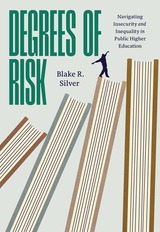 Degrees of Risk: Navigating Insecurity and Inequality in Public Higher Education
Blake R. Silver
University of Chicago Press, 2024 An ethnographic analysis of how insecurity is at the heart of contemporary higher education.
Institutions of higher education are often described as “ivory towers,” places of privilege where students exist in a “campus bubble,” insulated from the trials of the outside world. These metaphors reveal a widespread belief that college provides young people with stability and keeps insecurity at bay. But for many students, that’s simply not the case.
Degrees of Risk reveals how insecurity permeates every facet of college life for students at public universities. Sociologist Blake Silver dissects how these institutions play a direct role in perpetuating uncertainty, instability, individualism, and anxiety about the future. Silver examined interviews with more than one hundred students who described the risks that surrounded every decision: which major to choose, whether to take online classes, and how to find funding. He expertly identified the ways the college experience played out differently for students from different backgrounds. For students from financially secure families with knowledge of how college works, all the choices and flexibility of college felt like an adventure or a wealth of opportunities. But for many others, especially low-income, first-generation students, their personal and family circumstances meant that that flexibility felt like murkiness and precarity. In addition, he discovered that students managed insecurity in very different ways, intensifying inequality at the intersections of socioeconomic status, race, gender, and other sociodemographic dimensions. Drawing from these firsthand accounts, Degrees of Risk presents a model for a better university, one that fosters success and confidence for a diverse range of students.
 Degrees of Risk: Navigating Insecurity and Inequality in Public Higher Education
Blake R. Silver
University of Chicago Press, 2024 This is an auto-narrated audiobook version of this book.
An ethnographic analysis of how insecurity is at the heart of contemporary higher education.
Institutions of higher education are often described as “ivory towers,” places of privilege where students exist in a “campus bubble,” insulated from the trials of the outside world. These metaphors reveal a widespread belief that college provides young people with stability and keeps insecurity at bay. But for many students, that’s simply not the case.
Degrees of Risk reveals how insecurity permeates every facet of college life for students at public universities. Sociologist Blake Silver dissects how these institutions play a direct role in perpetuating uncertainty, instability, individualism, and anxiety about the future. Silver examined interviews with more than one hundred students who described the risks that surrounded every decision: which major to choose, whether to take online classes, and how to find funding. He expertly identified the ways the college experience played out differently for students from different backgrounds. For students from financially secure families with knowledge of how college works, all the choices and flexibility of college felt like an adventure or a wealth of opportunities. But for many others, especially low-income, first-generation students, their personal and family circumstances meant that that flexibility felt like murkiness and precarity. In addition, he discovered that students managed insecurity in very different ways, intensifying inequality at the intersections of socioeconomic status, race, gender, and other sociodemographic dimensions. Drawing from these firsthand accounts, Degrees of Risk presents a model for a better university, one that fosters success and confidence for a diverse range of students.
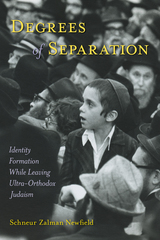 Degrees of Separation: Identity Formation While Leaving Ultra-Orthodox Judaism
Schneur Zalman Newfield
Temple University Press, 2020 Those who exit a religion—particularly one they were born and raised in—often find themselves at sea in their efforts to transition to life beyond their community. In Degrees of Separation, Schneur Zalman Newfield, who went through this process himself, interviews seventy-four Lubavitch and Satmar ultra-Orthodox Hasidic Jews who left their communities.He presents their motivations for leaving as well as how they make sense of their experiences and their processes of exiting, detailing their attitudes and opinions regarding their religious upbringing. Newfield also examines how these exiters forge new ways of being that their upbringing had not prepared them for, while also considering what these particular individuals lose and retain in the exit process. Degrees of Separation presents a comprehensive portrait of the prolonged state of being “in-between” that characterizes transition out of a totalizing worldview. What Newfield discovers is that exiters experience both a sense of independence and a persistent connection; they are not completely dislocated from their roots once they “arrive” at their new destination. Moreover, Degrees of Separation shows that this process of transitioning identity has implications beyond religion.
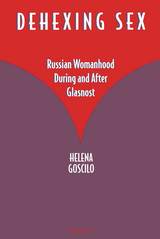 Dehexing Sex: Russian Womanhood During and After Glasnost
Helena Goscilo
University of Michigan Press, 1996 Glasnost and the collapse of the Soviet Union revolutionized Russian society. What effects, however, did they have on the status, role, and image of women in Russian culture? Examining the past turbulent decade of transition to "democracy" and a market economy, Dehexing Sex traces the ways in which Russia's concept of womanhood both changed and remained the same, taking into account dominant ideologies and social philosophies, sociopolitical organizations, women's writings, literary criticism, film, and popular cultural forms such as pornography. The lively, engaging chapters of this book examine texts by contemporary women writers in the context of the political, social, economic, biological, psychological, and aesthetic transformations that helped define them. Goscilo reveals that the Russian cultural revolution has reshaped the female image in varied and often contradictory ways. While increased interaction with the West fostered gender awareness, it also introduced imported Western sexist practices--especially the exploitation of female bodies--formerly proscribed by a puritanical censorship. Popular magazines, newspapers, and television propagated the image of woman as mother, ornament, and sexual object, even as women's fiction conceived of womanhood in complex psychological terms that undermined the gender stereotypes which had ruled Soviet thinking for more than 70 years. With the aid of feminist and cultural theory, Dehexing Sex investigates the overt and internalized misogyny that combined with the genuinely liberalizing forces unleashed by Gorbachev's policy of glasnost and perestroika. It exposes Russia's repressive romance with womanhood as a metaphor for nationhood and explores Russian women's ironic recasting of national mythologies. "Impressive . . . an important contribution to Russian studies and to women's studies. The author is an outstanding scholar, an energetic and original thinker, and her writing sparkles with imagination and wit." --Stephanie Sandler, Amherst College Helena Goscilo is Associate Professor and Chair of Slavic Languages and Literatures, University of Pittsburgh.
Deification in the Latin Patristic Tradition
Jared Ortiz
Catholic University of America Press, 2019 It has become a commonplace to say that the Latin Fathers did not really hold a doctrine of deification. Indeed, it is often asserted that Western theologians have neglected this teaching, that their occasional references to it are borrowed from the Greeks, and that the Latins have generally reduced the rich biblical and Greek Patristic understanding of salvation to a narrow view of redemption. The essays in this volume challenge this common interpretation by exploring, often for the first time, the role this doctrine plays in a range of Latin Patristic authors.
 The Deipnosophists, Volume III: Books 6-7
Athenaeus
Harvard University Press Athenaeus (ca. 170ca. 230 CE), a Greek of Naucratis in Egypt, lived in Rome and wrote a historical work now lost. Of the fifteen books of his surviving Deipnosophists ('Sophists at Dinner'), the first two and parts of the third, eleventh, and fifteenth exist only in summary, the rest apparently complete. In it he pretends to tell a friend about a banquet at a scholar's house whither the learned guests brought extracts from poetry for recitation and discussion. Much of the matter however concerns the food provided and accessories. One learns about cooks, strange dishes, wines, menu cards, and countless other matters. Athenaeus was an antiquarian. The whole work, which mentions nearly eight hundred writers and two thousand five hundred writings, is a large treasury of information not only about table matters but also music, dances, games, and all sorts of literary subjects. And it abounds in quotations, mostly made direct by Athenaeus himself, from authors whose writings have not survived.
The Loeb Classical Library edition of The Deipnosophists is in seven volumes. There is a comprehensive index in the final volume.
 The Deipnosophists, Volume IV: Books 8-10
Athenaeus
Harvard University Press Athenaeus (ca. 170ca. 230 CE), a Greek of Naucratis in Egypt, lived in Rome and wrote a historical work now lost. Of the fifteen books of his surviving Deipnosophists ('Sophists at Dinner'), the first two and parts of the third, eleventh, and fifteenth exist only in summary, the rest apparently complete. In it he pretends to tell a friend about a banquet at a scholar's house whither the learned guests brought extracts from poetry for recitation and discussion. Much of the matter however concerns the food provided and accessories. One learns about cooks, strange dishes, wines, menu cards, and countless other matters. Athenaeus was an antiquarian. The whole work, which mentions nearly eight hundred writers and two thousand five hundred writings, is a large treasury of information not only about table matters but also music, dances, games, and all sorts of literary subjects. And it abounds in quotations, mostly made direct by Athenaeus himself, from authors whose writings have not survived.
The Loeb Classical Library edition of The Deipnosophists is in seven volumes. There is a comprehensive index in the final volume.
 The Deipnosophists, Volume V: Books 11-12
Athenaeus
Harvard University Press Athenaeus (ca. 170ca. 230 CE), a Greek of Naucratis in Egypt, lived in Rome and wrote a historical work now lost. Of the fifteen books of his surviving Deipnosophists ('Sophists at Dinner'), the first two and parts of the third, eleventh, and fifteenth exist only in summary, the rest apparently complete. In it he pretends to tell a friend about a banquet at a scholar's house whither the learned guests brought extracts from poetry for recitation and discussion. Much of the matter however concerns the food provided and accessories. One learns about cooks, strange dishes, wines, menu cards, and countless other matters. Athenaeus was an antiquarian. The whole work, which mentions nearly eight hundred writers and two thousand five hundred writings, is a large treasury of information not only about table matters but also music, dances, games, and all sorts of literary subjects. And it abounds in quotations, mostly made direct by Athenaeus himself, from authors whose writings have not survived.
The Loeb Classical Library edition of The Deipnosophists is in seven volumes. There is a comprehensive index in the final volume.
|
|

